Connect with us

How to choose the best presentation color schemes & combinations
Present better.
- Flat Design
- Minimalist Design
- Colorful, Bright, and Bold Design
- Infographic-Style Slides in Presentations
- Bold Typography Design

When designing a presentation, or even just experimenting with design, you'd be surprised at the different color combinations you can create. Choosing a color scheme is tricky, but understanding the basics of color theory allows… ... read more When designing a presentation, or even just experimenting with design, you'd be surprised at the different color combinations you can create. Choosing a color scheme is tricky, but understanding the basics of color theory allows you to develop the perfect color palette for your presentation. close
Selecting a color scheme that stirs the desired reaction in your audience is a tricky and challenging process. Unfortunately, picking out an appropriate color scheme isn’t as simple as putting together the colors you like. The color choices used in a PowerPoint presentation reflect the character and personality of your business. When the color wheel offers itself to your imagination, how do you know how to use it correctly?
We cannot underestimate the power of color. It’s a language of its own, influencing emotions and setting the mood for your presentation before you even begin to speak. Presentation slides can convey a relaxed, professional, or confident persona based on the color scheme alone.
What do colors mean?
Starting off with the tough question: what is color?
All that color comes down to is perception. When an object reflects light, it reflects different combinations of wavelengths that our brains interpret as color. And once we begin to understand color theory, we start to have a better understanding of how we perceive colors.
What is color theory?
Color theory offers a foundation for understanding the rules around color and color schemes. It is a basic guideline for mixing colors and analyzes the visual effects of how colors mix or contrast with each other.
Once you understand the logic of color, you can create and use color palettes more effectively and confidently.
Primary colors
Primary colors are colors that cannot be created by mixing colors and they are yellow, red, and blue. When it comes to creating a color palette, the primary colors anchor the color scheme. Meaning that using any one or any combination of the primary colors will place limits on your color scheme when you decide to select other colors.
Secondary colors
The secondary colors are created by mixing the purest form of any two primary colors. The three secondary colors are orange, purple, and green.
Tertiary colors
Tertiary colors take things a step further. They are created by mixing a primary color with a secondary color, making them a mix of several colors. But unlike secondary colors, they are not mixed in equal amounts.
For example, red-purple, or magenta, is a mix of red and purple, meaning it is two parts red and one part blue.
The six tertiary colors are red-purple (magenta), red-orange (vermillion), blue-purple (violet), blue-green (teal), yellow-orange (amber), and yellow-green (chartreuse).
The color theory wheel

What are the additive and subtractive color theories?
The additive and subtractive color models are systems of color reproduction related to how the eye receives light to produce colors.
The additive colors are red, green, and blue, or RGB. The RGB color models are for electronic screens like computers or TVs. It begins with black and then adds red, green, and blue light to convey a spectrum of colors. When more colors are added, the result is lighter and closer to white. With the three colors combined in equal amounts, you get white light.
Meanwhile, the subtractive color model applies to any color typically seen on a physical surface, namely paper. In this model, you subtract colors to get closer to white. The subtractive colors are cyan, magenta, yellow, and key/black (CYMK), and these are usually the colors listed on printer cartridges. When these colors are printed, they absorb the light and appear black.

How to combine colors?
Using the color wheel, we can experiment with color combinations to create original and effective color schemes. There are seven major color schemes in graphic design that designers regularly use and return to.
Warm colors
If you draw a line through the color wheel, it cleanly separates the warm and cool colors. The warm colors are reds, yellows, and oranges, and they are hues associated with energy, brightness, and action.
Cool colors
Cool colors are blues, greens, and purples, and they often connote feelings of peace, calm, and serenity.

Complementary colors
A complementary color scheme comes from combining colors that stand directly opposite each other on the color wheel (such as purple and green, orange and blue) and their respective tints.
Since this color scheme offers a strong contrast, it’s best to use one color as a dominant color and use the second color as an accent in designs. Use contrast to highlight important points in your presentation.

Split complementary colors
A split complementary color scheme features a selected base color and the two colors that neighbor that base color’s complement. The result is a versatile and nuanced color palette that is more diverse than a complementary color scheme while still maintaining a healthy and interesting contrast.
Although this color scheme is easy to achieve, it can be tricky to maintain. A split complementary scheme offers more color combinations, but it takes a bit of experimenting to find a good balance.

Triads and tetradic color combinations
A triadic color combination creates a balanced contrast by featuring three colors at an equal distance from each other on the color wheel, forming a triangle. However, it can feel overwhelming when the colors selected are bold. This can be handled by choosing one color to be the dominant one and using the others sparingly or by selecting a softer tint.
A tetradic color scheme is achieved by drawing a rectangle on the color wheel, resulting in a vibrant color scheme.

Analogous colors
Analogous colors sit next to each other on the color wheel and together create a soothing color scheme. When using analogous colors like red, yellow, and orange together, it’s best to have one color dominate, the second color support, and a third color accent.

Monochromatic colors
With a monochromatic color scheme, you choose one color and support it with its varying shades and tints. The result is a calm and consistent feel that looks polished and professional. This type of color scheme is easy to use since you only need to select one color and then use black, white, or grey to change it.
How to choose a color scheme?
These formulas for putting together color combinations are easy to pick up with enough practice. Yet, the challenge lies in the other factors you must consider when choosing colors for your color palette, which affect the impact and effectiveness of your color scheme.
Consider the user experience
When creating a presentation, consider the audience and the purpose. For example, using a monochromatic color palette is appropriate for a professional presentation , while complementary palettes are versatile for different types of occasions.
But also remember the details; for example, a bright background could be distracting and make it hard to read the text.
Set a mood for your color scheme
What is the mood you want to convey? If you want an energetic presentation, you’re better off using brighter colors like reds and yellows. While shades of blue are great for creating a peaceful and serene mood. Or you could tone down the clutter by creating negative space in black or white.
Working with high contrast
Be clever with your use of contrast. If you’re using a dark background, use light text that your audience can read, and vice versa. It’s important to use high contrast in more professional presentations to draw the audience’s attention to the contents. Draw attention to your important points with accent colors.
Follow the 60-30-10 rule
Originally an interior design rule, the 60-30-10 principle has proved to be a great tip for graphic design . It adheres to a balance of 60% of the main color (for backgrounds), 30% of the secondary color (filling in shapes or images), and 10% for the accent colors in outlines and text.
Refer to your color wheel
Use the color wheel to your advantage. Refer to it constantly to select color combinations of different color schemes. Sometimes, a color scheme that may look good in theory might not work with your presentation. It takes several tests to find a scheme that resonates with your personality and serves your presentation.
Draft multiple designs
As with any creative endeavor, there is no way to find out how your ideas will work without drafting and experimenting. In your quest of finding the appropriate color scheme, you need to create multiple drafts with your palette suggestions and see which works best. It’s good to step away from your work and sleep on it to refresh your perspective.
Keep it simple
Don’t overthink it. Keep your color scheme simple. A monochromatic palette is a great starting point for beginners since you’d only be working with one color. For more advanced users, try not to work with more than four colors; anchor your design in one dominant color and use the others for support.
Avoid unnecessary usage of color
Exercise restraint. Not every instance will need an explosion of color. For example, in a chart with only two variables, heights, and length suffice as differentiating factors. But when a third or fourth variable is introduced, then the color becomes necessary to emphasize or highlight differences.
Be consistent with color across charts
When using multiple charts and graphs, make sure to be consistent throughout the presentation when referring to the same groups. It keeps the document neat and organized and helps the reader follow along.
Leverage the meaningfulness of color
Different colors hold different meanings and symbolism. If you’re using color in graphs to represent certain groups, then keep in mind the colors they are typically associated with to make it easier for a reader to follow.
A general rule to follow is avoiding high color brightness and saturation or at least keeping them to highlight a particular element.
Attend to color blindness
Be inclusive of those with color blindness. The most common form of color blindness causes those afflicted to confuse red and green, and less commonly the confusion between yellow and blue. So use variety in the lightness and saturation to differentiate between colors rather than relying only on hue.
Sites like Coblis have color blindness simulators to help you get an idea of how your visuals will look and if there are potential ambiguities.
Types of color palettes
When it comes to data visualization, color is a necessary component in visual aids such as charts and elements. Misusing color could be distracting or confusing, but using color productively helps you tell the story you want to tell. Depending on the data you want to convey, there are different types of color palettes to consider.
Qualitative palette
A qualitative palette is used when the information presented deals with categorical variables such as age groups, countries, race, etc. In a qualitative palette, a distinct color is assigned to each variable or group.
A qualitative palette relies on the colors to differentiate between several variables, so try to limit the palette to no more than ten colors. Any more would create confusion in distinguishing between groups. Play around with hues, lightness, and saturation to create distinctiveness between colors.
It’s also important to maintain overall cohesion to not create unintentional bias by highlighting certain variables more than others.

Sequential palette
A sequential palette is used when the variables are numeric and typically portrayed sequentially. Often in a sequential palette, the lightness or hues are the distinguishing factors between variables.
The use of lightness is the most recognizable form of a sequential palette, which is why a single hue could be used. Low values are connoted with lighter colors, while darker colors are used for higher values. Otherwise, it is recommended to use two adjacent colors from a warm or cool palette.

Diverging palette
A diverging palette is applied when numeric variables have a central value (like zero). It’s useful to think of a diverging palette as two sequential palettes meeting at a middle point. The two sides are assigned two distinctive colors, and as with sequential palettes, lightness is used to portray distance from the central value.

Discrete vs. continuous palette
Sequential and diverging color palettes interact with data values with either discrete colors akin to a numerical value or through a continuous fading function between the variable and color.
Often, the process of creating color palettes follows the first method of using discrete or distinct colors, even though it would make sense to use a continuous color function to communicate the relationship between values.
However, people distinguish details such as length or position more quickly than they do color differences. So discrete palettes highlight patterns in the data, and we can set a clearer range within a discrete palette. While on a continuous palette, data would be pushed into a narrower range.

How to create a color scheme for your presentation
With the variety of color schemes and color palettes possible, where do you even begin creating your own? There are many variables involved in building a color scheme for your presentation, so start at the root and select colors appropriate for your goal. You can also reach out to our team for their presentation design (and palette-making) expertise.
Our presentation design services
Pick your colors
Building a color scheme begins with selecting colors that fit your purpose and mood. The process of picking colors is simplified once you can select a base color to build on.
The dominant color
Visual language is very effective in creating a subconscious connection and resonating with your audience. So begin by selecting a dominant color that encapsulates your beliefs and best represents your topic and niche to create the base for your color palette.
The secondary color
A secondary color supports your scheme’s dominant color and makes it stand out more.
The accent color
Accent colors are used to contrast and emphasize points in a presentation. Complementary colors make for perfect accent colors as they offer a bold contrast that attracts the eye. Accent colors are meant to be used sparingly to not overwhelm the viewer.

Keep colors in balance
Maintain a balance with your color palette and diversify the use of colors in highlighting text or brightening slides. Apply the 60-30-10 rule to your dominant, secondary, and accent colors.
Use the theme color palette
When creating your presentation, take advantage of the theme palette feature in PowerPoint and Google Slides. This tool allows you easy access to your color palette and lets you quickly change the colors of text and elements in your presentation at once without having to do them individually.
Use the tools at your disposal
There are several tools available for building a color scheme and using color palettes in presentation and design software. Use them to create a cohesive and engaging color scheme to be used in your presentations.
Tools and resources for using colors
By now, you should have a pretty good idea of color theory and how to build a color scheme. However, that shouldn’t discourage you from using tools and resources that help you speed up the process of selecting the perfect color scheme for your presentation.
Data Color Picker
Data Color Picker is a great tool for generating color schemes for sequential and diverging palettes. Often, some hues are left out between the two endpoints of a sequential palette, but Data Color Picker has a default tab for palettes that is perfect for generating multi-hued palettes.
Chroma.js Color Palette Helper
This tool has detailed options for crafting a color palette, with options for the type of palette desired (sequential, diverging), correcting lightness, and a color blindness simulator. These features of the chroma.js Color Palette Helper allow for more refined and cohesive palettes.
Color Thief
Since there aren’t many tools for creating qualitative palettes, you could extract potential color palettes from images with colors that resemble your intended mood. Color Thief is a tool that lets you generate a color palette from your own uploaded pictures. Although you would need to tweak your options to create an appropriate palette, Color Thief is a great starting point.
Viz Palette
Similar to Coblis, Viz Palette is a color palette tool that allows you to see how your palettes are perceived by individuals with different color perception deficiencies and color contexts. Furthermore, you can alter the color palette instantly in the tool.
Adobe Color
Adobe Color is a free Adobe tool for building color palettes based on different schemes and combinations. Moreover, it offers premade color schemes to play around with, use in your presentation, and even save if you’re an Adobe user.
Illustrator Color Guide
In the Illustrator Color Guide, you could generate a 5-color scheme along with its tints and shades based on the one color you select. And with preset modes, you could select the type of color scheme you want to create. You can save your color palettes to return to them in future presentations.
Preset Color Guides
Chances are, you’re familiar with Microsoft Office products. Well, did you know that all of the Office softwares have preset color schemes that you can use for your projects? In PowerPoint, you can find the color schemes in the Colors menu in the Slide Master view. You could select an option or customize your own.
Recommended for you..

27 December 2023
8 Presentation design trends you should know about for 2024

09 May 2024
Most consulting presentations get these 5 things wrong

08 January 2024
Pitch Perfect: A checklist for investor presentations
Home Blog PowerPoint Tutorials How To Choose the Color Scheme for a PowerPoint Presentation
How To Choose the Color Scheme for a PowerPoint Presentation
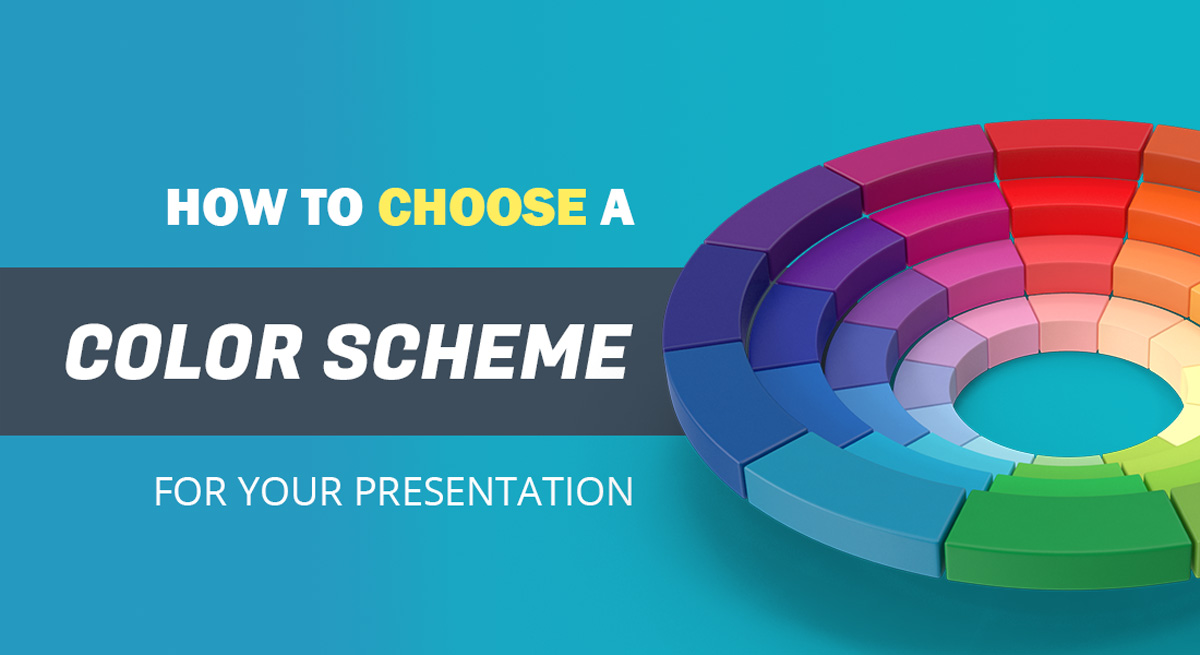
First impression is the last impression, and rightly so. In almost every facade of life, and especially in professional areas. When it comes to making a first good impression, you must take out some time to perfect your look by choosing smart appearance that will flatter your professional look with the perfect color scheme according to the audience. Similarly, when you need to give a presentation, it needs to be created perfectly with fascinating color schemes. The choice of colors for a presentation, is one of the important factors that must be considered as you initiate the process. An effective creation of a presentation deck can help in building a direct relationship between the presenter and the audience.
People are judged by their physical appearance, similarly, your message will be judged on the basis of its design elements, color combinations, and font styles used even before it is read by the audience. Therefore, it is important to create an interactive and vibrant presentation with the best selection of a PowerPoint color scheme based on the topic you’re presenting to your audience.
So let’s get down to study some color theory basics for a PowerPoint presentation .
Basic Colors Theory
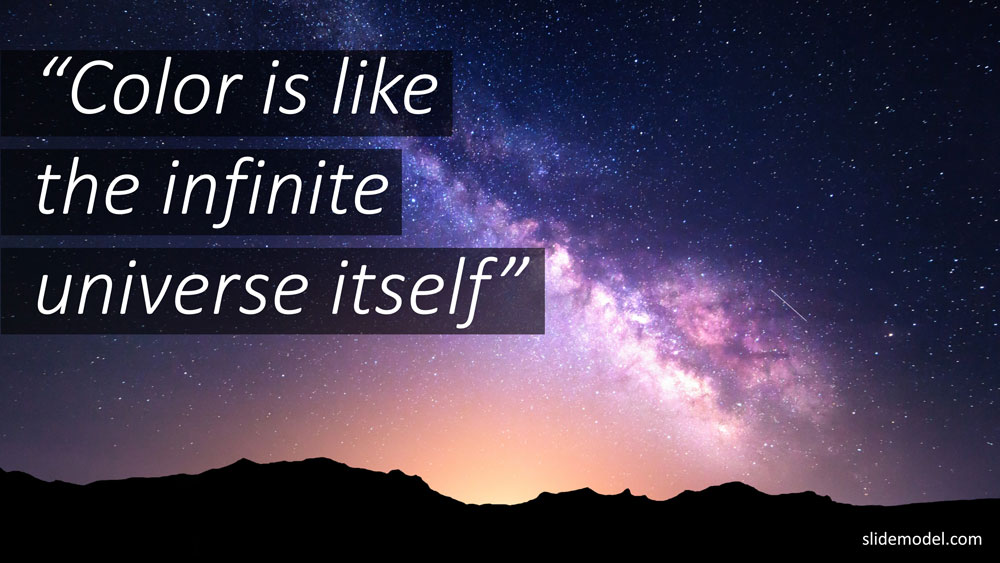
The Color Wheel was the first model used to demonstrate the relationship between different colors. In which, red, blue, and yellow are the basic and are called as primary colors. After the primary colors, secondary colors are formed with the combinations of the primary colors and they are violet, orange, and green.
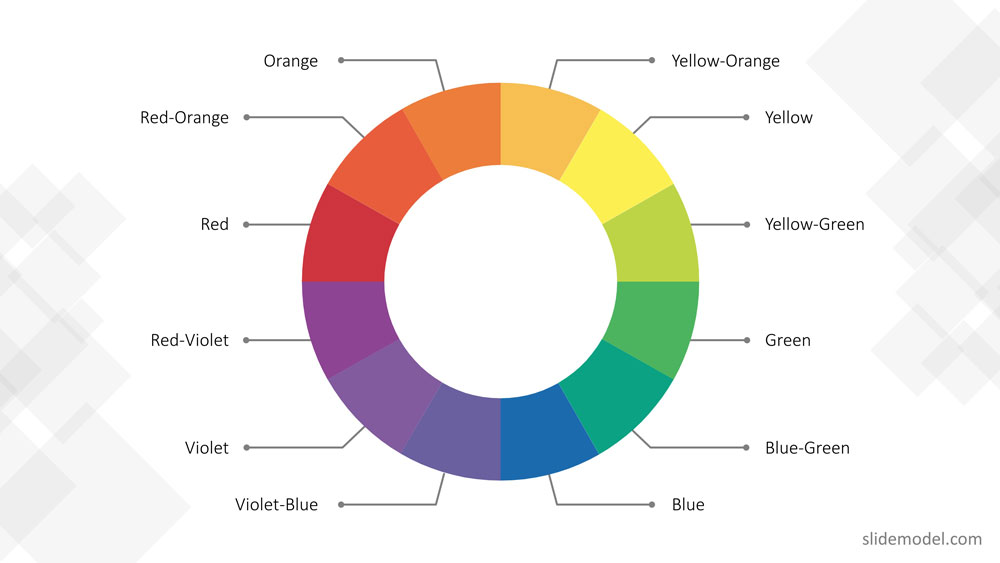
In the end, with the combination of primary colors and secondary colors tertiary colors are formed, which results in these colors, red-violet, blue-green, red-orange, blue-violet, yellow-orange, and yellow-green.
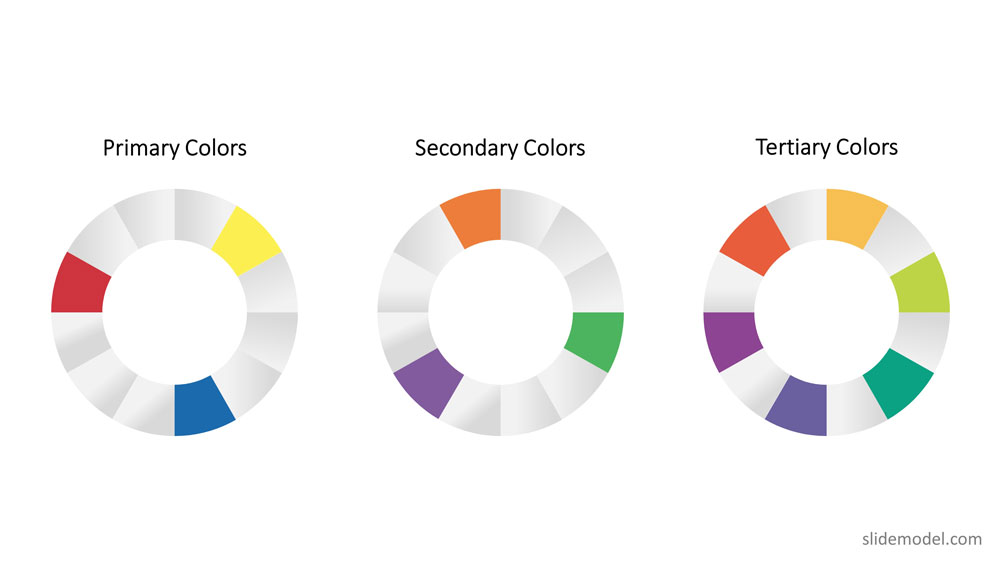
Hence, the color wheel or color circle is composed of 12 colors including, red, green, orange, yellow, violet, blue, red-violet, blue-green, red-orange, blue-violet, yellow-orange, and yellow-green.
This color circle is divided into warm and cool colors indicating vividness, energy and calm, soothing respectively. There are three other terms related to color theory those are tint, shade, and tone.
- In tinting, a color is made lighter by adding white.
- In shading, black is added to get the darker version of the color.
- And intoning, gray is added to get a different tone.
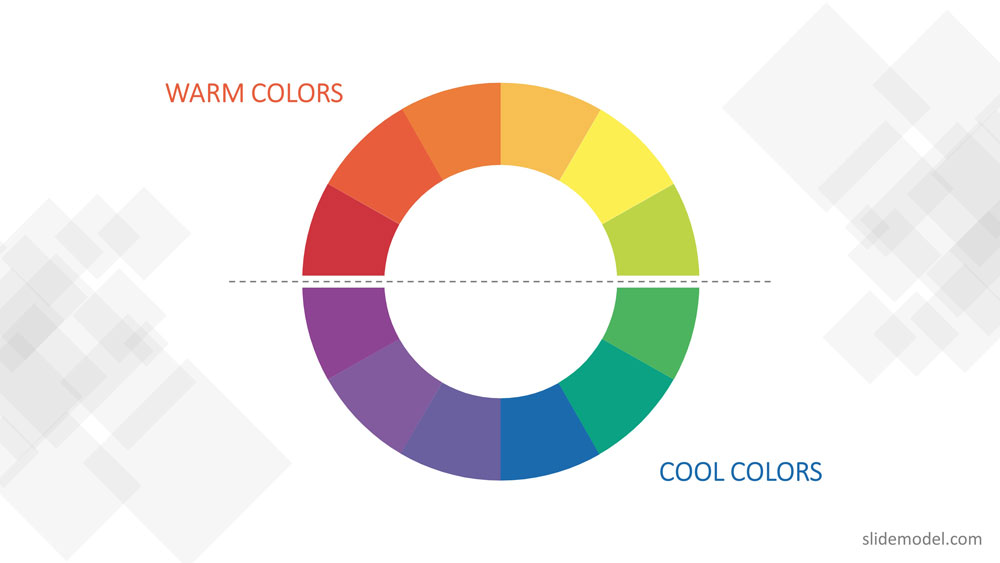
How to Choose the Right Color Scheme for your Presentation
Using the basic color theory described before you can apply the following rules of thumb:
Color Schemes – The use of harmonious color
To create a professional color scheme, pick two colors opposite each other on the color wheel (these are called complementary colors), three colors equally spaced around the color wheel forming a triangle (these are called triadic colors) , or four colors forming a rectangle (these are called tetradic colors). Complementary colors are ideal for high contrast. Triadic colors generates a more balanced contrast, used for example for title and subtitles in the same canvas. Finally, tetradic colors allow to have a theme with two vectors of complementary colors. After the basic color scheme is formed, you can tint , shade or intone those colors to expand your palette.
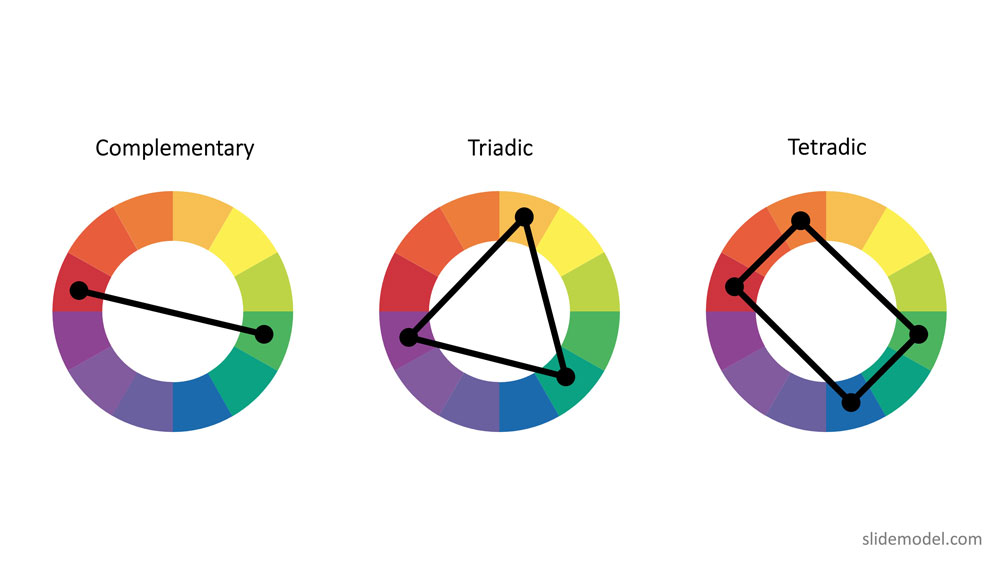
Though Color Theory covered almost everything related to the color scheme, there are few other things you need to keep in mind while choosing a color scheme for presentations.
Since, poor color choice in presentations results in ugly visuals, which put a bad impression on the audience resulting in bad feedback from them.
Some handy tips to keep in mind to choose a good presentation color palette:
Follow high-contrast color scheme
The common mistake found in presentations is color contrast. The presentation slides don’t have enough contrast between the colors chosen for the background and the text or graphics. For professionals, it is very important to create a PowerPoint presentation in high contrast with the background color to attract the audience.
If you have chosen dark background then choose light text and graphics or vice-versa to blend the content with the background and not to make it float above the background. The more contrast you will have and the easier it will be for your audiences to see the text or graphic you are using.
For example, you can take the following slide. The PowerPoint theme uses monochromatic colors (black, grey, white) using high contrast between black,grey and white to differentiate text from the background. It adds two highlighting colors green and fuchsia in order generate contrast and help focusing the audience view in other sectors.

Follow simplicity
Don’t make it gaudy! When it comes to professionalism, simple yet attractive color combinations are the most preferred and recommended. Try to keep the design as simple as possible with a perfect blend of colors and graphics. It is recommended that three to four colors are sufficient for a presentation.
Follow the 60-30-10 rule
The 60-30-10 rule is an interior design color scheme best practice, which adaptation to graphic design has become very popular. It states that the appropriate color proportion of a space (in this case the presentation canvas) should comply with the 60%, 30%, 10% distribution, in order to be considered balanced. The main color (60% distribution) should cover background, the secondary color (30% distribution) will be used for shapes fill or images filter, finally the 10% is allocated as the accent color, used in outlines and text.
In recent studies, it is found that 90% of the decisions are made on the basis of color schemes . In another study regarding branding, states that there is a great relationship between brand and the color being used to represent it. The audience gets attracted only if the color “perfectly fits” to what is being sold.
When you choose a perfect color scheme for a presentation, it comes out to be the most effective. While other color combinations make your presentations difficult to watch and understand.
Here are some mistakes you should avoid while choosing the color combination for a PowerPoint presentation.
Mistakes to Avoid While Combining Colors in PowerPoint
Here are three common mistakes that you must avoid while choosing colors for your PowerPoint presentation:
Illegibility
It becomes difficult to see slides due to color choice. A presentation with a bad or wrong combination of colors could be illegible under specific lighting conditions or monitors. The simplest color combinations that make presentations readable are dark text with a light background and vice-versa.
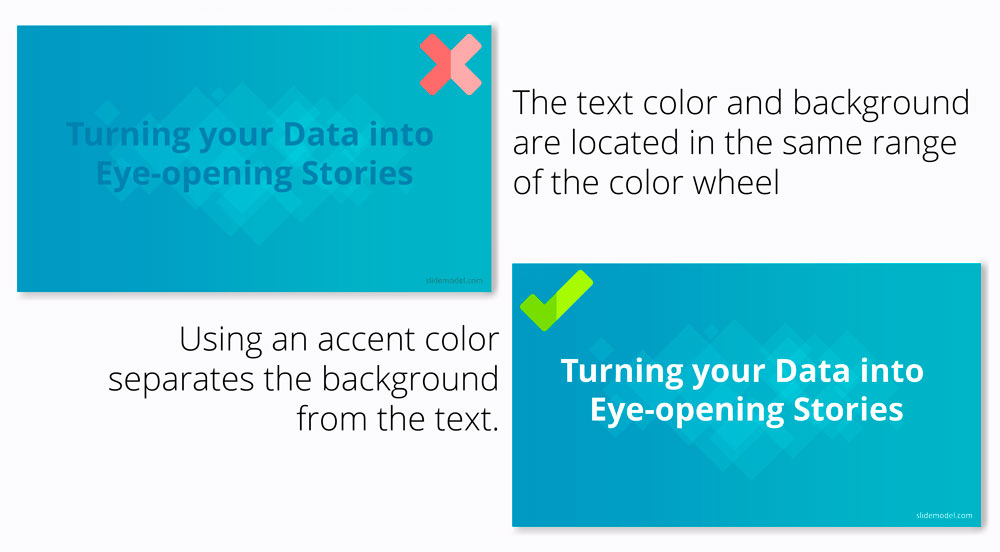
Unclear graphics
In graphics or charts, use colors to distinguish associations or data points or relationships between entities. You can use a single color to represent similar data groups to distinguish from others. This is the best way to make things clear and understandable to viewers. On the other hand, different colors confuse viewers and make it difficult to understand the things shown in slides.
Too much of everything is bad
Whether it is too much of text or images, it isn’t good for your presentation. Slides with a summarized form of data allow viewers to concentrate more on the presenter, who is explaining the topic than the presentation slides.
Text, images, and graphics strengthen your presentation so make sure the text color contrasts as much as possible with a majority of the picture colors and background as well. These tips work well to choose a proper color palette for PowerPoint, but also for presentations in Google Slides.
Color Palette Ideas to Take Inspiration From
Sure you can create your own color combinations with all these tips that we’ve lined out. But it will make your life more easy if you take inspiration from pre-combined palette and presentation templates.
1. Modern Gradient Backgrounds for PowerPoint
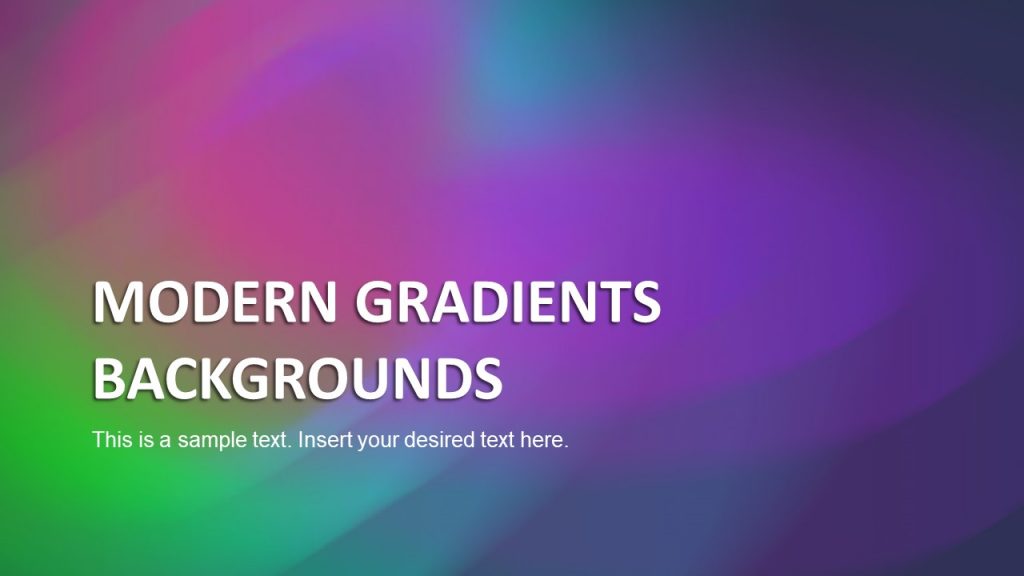
Gradient backgrounds can act as a fuel for your presentations. These are powerful templates that you can choose. This very template presents an elegant and artistic slide deck. Gradient backgrounds are basically a gradual blend of two or more colors which progress and merge from one to another. They are also known as fountain fills or blends.
Use This Template
2. Presentation Template for Business Deck
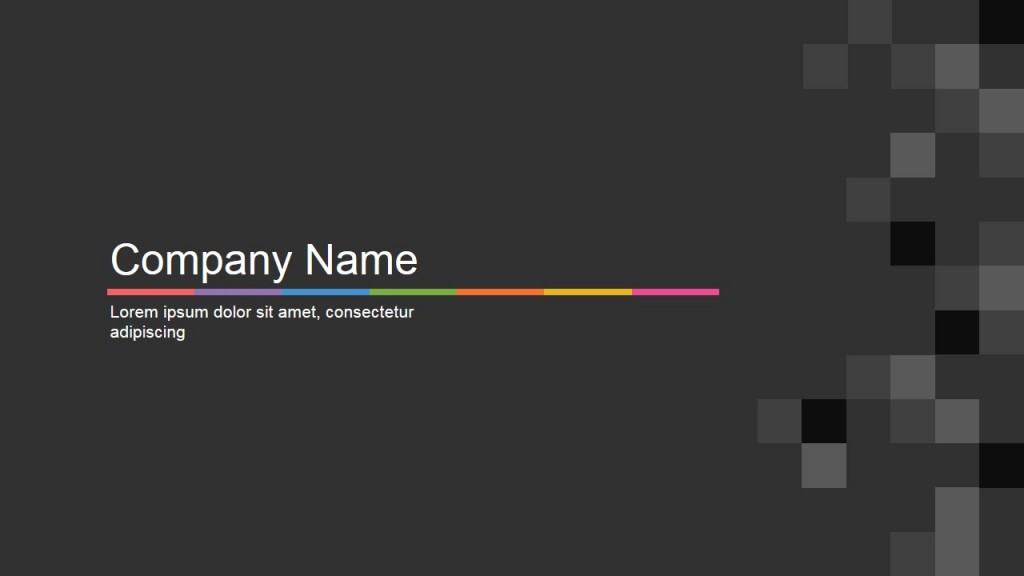
A business presentation must flow well and look clean. With this particular template you can craft professional business decks. It can help you compile all the necessary information in a professional manner.

Like this article? Please share
Business PowerPoint Templates, Business Presentations, Diagram Templates, Templates Filed under PowerPoint Tutorials
Related Articles

Filed under Business • May 17th, 2024
How to Make a Transition Plan Presentation
Make change procedures in your company a successful experience by implementing transition plan presentations. A detailed guide with PPT templates.

Filed under Business • April 22nd, 2024
Setting SMART Goals – A Complete Guide (with Examples + Free Templates)
This guide on SMART goals introduces the concept, explains the definition and its meaning, along the main benefits of using the criteria for a business.

Filed under Business • February 7th, 2024
How to Create & Present a Competitive Landscape Slide for Your Pitch Deck
Get to know how to properly create a winning competitive landscape slide for your pitch deck. Boost your pitch performance now.
Leave a Reply

By Matt Moran January 3, 2024
22 Best PowerPoint Color Schemes to Make Your Presentation Stand Out in 2024
There’s nothing worse than an amateur PowerPoint presentation. If you’re going into a business meeting or sales pitch, your presentation slides should look as professional as you do. That’s why choosing the right color scheme is so important.
In this post, we’ll be sharing a roundup of 22 of the best PowerPoint color schemes you can use to make your presentation look the part.
All the color schemes on this list have been incorporated into templates created by professional designers, so they’re super-stylish and guaranteed to make your slides stand out.
Whether you’re an educator looking for a color scheme that will keep your students engaged, or a business professional who wants to make an impact in your next meeting, you’re sure to find something suitable below.
Tips for Choosing the Best PowerPoint Color Schemes
Before we jump into the roundup, let’s talk about how to choose the right color scheme for your needs. Here are a few things to bear in mind when you’re comparing your options.
1. Use High Contrast Colors
When it comes to color, contrast is the number one most important consideration. Text, icons, and other important graphics on your slides need to be highly readable, so you need to make sure to use high contrast colors for these elements.
In other words, use a color with a significantly different tone/brightness from your background. Certain colors are inherently lighter/darker than others. For example, blue is much darker than yellow. As such, these colors tend to pair well together.
I’d also recommend never combining warm and cold colors, like bright red on bright blue or vice versa. This is because human eyes have trouble distinguishing interactions between the different wavelengths, which causes eye fatigue.
2. Consider Color Associations (Psychology)
People have certain subconscious associations with different colors. For example, people associate blue with trust, calmness, and reliability, which makes it a safe choice for business presentations.
Green is associated with nature, peace, and organic products, which might make it a good choice if you’re working on a sales pitch for an eco-friendly product.
Black evokes sophistication, seriousness, evil, and mystery, so it can work just as well for spooky Halloween lesson PowerPoints as for high-end fashion brand presentations.
Try to choose a color scheme that fits the kind of associations you want to make. If you’re working on a brand PowerPoint presentation, a safe bet is to stick with your brand colors.
3. Always Use Gradients
In nature, colors rarely appear in solid blocks – they transition gradually from one hue to the next and blend into each other.
Because we’re used to seeing colors naturally act this way, you should try to do the same in your PowerPoint presentations by blending colors into each other using gradients. Blocks of solid color can look amateurish.
The good news is that all the templates on this list are designed by professionals who understand this and therefore use natural color gradients to create a professional look.
4. Choose the Right Color Scheme for Your Screen Type
Finally, don’t forget to consider the screen you plan on showcasing your PowerPoint presentation on. Darker color schemes will look good on close-up screens like tablets and desktops. However, lighter colors work better for projections as they tend to be more readable.
In particular, never use red text if you’re projecting your presentation onto an external screen, as if any kind of unwanted ambient light/glare hits the screen, the color will wash out. In fact, it’s best to avoid any brightly colored text if you’re using a projector.
22 Best PowerPoint Color Schemes
Alright, let’s jump into the list. Below, we’ve listed our top 22 favorite PowerPoint templates with awesome color schemes.
1. Shades of Grey and Yellow – Our Top Pick

If you’re looking for a darker color scheme to use for a business presentation, you can’t go wrong with the Hornette template. Darker shades of grey and black strike a serious tone that befits a corporate environment, which is offset by bold yellow highlights.
We like how the high contrast between the darker shades and the bold yellow can be used to direct the readers’ gaze to the most important elements on the page and make key messages stand out.
The template itself includes 50 slides, including a gallery and portfolio slide, and features creative layouts and useful graphics. All graphics can be resized and edited.
2. Teal and White
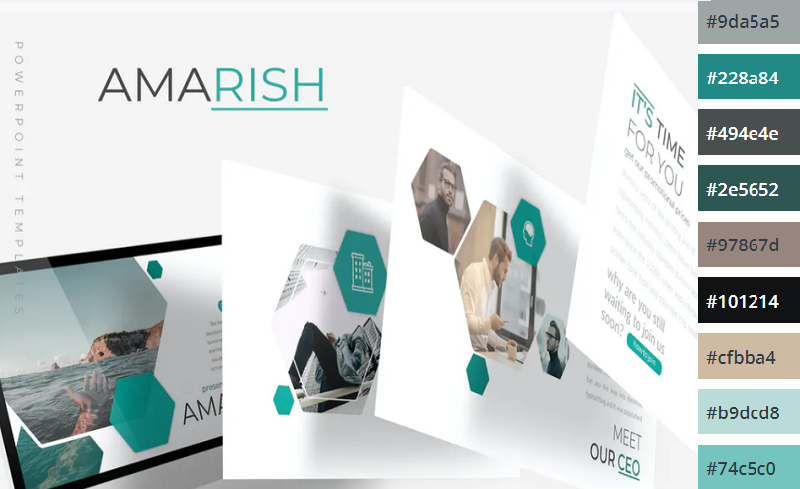
Teal is a color that blends blue’s dependability with green’s optimism and healing properties. The result is a calming, balanced color that’s packed with personality.
This multipurpose PowerPoint template uses teal alongside plenty of whitespaces and is perfect for business and personal presentations. All elements are fully editable, and if teal and white isn’t your style, you can pick another of the 5 included premade color schemes included.
3. Shades of Black
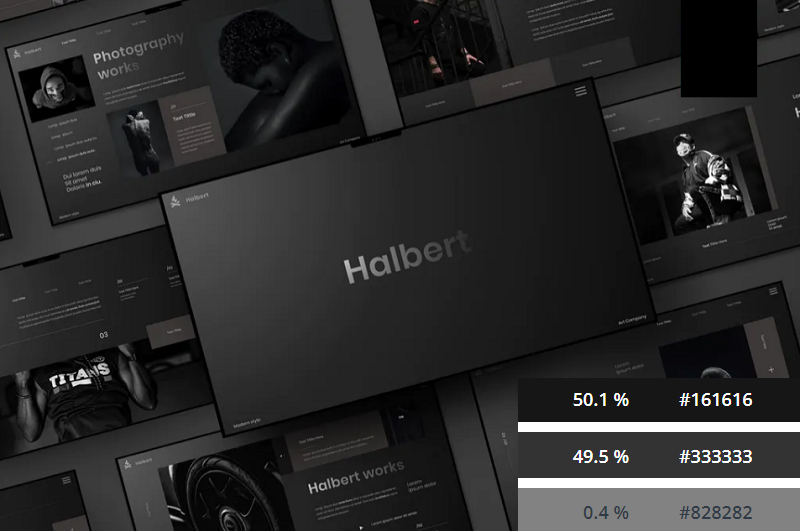
Dark themes are very on-trend right now. If you want to add a touch of sophistication to your presentation or strike a serious tone, you can’t go wrong with this Halbert PowerPoint template.
The all-black color scheme looks slick and elegant, and the white text is highly readable. This template works best when you don’t have to worry about room lighting, and might be a good fit for fashion presentations.
4. Color Fun
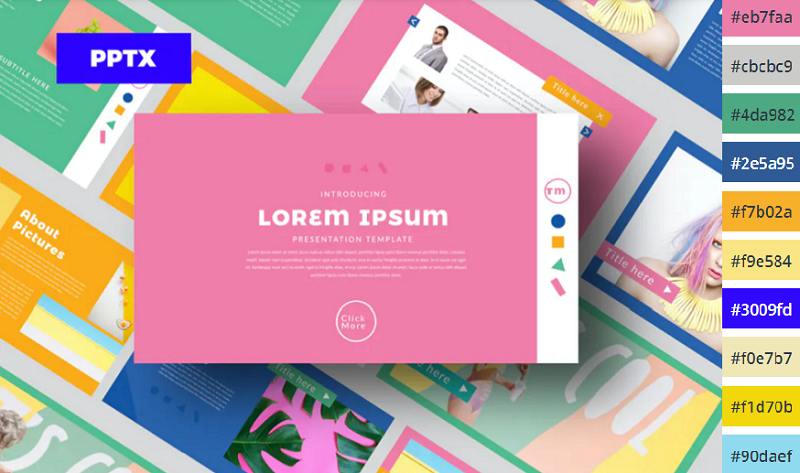
If you want something a little more upbeat, try this Color Fun PowerPoint template. It uses a wide color palette, which can help provide enough variety to better organize the different sections and elements on your slides.
It’s bright, upbeat, and sets a positive tone – without being too overwhelming. The designer has toned down the colors just enough that they’re not distracting and won’t cause eye fatigue.
5. Monochromatic Blue
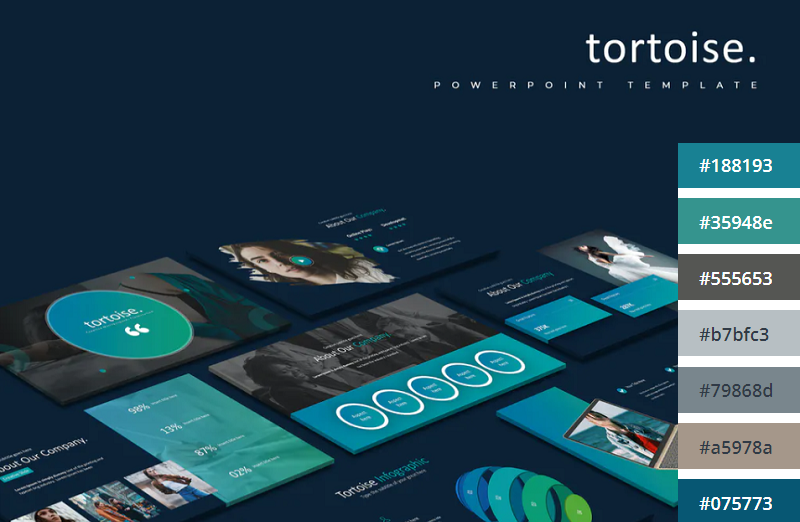
This Tortoise PPT template uses a mix of light and darker blues to create a stylish, professional look. The download includes 150 slides in total, split into 5 colors (30 slides per variation). All graphics included are fully editable and resizable in PowerPoint.
6. Minimalist Light Colors
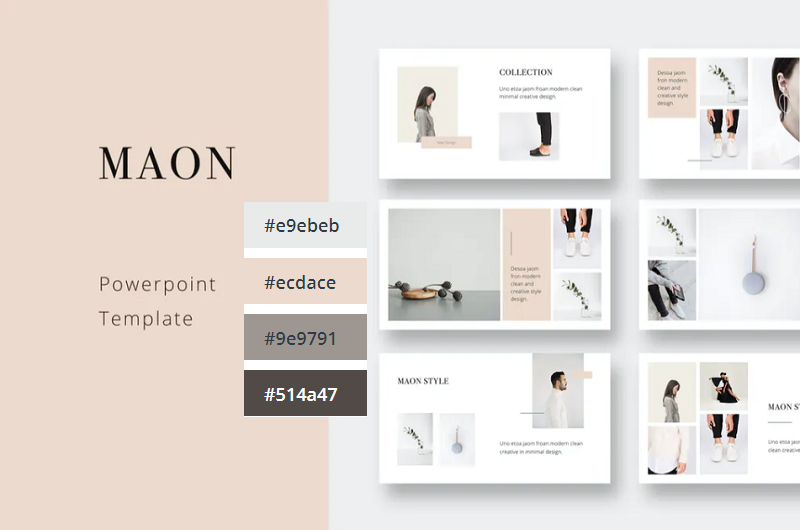
Bold and bright colors can work well but sometimes, it’s best to keep things simple. This clean and modern PowerPoint presentation follows the principle of minimalism, with very light shades like beige and pale green. It comes in a 1920x1080p format and includes a bunch of awesome icons and graphic elements that are fully vector editable.
7. Orange Burst
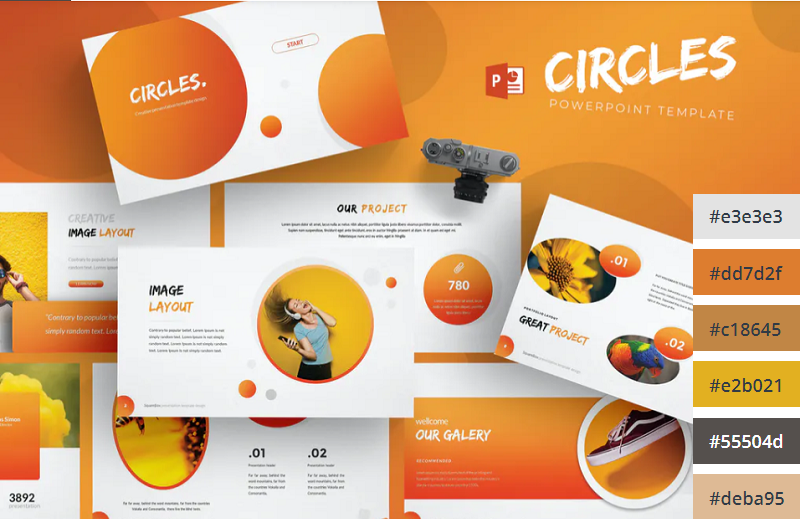
Orange is the most vibrant color in the color spectrum. It’s full of energy and life, so it’s perfect when you want to really get your audience excited about the contents of your presentation. This PowerPoint template from aqrstudio uses orange gradients alongside circular icons and graphics.
8. Yellows and Whites
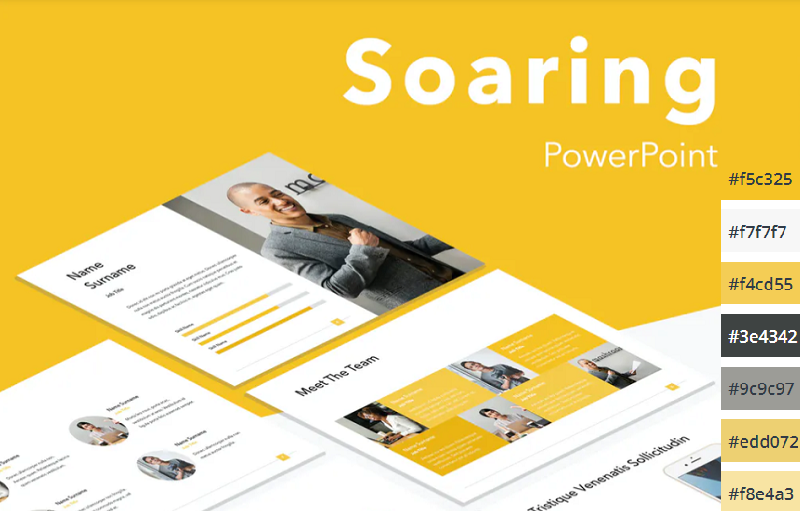
If you’re looking for a yellow template, check out Soaring by Jumsoft. It features an energetic, professional design and includes 20 master slides in the standard 4:3 side, as well as charts, diagrams, tables, and other awesome visual elements. You can choose the layout that’s most suitable for your content and customize more or less everything in MS PowerPoint.

Pastels are the color trend of the year. These lighter, softer shades of colors have been embraced by younger generations like Millennials and Gen Z and have rapidly become associated with self-care for their ‘calming effect’. If you want to incorporate them into your PowerPoint color scheme, check out this pastel template by UnicodeID.
10. Organic Greens
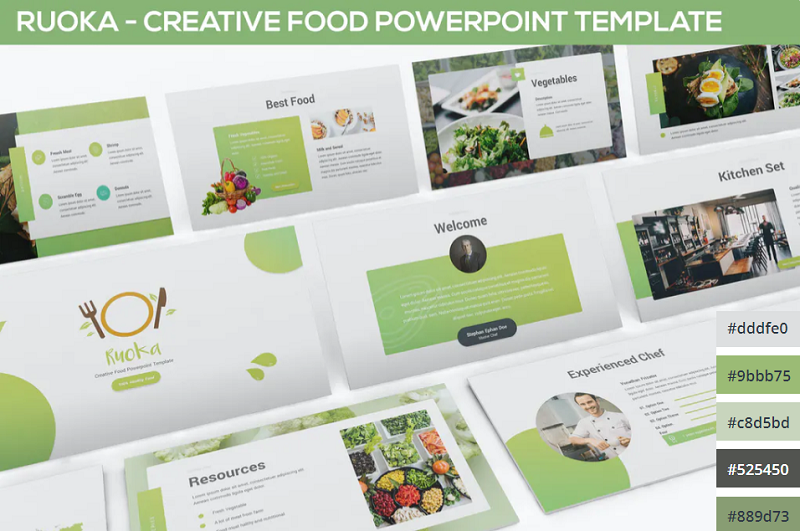
Working on a food-related presentation for a culinary business? Or perhaps you’re putting together a pitch deck on an environmental topic? Either way, this organic green PowerPoint template has the perfect color scheme for you. It’s ideal for health and nature-related slides.
11. Bold Red and Black
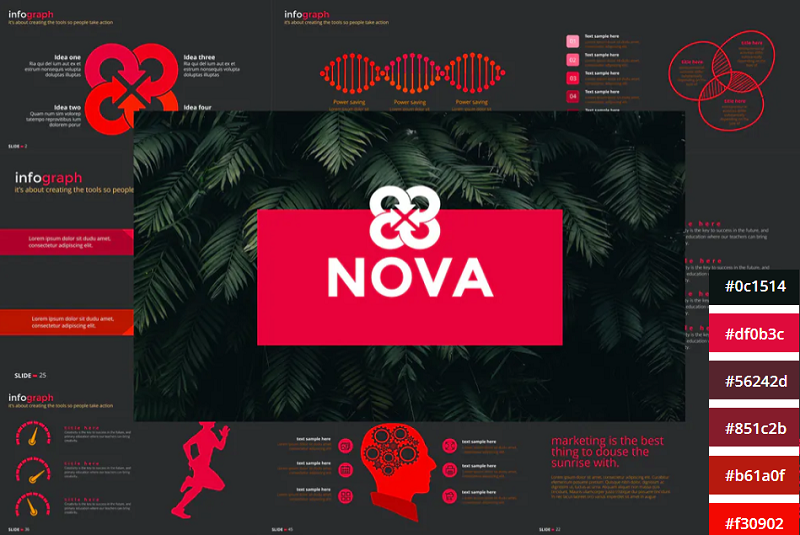
The NOVA PowerPoint template by Artmonk uses a stunning red-on-black color scheme. It’s a bold color combination that packs a punch, so it’s great for presentations in which you’re trying to break the mold and make a statement. It’ll look great on screens but might not show up well on projector displays due to the dark background.
12. Bright Multicolor

Here’s another awesome multi-colored palette that’s upbeat and fun. Wide color palettes like this are great for large slide decks as they give you a lot of options to choose from. I can see this one working really well for creative agencies and personal portfolios.
13. Lime and Dark Blue
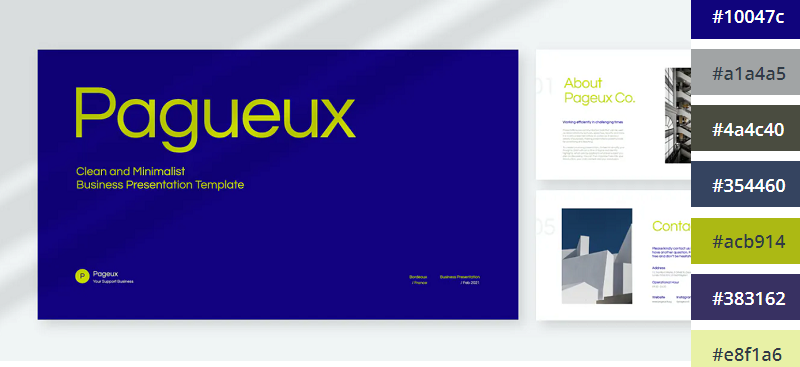
Blue and yellow is a classic combination. This lime and dark blue template offers a new twist on that classic combo to make it a little more exciting. If you already use dark blue as part of your brand color palette, this is a great template to use.
14. Pretty Pink
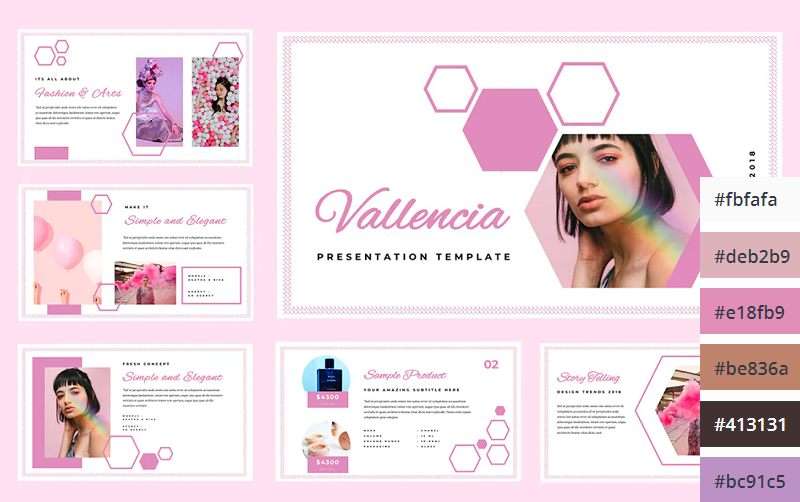
The Pretty Pink color scheme is perfect for creating feminine and youthful PowerPoint presentations. This would be perfect for female-oriented business products, or presentations about beauty, pop culture, and more.
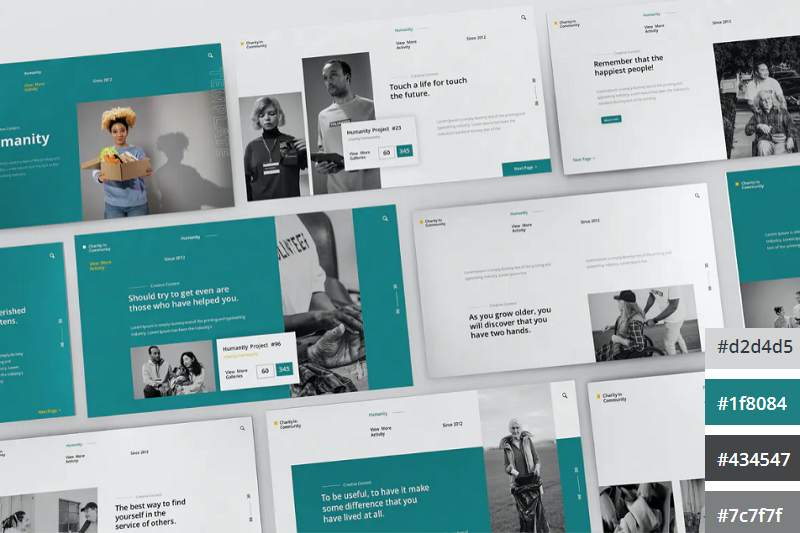
Teal is the perfect color scheme for exuding wealth and intelligence. In color psychology, green connotes wealth and money, whilst blue evokes intelligence. Teal is the perfect blend of the two colors, which makes it a great choice for financial presentations and documentation.
16. Dark with Splashes of Color
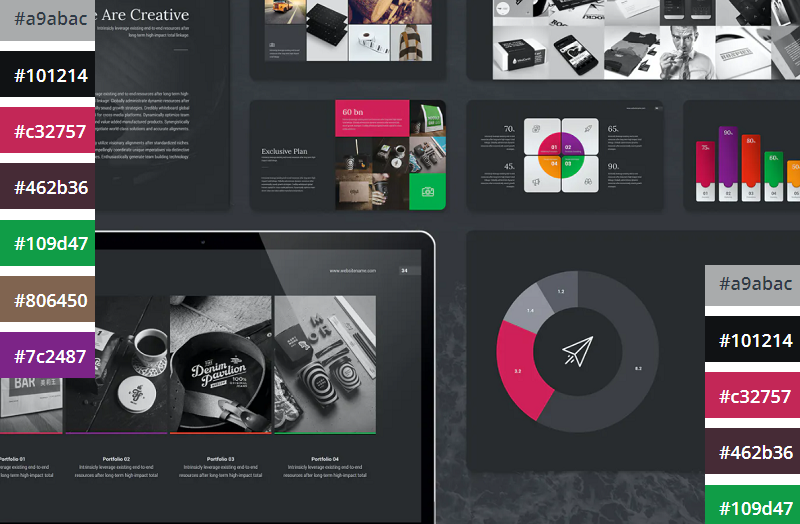
If you want a luxurious and ultra-modern color scheme, Black with splashes of color is just the ticket. The black creates a sleek and professional feel, whilst the bold and colorful highlights make the key information in your presentation pop.
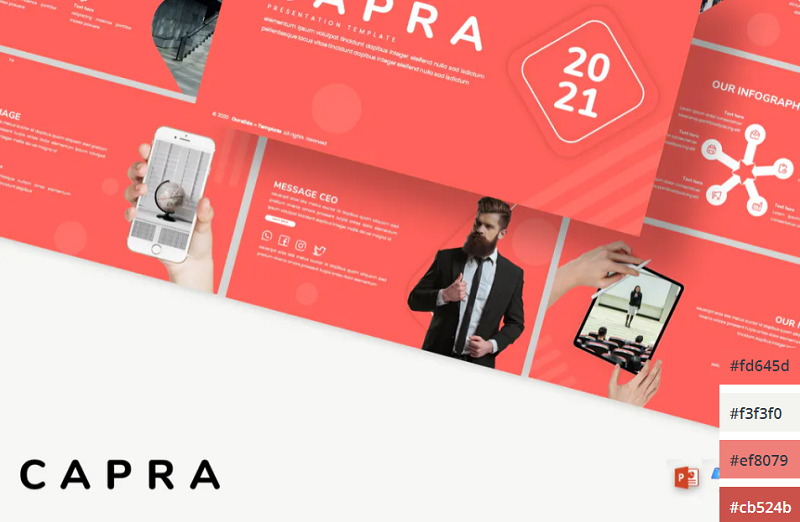
Coral is a bold and vivid color scheme perfect for making an impact on your presentations. This PowerPoint template utilizes coral as the background of each slide which helps the text and other visuals to really stand out.
18. Classic Blue and White
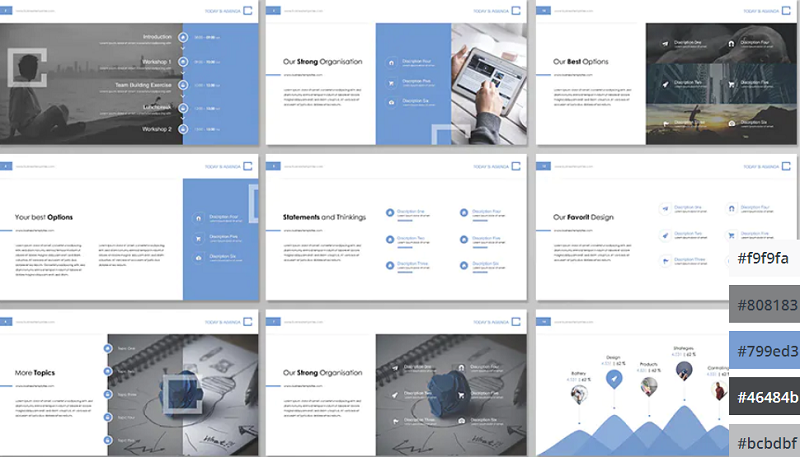
If you’re looking for a clean, modern, and professional color scheme for your PowerPoint presentations, you can’t go wrong with classic blue. The color scheme evokes professionalism and technological prowess and is perfect for tech businesses and startups. The Contact PowerPoint from Envato Elements is a great example of how this color scheme can be used.
19. Pinks and Purples
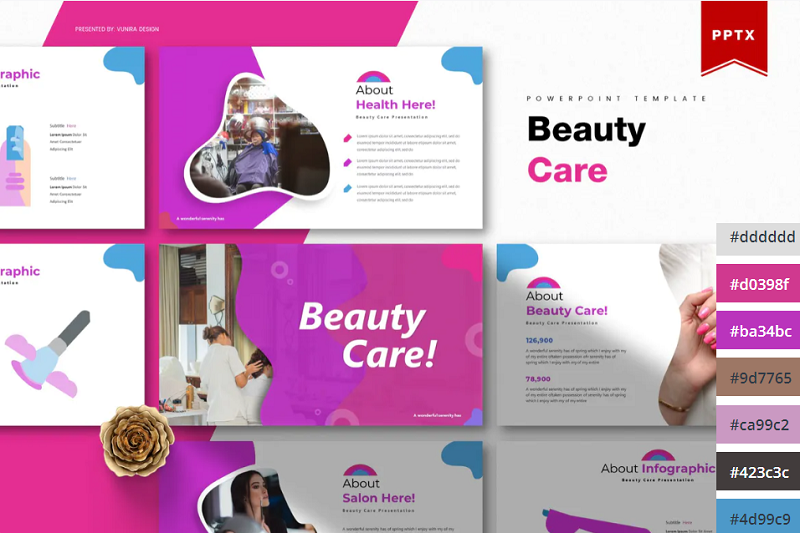
Pinks and Purples is a vibrant and feminine color scheme that would work perfectly for beauty brands and retail stores. The colors are bold and inviting and have a luxurious feel. This Beauty Care template from Envato Elements utilizes this color scheme as well as unique shapes to make for a visually interesting presentation.
20. Winter Watercolors
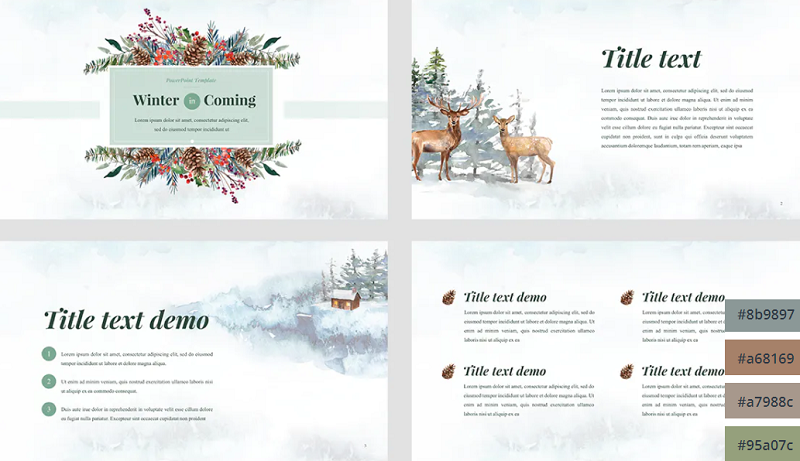
Winter Watercolors is a great color scheme for festive presentations. The muted, blue, and green cold tones are easy on the eye and evoke a homily feeling. This would be perfect for creating slideshows for Christmas parties or other winter-themed events.
21. Coral Highlights
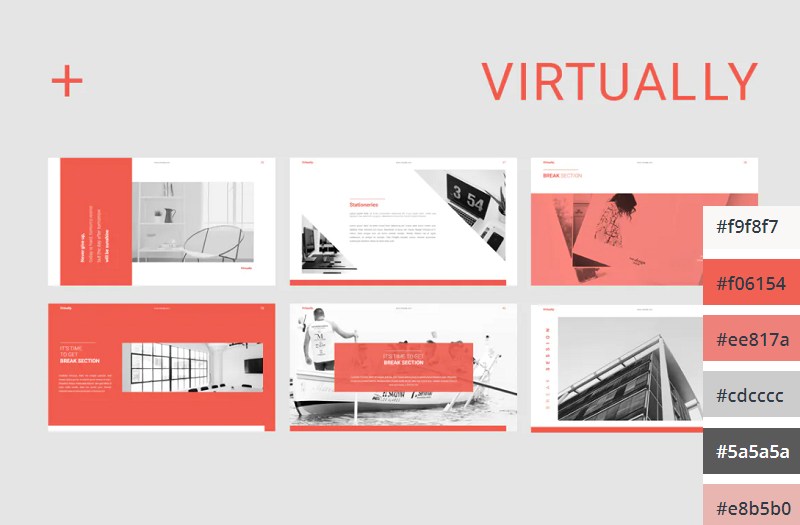
Unlike the last coral color scheme we looked at, which used a coral background with white text, this template uses mostly white slide backgrounds. Coral is used much more sparingly to highlight key elements on the slide. This gives the PowerPoint a more relaxed and feminine touch.
22. Primary Colors
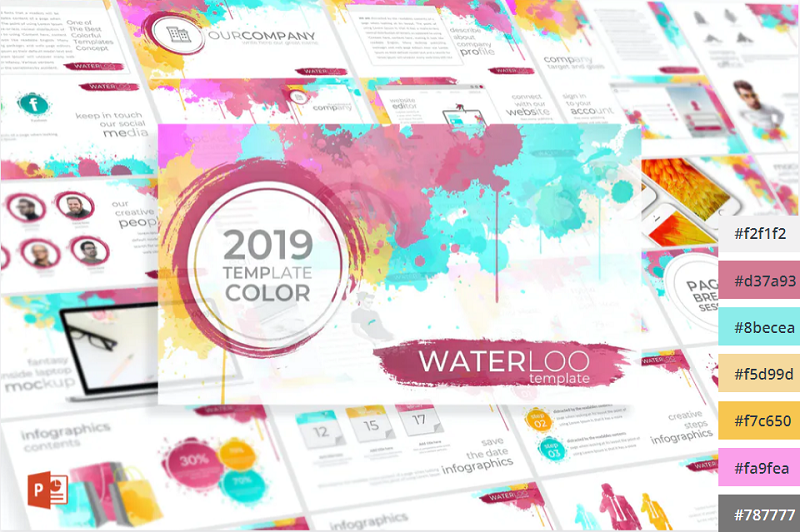
This Primary Colors color scheme is perfect for adding a vibrant touch to your presentations. This color scheme is a modern take on the classic colors of red, yellow and blue, and would be perfect for creating fun and engaging business presentations.
Related Posts
Reader interactions, droppin' design bombs every week 5,751 subscriber so far.
You have successfully joined our subscriber list.
Leave a Reply Cancel reply
Your email address will not be published. Required fields are marked *
Notify me of followup comments via e-mail. You can also subscribe without commenting.
Find the images you need to make standout work. If it’s in your head, it’s on our site.
- Images home
- Curated collections
- AI image generator
- Offset images
- Backgrounds/Textures
- Business/Finance
- Sports/Recreation
- Animals/Wildlife
- Beauty/Fashion
- Celebrities
- Food and Drink
- Illustrations/Clip-Art
- Miscellaneous
- Parks/Outdoor
- Buildings/Landmarks
- Healthcare/Medical
- Signs/Symbols
- Transportation
- All categories
- Editorial video
- Shutterstock Select
- Shutterstock Elements
- Health Care
- PremiumBeat
- Templates Home
- Instagram all
- Highlight covers
- Facebook all
- Carousel ads
- Cover photos
- Event covers
- Youtube all
- Channel Art
- Etsy big banner
- Etsy mini banner
- Etsy shop icon
- Pinterest all
- Pinterest pins
- Twitter all
- Twitter Banner
- Infographics
- Zoom backgrounds
- Announcements
- Certificates
- Gift Certificates
- Real Estate Flyer
- Travel Brochures
- Anniversary
- Baby Shower
- Mother’s Day
- Thanksgiving
- All Invitations
- Party invitations
- Wedding invitations
- Book Covers
- Editorial home
- Entertainment
- About Creative Flow
- Create editor
- Content calendar
- Photo editor
- Background remover
- Collage maker
- Resize image
- Color palettes
- Color palette generator
- Image converter
- Contributors
- PremiumBeat blog
- Terms of use
- License agreement
- Privacy policy
- Social media guidelines
- Invitations

10 Color Palettes to Nail Your Next Presentation
Bring your a-game to your next pitch meeting with these sure-to-dazzle color palettes..
Color is a powerful design tool. The right scheme can energize and motivate, soothe and inspire. With that in mind, we’ve put together a batch of ten eye-catching color palettes, each intended to have a different psychological effect on your presentation audience.
Perhaps you’re a young startup and need to excite potential investors , or maybe you want to ensure that viewers remain focused on important data. Whatever the style of presentation or pitch, you’ll find a color palette that suits your presentation needs in the list below.
- Introducing Creative Flow on Shutterstock Enterprise
- 7 Creative Tips for When You’re in a Slump
Simply take a note of the HEX codes in these inspiring color palettes, and apply your swatches to backgrounds , typography , or sales presentation templates for your next PowerPoint presentation or Google Slides pitch.
Now, let’s get started! It’s time to nail that pitch.

License this image via Pikoso.kz .
What Are the Best Colors for Presentations?
The best colors to use in PowerPoint , Google Slides, and other presentation software can vary widely depending on your audience, brand, and what you’re trying to achieve with the presentation.
A pitch for a new client might require exciting, inspiring color choices that help your audience to feel energized , while a data-heavy presentation to long-standing investors might require a more stable and reassuring color scheme.
- 10 Psychological Color Palettes to Win Friends and Influence People
- How to Use the Color Wheel to Build a Brand Palette
Below, you’ll find 10 color palettes for presentations that tap into the power of color psychology , helping you to choose colors that will always work in your favor.
These stylish color palettes can work for a variety of presentation purposes, like corporate reports, brand launches , and Q1 forecasts.
Scroll down to find the perfect presentation palette to help you bring the power of color to your next pitch.
1. The Perfect Color Palette to Energize Your Audience
Orange has been proven to promote energy and appetite in viewers, so it’s the perfect color choice for presentations that need to have an upbeat feel.
To keep your audience engaged throughout a long presentation, it helps to balance orange’s energy with the soothing, expansive mood of violet blue .
Blue-sky thinking is blue for good reason—this is a color that provokes inspiration and openness to new ideas.
To keep your energized palette crisp and clean, turn to ice white and pitch black to ensure your text remains crisp and legible.

2. The Best Color Palette to Calm and Reassure the Room
Sometimes, it’s more important to calm and reassure your audience than to energize or surprise them. Presentations focused on mental well being , health , or wellness wouldn’t benefit from a neon palette , for example.
Instead, bring a zen mood to the boardroom with this palette of soothing hues. Spring green , mulberry purple, terracotta, and blue gray have a grounding effect and mimic the soothing colors found in nature to create an ultra-relaxing effect.

3. The Perfect Color Palette to Boost Confidence
Red is traditionally the color of confidence, proven to make viewers feel stronger and more self-assured in its presence. However, pure red can be overtly aggressive, and the forceful effect of the color can be heightened on bright screens. Much better to temper red’s aggression with softer red orange , fuchsia , and shell pink .
This is still a highly confident palette with its graduation of warm hues, and its assertion is even stronger when paired with mysterious and authoritative plum purple .

4. The Best Color Palette to Appeal to Corporate Businesses
This color scheme gives a nod to the traditional palettes of the financial and legal world. Bottle green and cognac brown are teamed with dark racing-green and old gold for an established and luxurious effect.
Corporate presentations can be difficult to enliven, as they require a degree of formality and convention. However, this palette steps away from oft-used navy blue toward something more interesting.
Evocative of leather and velvet, this is a cocooning and moneyed palette that will help corporate clients feel like you understand their formal world.

License this image via AlonaPhoto .
5. The Best Palette to Look Cool and On-Trend
Many startups, entrepreneurs, and young brands want to appeal to Gen Z audiences , and they need to have a cool color palette to match.
Whether you’re presenting a new product launch or looking to entice an on-the-pulse angel investor, this violet and neon palette will cement your cool credentials.
Look to urban colors, such as neons and grays, to create presentation slides with an ultra-cool mood.
This urban-inspired presentation palette combines deep and inky violet with acid lime yellow for a high-contrast effect, while concrete gray and moody black provide a neutral offset.

6. The Perfect Color Palette to Look Innovative
Young companies or startups pitching for their first round of investments need a palette that will communicate a spirit of innovation and fresh thinking. A perfect color palette for tech businesses or science startups, this palette has a futuristic, forward-looking mood.
Purple is the most intellectual and mysterious of all colors, making it a good fit for businesses offering something a little different from the norm, especially in the tech sector .
Neon pink is an unexpected choice for work presentations, but here it’s the perfect companion to purple and violet blue, bringing energy and a youthful mood.

7. The Best Color Palette to Appear High-End
Elevate your high-end presentations with this luxurious color scheme that borrows from vintage color schemes of the 1930s and 1940s.
If you’re pitching for a high-end brand or simply want to bring an elegant mood to your presentation slides, this claret and copper scheme will help your PowerPoint templates feel opulent and expensive.
Dark brick red and olive green are traditional establishment colors that give a nod to beautiful brick architecture and vintage uniforms.
This affluent color palette would also be a good fit for the hospitality, travel, or luxury goods sectors. Team with metallic backgrounds and crisp white text for simple luxury.

8. The Best Color Palette to Improve Focus
If you have vitally important data or a specific message you want your viewers to remember, consider this presentation palette of focus-promoting colors that will prevent your audience from mid-pitch window gazing.
Blue and green are the two colors most associated with improving focus and concentration, with blue promoting expansive thinking and green providing a harmonic, nature-inspired mood.
In this business color palette, rich teal combines both of these hues for a serious focus hit. Earthy burnt orange prevents teal from feeling lethargic, while giving the palette a grounded edge that feels serious and cerebral.

9. The Best Color Palette to Promote Sustainability
As sustainability is a central concern for many businesses today, it might be in your interest to give your presentations an environmental edge.
While businesses are often advised to avoid greenwashing , for the purpose of presentations, green is still the most reliable color for communicating environmentally-themed messages. It helps to immediately situate your audience within an eco-friendly mindset .
Whether you want to discuss how your company can become more eco-friendly or promote a sustainable product to a potential buyer, this fresh and verdant palette will give your slides a nature-inspired mood.
Emerald green , sage, and deep bottle green are made crisp and contemporary when teamed with chalk white.

10. The Perfect Color Palette to Boost Creativity
We could all do with a little more creativity in our working day, and you can turn to selective color choices to boost your weekly brainstorming session.
For presentations that need to appear creative or boost the creative potential of your audience, bright colors are stimulating, expressive, and promote a sense of childlike play and experimentation.
This is a colorful pick-me-up scheme for work-weary souls—a perfect presentation color palette for team-building days, ideation sessions, or for subjects that are more outside-the-box than usual.
Orange and pink perk up the palette with warm tones , while viridian green and azure blue bring a fresh, tropical feel to this fun, creative color palette.

License this cover image via VISTA by Westend61 .
Recently viewed
Related Posts

How to Build a Brand Identity in 5 Easy Steps
Follow this guide to streamline the branding process and design an effective, professional brand identity ASAP.

Brand Colors: The How and Why of Picking the Right Colors
Whether you’re working on a major rebrand or just getting started at a new company, the impact that color has on your logo can make a huge difference.

Inspiring Sketchbook Cover Ideas for Self-Publishing Artists
Check out these tried-and-true methods—and examples—for creating book covers that capture the mood of your art or photography book.

How to Design Podcast Cover Art
Your podcast’s visual identity is just as important as its content. Try seven tips to make your podcast covers stand out from the crowd.
© 2023 Shutterstock Inc. All rights reserved.
- Design , Inspiration , Lists , Presentation Design , Presentation Trends
The 7 Best Color Combinations for Your Next Presentation Design
- By: Michael Dyer
Whether you’re a new presentation designer or a seasoned pro, I’m sure you’re familiar with the impact that color can have on a design. Today we’re going to look at the 7 best color combinations for your next presentation design.
Color evokes emotion. It can inspire, create intrigue. Because color can be so influential, color is one of the most powerful tool at your disposal as a presentation designer.
With almost 18 million colors out there, the color scheme options for your next presentation are just about infinite. But don’t worry. We’re here to help.
Foundation: Color Theory and Color Wheel
If you’re just looking for colors, you can scroll on – but if you really want to understand the why behind each of these color schemes, keep reading.
Color theory
What is Color Theory, well the IDF says that “Color theory is the collection of rules and guidelines which designers use to communicate with users through appealing color schemes in visual interfaces.”
In basic terms – Color Theory is the science of using color to communicate.
Color wheel
Did you know that Isaac Newton invented the color wheel? When he was 23… While that makes me feel like a failure on a personal and professional level, I’m truly grateful he created it. Here’s why:
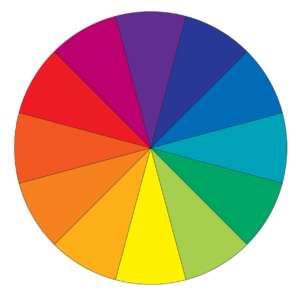
Newton understood how color was defined by human perception and how it came together to create eye-catching combinations, resulting in him creating the primary, secondary, and tertiary color categorizations:
Primary colors : red, yellow, blue
Secondary colors : orange, green, violet (created by mixing primary colors)
Tertiary colors : red-orange, yellow-orange, yellow-green, blue-green, blue-violet, red-violet (created by mixing both primary and secondary colors)
To get started, let’s split the color wheel in half. You’ll start to notice that there is a distinction between warm colors (reds, oranges, and yellows) and cool colors (blues, greens, and violets).
Warm colors typically convey sentiments of energy, brightness, or life whereas cool colors convey sentiments of calmness, grounding, or serenity.
Color Combinations
There are three basic color combinations that you need to understand.
Complementary Color Combinations are the colors that sit on opposite sides of the color wheel. Combining these colors creates an effect of high contrast. Due to the high levels of contrast, they’re typically pretty eye catching.
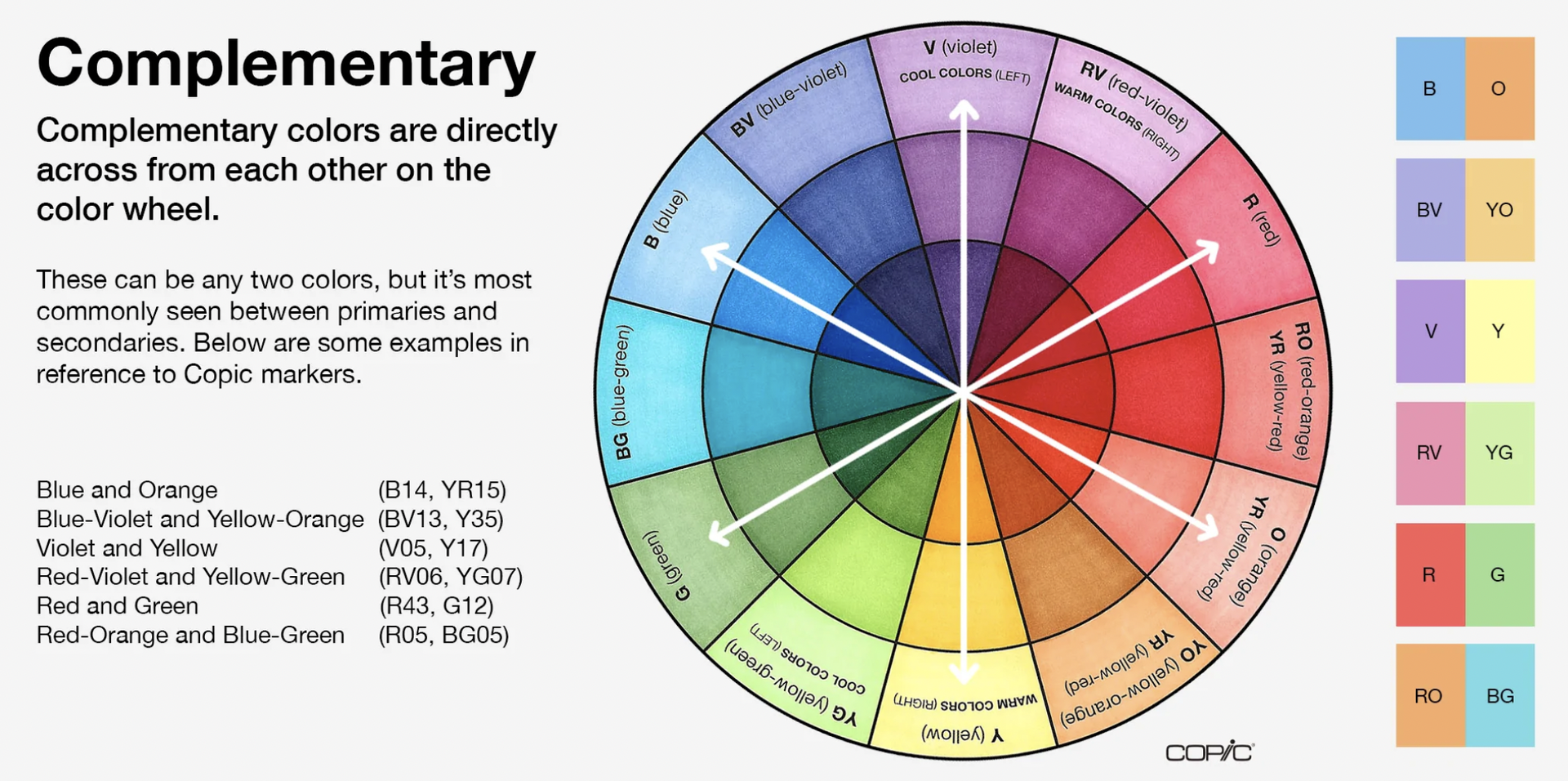
Analogous Color Combinations are every two to five colors that sit beside each other on the color wheel. These color combinations create a sensation of balance. Typically one of these colors sits in the background, while the other more dominant color sits in the foreground.
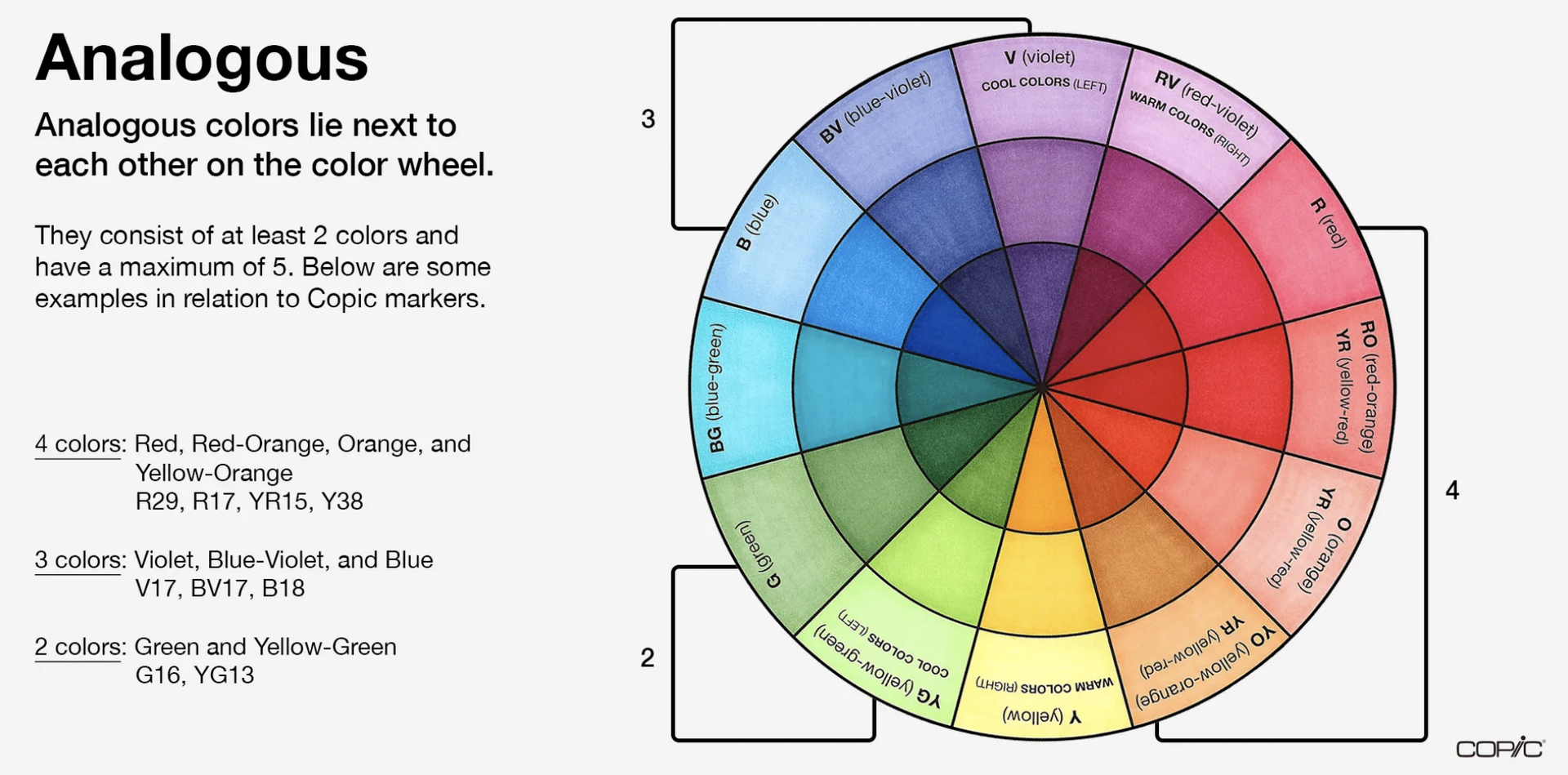
Triadic Color Combinations or Split-Complementary are spaced evenly throughout the color wheel and tend to be more rich or vibrant in color. This color combination is typically dynamic, creating a harmonious visual contrast that pops when combined. Create a triangle on the color wheel and you’ll find your 3 triadic colors.
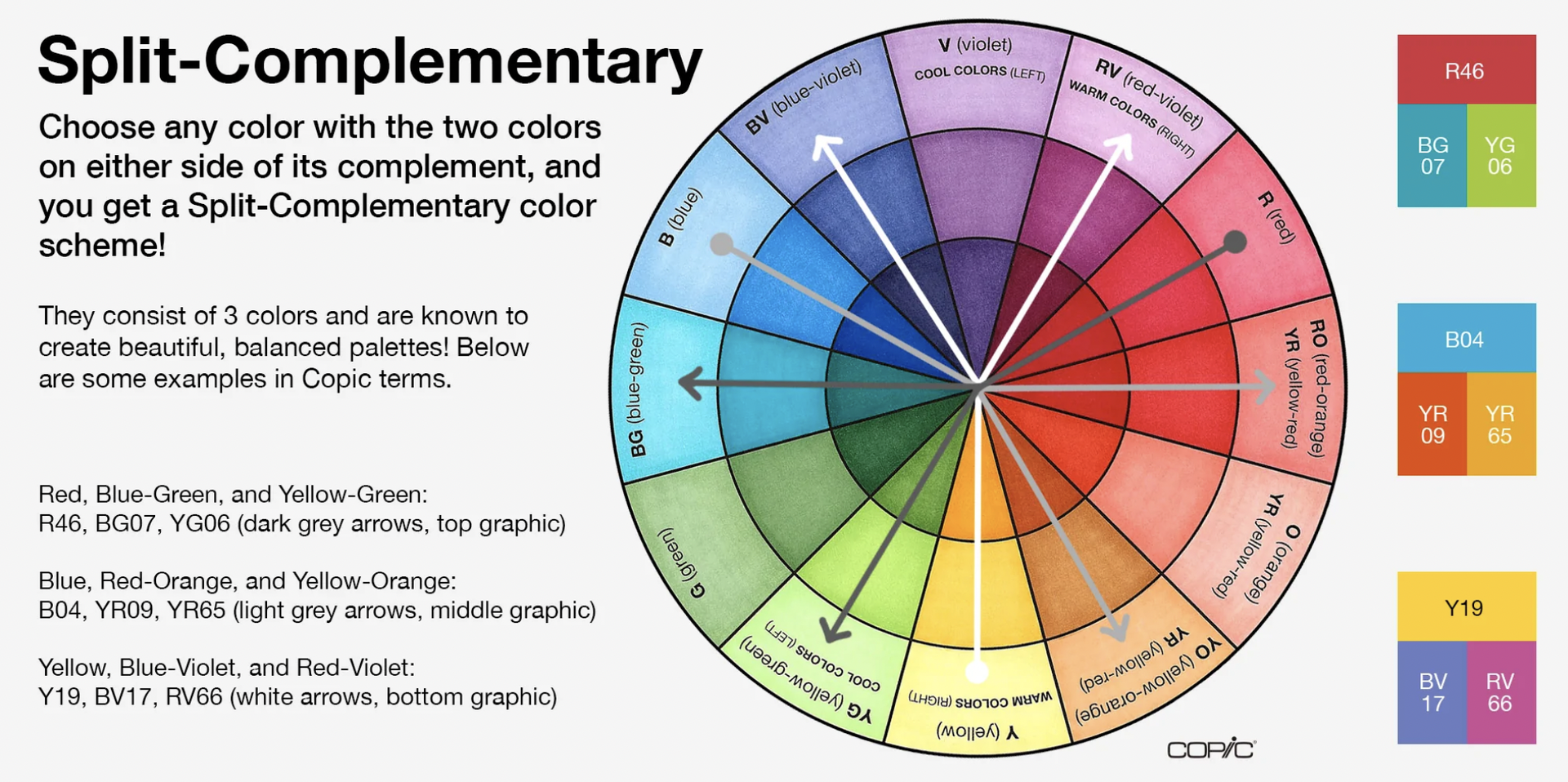
Understanding the universal perceptions and relationships of colors is key to being a great artist or designer.
So here’s our list of the 7 best color combinations for your next presentation design.
Note: Naming colors is less of a science than color theory is, so we took inspiration for OPI’s nail polish names and went a little wild with these.
1. The “Hip Tech” Combination
Once you start looking for these purples mixed with these oranges, you’ll notice them all over the place. And for good reason, they look great together!

2. The “Fun at the Beach” Combination
Definitely a bit more playful than the first, but we’re expecting to see more and more pastels come into play in 2023, so don’t be surprised if you start seeing #DCF3C4 show up in a pitch deck near you.

3. The “Australian Summer” Combination
A pitch deck? Sales demo? New branding guidelines, our team loves this color set and we think you should too.
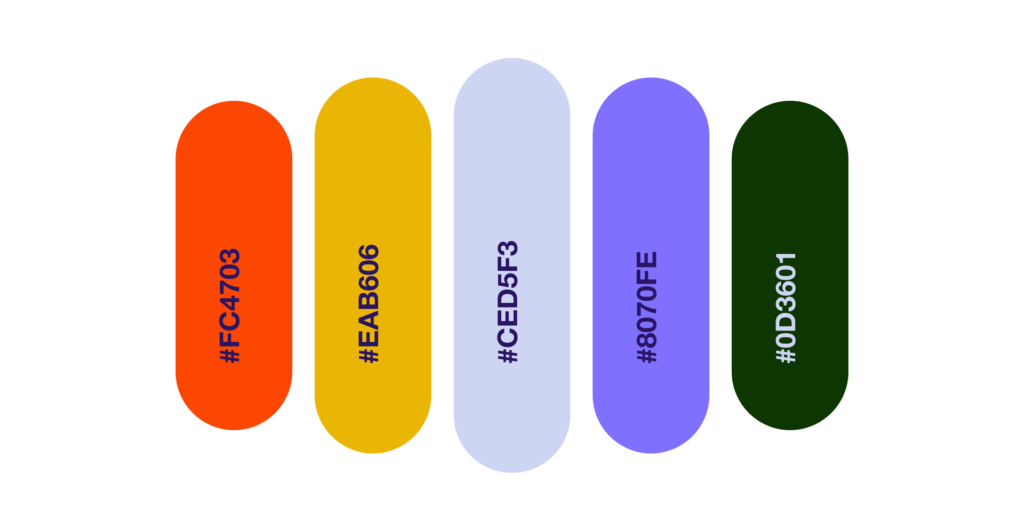
4. The “Gen Z’s Easter” Combination
As we mentioned, pastels are coming back in a big way. And we think the Gen Z’s Easter could really take flight.
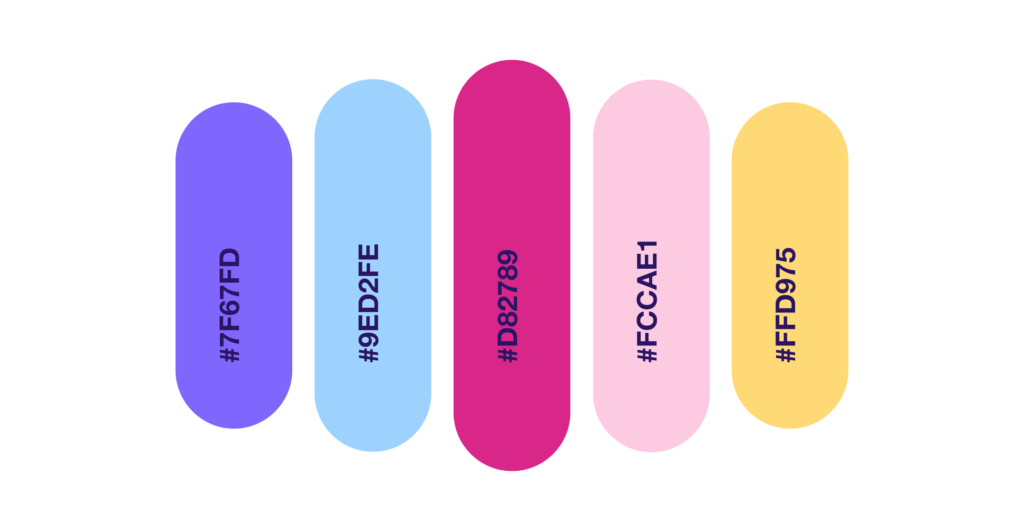
5. The “Cool April Nights” Combination
Is it just me or do you want to bust this out on your next deck, illustration, and re-paint that boring room in your house all of these colors?
Just me? Ok.
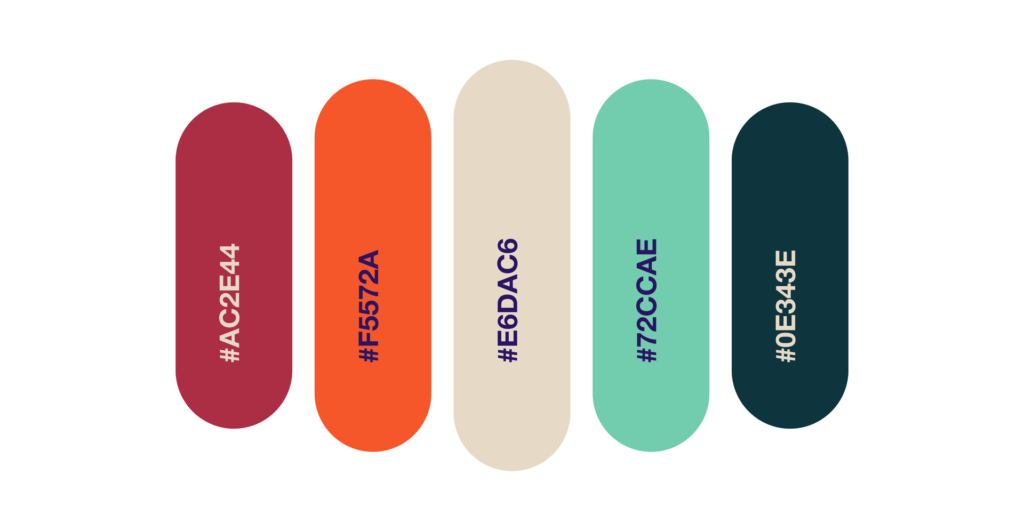
6. The “Logistics Company but Cooler” Combination
I’m going to say it – if you’re a company that does logistics or you’re a new map app, I’ve almost completed your new branding for you. That green and blue with those pinks, you’re welcome.
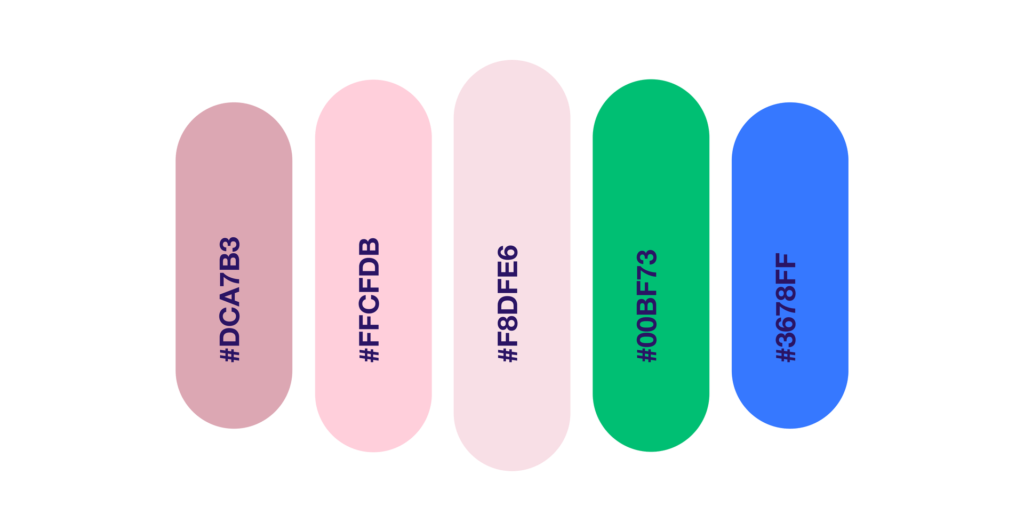
7. The “This Presentation is Going to Win a Prize on Behance” Combination
We believe in saving the best for last – and while there’s a bunch of winners on this list – I think the diversity of this color combination along with where design in 2023 is going- this could be the winner.
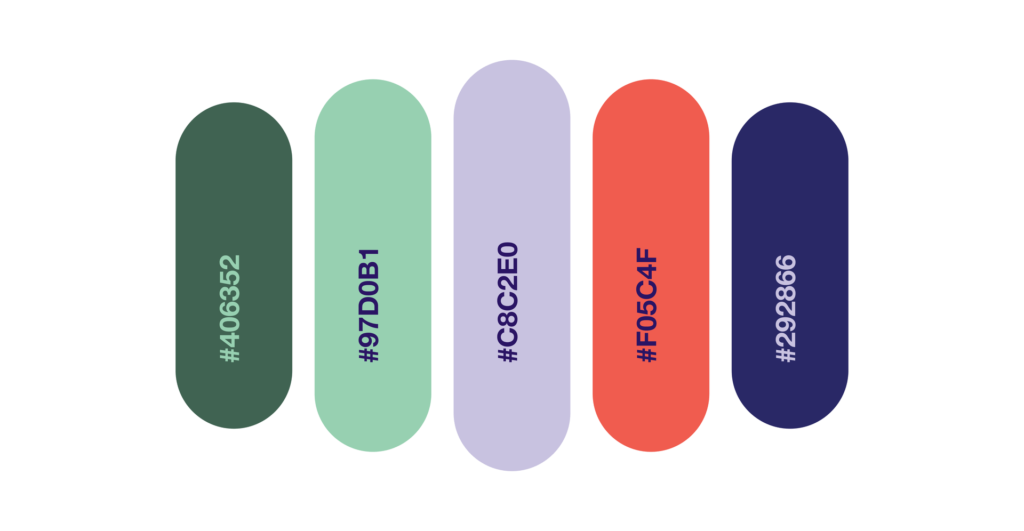
If you’re curious what a team of professionals could do with any of these color combinations or with your brand guidelines, let us know! We’d love to work with you on your next deck!
Michael Dyer
Join our newsletter today.
© 2006-2024 Ethos3 – An Award Winning Presentation Design and Training Company ALL RIGHTS RESERVED
- Terms & Conditions
- Privacy Policy
- Diversity and Inclusion
What Colors To Choose For Your Presentation?

Colors are not only a matter of personal taste. They convey feelings, influence people’s mood, and even carry specific meanings. That is why you should leave nothing to chance when choosing the colors of your PowerPoint presentation. However, you don’t need to be an expert in graphic design or color psychology to select accurately the shades of your backgrounds and fonts. In this article, you will find a series of tips to help you pick the right color scheme. Get ready to come through your presentation with flying colors!
1. Choose the right color to convey the right feeling
Psychologists have taught us that colors can influence people’s perceptions and even trigger emotions. That is the reason why they have become such important elements in branding and marketing. The same goes for your visual aids: your audience will not have the same emotional response if you use a bright red background or a light blue one. Once you have identified the feelings at the core of your message, you will be able to choose the colors that can transmit them. Let’s have a look at the most common colors and discover the feelings and connotations they communicate.
RED – A powerful color to use with moderation
In the Western world, red is associated with love, passion, strength, and energy. It is a great color to put emphasis on a specific feature but can be tiring throughout a whole presentation since it raises the heart and respiration rates. Remember red is also the color of anger and danger. In conclusion, use red with care, only if you have a specific goal, for example, if your topic is food and you want to increase your audience’s appetite!

BLUE – The safe choice
More than one-third of people consider blue their favorite color, so grab this opportunity! The most popular color has a calming effect and suggests peace, sincerity, confidence, and security. It is therefore a great option as a background, especially used in the finance, business, computing, communication, and healthcare areas.
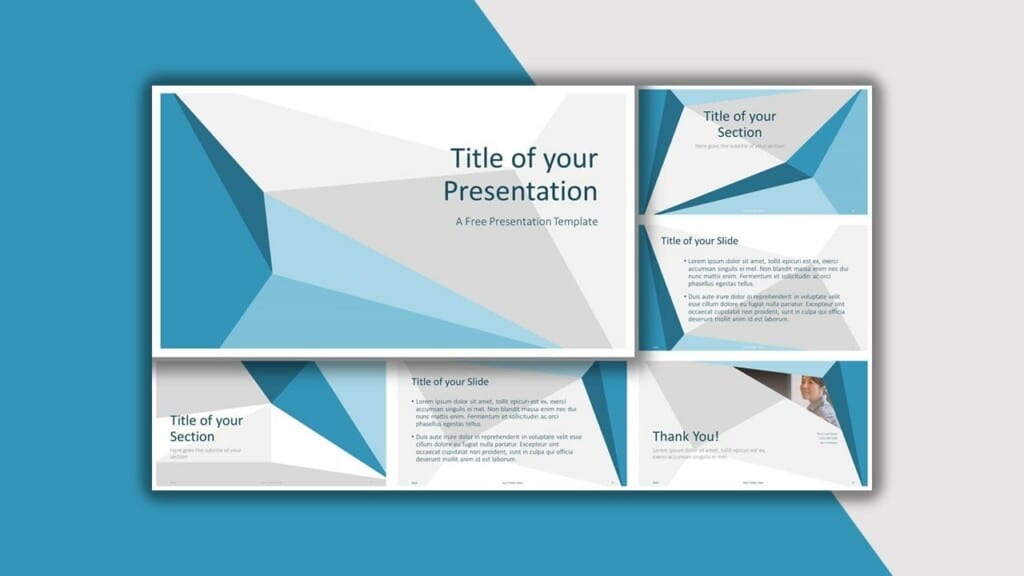
GREEN – A color with harmonizing effect, perfect for nature-related presentations
The third and last of the primary colors can have a positive impact on your public since it represents life, nature, and peace. Moreover, it conveys feelings of balance and growth. Green is also believed to increase interaction, so if you want to set a mood that leads to dialogue, go green!

YELLOW – Feed your presentation with positive vibes
Let there be light! If you want to be sure to capture everybody’s attention, yellow is the stimulating color you need. It inspires happiness, optimism, and creativity. Nevertheless, try to use a soft shade of yellow in your background, since a bright yellow can be perceived as unsettling.

ORANGE – Show your creative side
Why not try the color of innovation and creativity? If you want to convince your audience to try something new, orange will do the trick: it is the hue of extroversion and confidence.
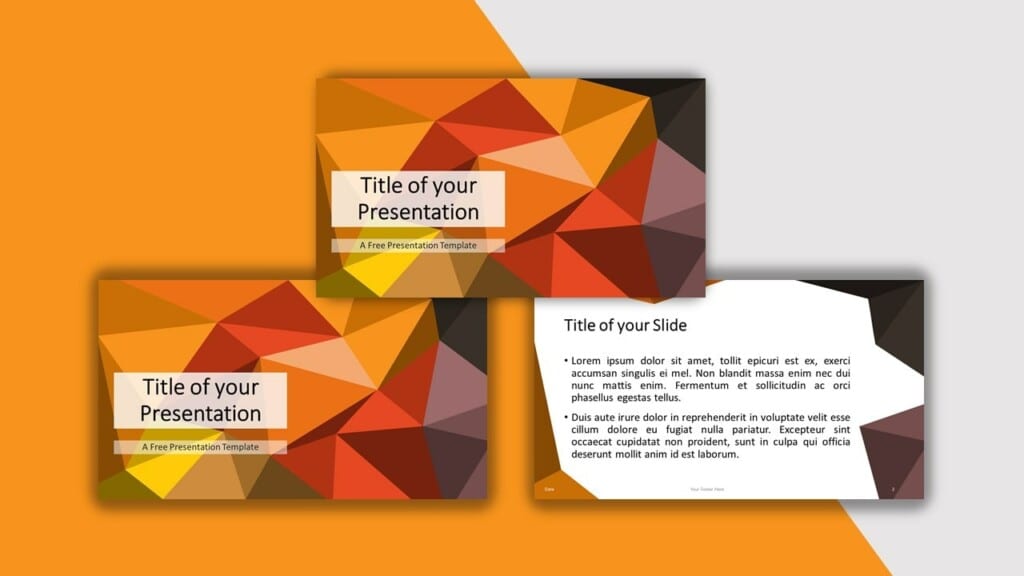
PURPLE – Great for luxury topics
Even though purple is an intense color that can surprise your audience, the right shade of purple can transmit creativity, wisdom or even mystery. This color can also give a sense wealth and luxury. It is a good choice if you want your background to be original.

BROWN – A warm and earthy color
This color is generally associated with the Earth and more specifically wood. A light brown color with a discreet wood texture could be a great option if your presentation includes environmental elements. Besides, it suggests the idea of durability.

GRAY – A formal yet modern color option
Forget about the negative connotations of gray ! It might be considered as a conservative color, but it is definitely a popular one. It offers a softer alternative to the white backgrounds.

BLACK – A powerful color to be used sparingly
It is well-known that black never goes out of fashion. Even though it is not the most popular color for backgrounds, it can be used to suggest elegance, luxury, and seriousness. It may not be ideal for a whole presentation, but black slides can easily be used to indicate a transition or make a powerful statement.

WHITE – The simple color option, when your message is King (as it always should)
The classic white background works ideally to evoke purity or simplicity. However, some people deem it as unoriginal. It is also tiring for the eyes when projected on a screen, therefore a light grey background is often considered a better option. Nonetheless, it helps get your message across clearly and simply.

2. Combine your colors attractively to please the eye
Some colors simply don’t match! Be careful when you associate the font color and the background one! For instance, blue and green are red’s worst friends. Two colors too close together on the spectrum, such as black and brown or red and orange, will make your presentation unattractive and hard to read. On the other hand, the right combination could convey the perfect message: dark blue and golden symbolize refinement while dark blue and white refer to the ocean and suggest tranquility.
You can obviously choose a basic color scheme: one hue for your background and another for your font. You can nonetheless try more complex combinations with 3 or more colors. In this case, check that the palette you use is pleasant to the eye and that it evokes the emotions you want to transmit.
A great example of color matching can be the 2021 Pantone colors the year : Illuminating yellow and Ultimate gray. The first is bright and vivid, the second firm and reliable; together, they represent strength and optimism.
3. Improve your readability with the right contrast
Establishing the right contrast between your background shade and your font color is essential. The basic rule is a light font over a dark background or a dark font over a light background. A high contrast means an optimal readability, and thus a high level of impact on your audience. To avoid having the same level of saturation in both colors, try to choose different hues and tones. For example, the pastel shade of a color will create a better visual impression when combined with the pure hue of another color.
One last piece of advice: if possible, always try to visualize your presentation on the screen where it will be projected, in order to check the final visual impression. Now you have another string to your bow: you are ready to consciously choose the right colors for your PowerPoint presentation!
We hope you like these tips. Your feedback is very important to us. Tell us what is (are) the color(s) you love to use in your presentations.

Search Blog by topics
Search templates by categories, search templates by colors.
Love our templates? Show your support with a coffee!
Thank you for fueling our creativity.
Charts & Diagrams
Text & Tables
Graphics & Metaphors
Timelines & Planning
Best-Ofs & Tips
Terms and Conditions
Privacy Statement
Cookie Policy
Digital Millennium Copyright Act (DMCA) Policy
© Copyright 2024 Ofeex | PRESENTATIONGO® is a registered trademark | All rights reserved.

To provide the best experiences, we and our partners use technologies like cookies to store and/or access device information. Consenting to these technologies will allow us and our partners to process personal data such as browsing behavior or unique IDs on this site and show (non-) personalized ads. Not consenting or withdrawing consent, may adversely affect certain features and functions.
Click below to consent to the above or make granular choices. Your choices will be applied to this site only. You can change your settings at any time, including withdrawing your consent, by using the toggles on the Cookie Policy, or by clicking on the manage consent button at the bottom of the screen.
Thank you for downloading this template!
Remember, you can use it for free but you have to attribute PresentationGO . For example, you can use the following text:
If you really like our free templates and want to thank/help us, you can:
Thank you for your support

- DrillMaster University

All About Posting or Presenting Colors
DrillMaster January 20, 2018 Ask DrillMaster , Color Guard/Color Team , Honor Guard , Honor Guard Training 145 Comments

There is quite a bit of information and several situations that every color team needs to know to maintain the American flag in the position of honor – on the marching right or in front. The American flag never marches any other position . Never . Military and para-military (just about every organization that has its members in uniform) should follow military guidance.
Never march the American flag in the center. The position of honor is to the right- not the center . All flags are marched so that the finial (top ornament, the spade) is as close to the same height as possible. All flagstaffs must also be the same length.

Color Guard Formations
There are only two authorized formations for a color guard. Only two, Line Formation and Column Formation. Everyone who has served even a day in the military is familiar with both. We fall-in for a formation in line formation and when we are going to march somewhere, the formation is given Right Face into column formation and we can then march any necessary distance.

Notice in the graphic above that Inverted Line and Column Formations takes the American flag out of the position of honor. A color guard can never perform these two formations. Never.
What Flags do we Carry and in what Order?

Military, Civil and Citizen teams have different requirements. The colors listed are in order from the marching right (viewer’s left):
- All services must always march with their service color, it may not be replaced by any other flag.
- The Army is authorized to add a state, territory or foreign national color (only one) and can carry up to four flags, the rest being unit colors. Read here for more information .
- The Marine Corps, Navy, and Coast Guard are only authorized to carry the National Ensign and the service color. They may add another three-man color guard for a foreign national or US territory color only. Read here for more information .
- The Air Force and Space Force are authorized to add a state, territory or foreign national color (only one) and can carry up to four flags, the rest being unit colors. Read here for more information .
- Civil teams (law enforcement, firefighters, and EMS) carry the American, state, municipal, organizational and even fraternal colors. The fraternal color can be omitted when presenting for local government functions.
- Tribal teams , on Tribal lands, would carry the Tribal Nation’s color, American, and state colors. Outside of Tribal lands, the American would be first and then the Tribal Nation’s color. Some Tribal teams also carry service colors.
Side note: When an Army, Air Force, or Space Force color team carries the following colors, this is the order. No exceptions.
- American flag
- Foreign national, state, or territory flag (in that order)
- Military departmental flag
- (Unit flag)
Please read The Why of the Military Color Guard series of posts.
Carrying More Than One National Flag?
Let’s say you are part of an Emerald Society Pipe and Drum Corps and Honor Guard (a first responder fraternity). Many of these teams carry not only the American flag, but also the Irish flag. Why? The first law enforcement officers and firefighters were Irish. The tradition continues. Back to our situation of two national flags: All national flags are treated the same on American soil – they are not dipped in salute. Both remain upright even during both national anthems, if they are played. All other colors dip in salute.
Joint Service Order for Military Colors
This is the only order for service flags, service emblems, etc. For more information on why this is the order, click here to read Joint Service Order of the Colors . The right/lead rifle guard is a Soldier and the left/rear guard is a Marine.
- Right rifle guard, Army
- Marine Corps
- Space Force
- Coast Guard
- Left rifle guard, Marine Corps
Note: While service color position remains the same, if all service personnel are not able to be present for the team, their order should go as follows as far as knowledge is concerned: regardless of service or rank, the most knowledgeable (as far as color guard experience) member should be the US color bearer and the second most knowledgeable should be the right rifle guard. Third in this sequence should be the left rifle guard with descending familiarity following from there.
Joint Service Order for First Responders
Full disclosure: I developed this. While this is not a hard-and-fast rule, I thought it necessary to create an order of precedence based on the implementation of each service. Read this for complete first responder joint service information :
- Law enforcement officer (LEO)
Using the guidance from the military, team make up might look like this:
- Right/lead rifle guard: LEO armed with a rifle/shotgun, second-most experienced member
- American flag: LEO, most experienced member
- Other flag (State, etc.): Firefighter/EMS, can be least in experience
- Left/rear guard: Firefighter/EMS armed with a ceremonial fire axe, third in experience
Keep in mind the guidance that the most experienced member should be the US color bearer, regardless of service/profession.
LEO/Fire/EMS Working Together
I encourage and enjoy joint work, but there is an issue that must be addressed: Technique.
What about Military and Civil working together?
Nothing addresses this subject specifically. However, we don’t necessarily read manuals to see what is forbidden or not authorized as that would be a never ending list, we look to the service manuals for what is authorized and we have our answer already. Military sticks with military and that’s it.
What About the Uniform?
For the military, the Class A or ceremonial uniform is it. On base, the utility uniform is an option but only if the official party is wearing it. Never wear mess dress. For more read this article .
Does Height Matter?
Experience before aesthetics , always . Not if you have the luxury of each member of the team being around the same height, but for cadet and civil teams, it should come second to knowledge and experience. Yes, the team might look “off”, but it’s best to have knowledgeable members of the team in key positions rather than have aesthetics. Click here and read this article .
Flag Stuck, etc.?
Problem during the Performance? That’s why God invented the right and left guards for the team! The guards are there to fix whatever issue they can. For more, read this article here .
Hangin’ Around
Waiting for the ceremony still requires proper protocol.
- Arrive at the site at least one hour early
- Practice while in your travel uniform (this ensures no one thinks the ceremony has already begun and gives the team time to figure out their movements)
- Change into ceremonial/Class A uniform
- Hang out* with equipment ready in-hand and all team members in their proper place (American flag at right or in front of other flags- yes, even just hanging around – cameras are everywhere)
- Ten minutes prior to show time, line up at staging position at Stand at Ease (or Parade Rest) ready to perform
*An example of how NOT to stand around. This is a USAF Base Honor Guard team, I have pictures of other services, this is just an example.

Sporting Events
For horse and ice rink arenas, see The Arena/Rink Colors Presentation article .
For baseball, basketball, football/soccer, see this article and this article .

Left Wheel, Right Wheel and About Wheel . These are terms that honor guards use to describe turns accomplished by the color team most often outside. Right/Left Wheels use the center of the team as the rotation point which means half the team marches forward and the other half marches backward to rotate the team 90-degrees in an average of eight steps for teams with four to six members.
This is joint service technique from the Marine Corps and ceremonial technique. The Army Wheel is just like the Marine Corps Turn with the rotation point on the guard position.

The team executes the About Wheel in the same direction as the Right Wheel rotating the team 180-degrees in 16 steps.
Posting/Presenting
While colors can be and sometimes are posted outdoors (read that link), my experience leads me to recommend that you present and not post. The wind just never plays well with other others. We, in the military try to avoid this as much as possible with the alternative being a color team that posts near the podium for the event. The members present and then stage the team for everyone to see. Sometimes this may not be a viable solution and you will have to have the event and location dictate how the color team handles the colors. See also, How to Present the Colors at an Event , What is Authorized when Presenting the Colors , and How to Plan and Coordinate a Color Guard Event . This article, How to Present the Colors at an Event , has great information.
Note: As a rule of thumb, colors enter at Right Shoulder (Carry) and depart at Port Arms. Entering at Port is fine if necessary.
- Halt in front of and facing audience
- Present Arms for (foreign national anthem and then) the Star Spangled Banner or Pledge of Allegiance (not both see the next paragraph)
- (Color bearers move to post colors and rejoin guards)
The Announcement
“Ladies and gentlemen, please rise for the presentation (and posting) of the colors.” Every time a color guard presents the colors, it’s called a presentation. At a formal event, the colors may be placed in stands, that is posting. The colors will always be presented, just not always posted.
Music to Present to
Why not both the anthem and pledge.
Having both is not necessary. The Star-Spangled Banner is a salute to the flag and we render the military hand salute, stand at attention, or place our right hand over our heart, and dip flags.
We will not find anything that specifically forbids having the Star Spangled Banner played or sung and then having the Pledge of Allegiance in the same ceremony. The military oath supersedes the Pledge from our first day of Active Duty so we in the military hardly ever recite the Pledge if at all. There are times we do recite it and that is explained in our protocol manuals. What we read in TC 3-21.5 (MCO 5060.20 and AFMAN 36-2203) and related manuals is that the only music to honor the flag is the national anthem.
If you are told that the anthem and Pledge will be part of a ceremony and have no say, a great way to facilitate that is to formally present the colors, go to Present for the anthem, (post the colors- for more formal ceremonies,) and then have the color guard depart. Once the team is off stage, the audience can be led through the Pledge.
If the point of contact insists on both the anthem and Pledge and the team remaining for both, have the team return to Carry/Right Shoulder and remain for the Pledge. After recitation, the team departs at Port (Port, ARMS; Colors, Colors Turn, HARCH).
Music Played on Entrance and Exit
A military march can be played for the color guard when entering and exiting and no other time. The usual music for military color guards is the Trio section of the National Emblem March. T his YouTube video from the US Navy Band is perfect (also below) and at the correct tempo (around 90 beats per minute is best when presenting/posting indoors). If you have a live band, you can coordinate when to cut the music off. If you play this or another recording, you can halt and let the music play out. If you can get in place before the repeat, please don’t let the whole thing play while everyone stands around waiting for the music to end.
Dipping Flags to the Pledge
US military departmental and organizational flags do not dip for the Pledge. The same goes for the JROTC organizational flag, which is dipped in salute in all military ceremonies while the national anthem of the United States, “To the Colors,” or a foreign national anthem is played, when rendering honors to the Chief of Staff or Secretary of a US military branch, his or her direct representative, or an individual of higher grade, including a foreign dignitary of equivalent or higher grade. Organizational colors are also dipped when rendering honors to organizations and individuals for which the military ceremony is being conducted.
What about other organizational (veteran groups and first responders) and state flags? Dipping state, territory, city, and county flags along with private/national organization and law enforcement, fire, and EMS department flags is appropriate.
Foreign Anthems?
Foreign national anthems are played first and the Star-Spangled Banner is played last. An example of this is a Canadian hockey or baseball teams plays an American team here in the USA. If the American team traveled to Canada, the Star-Spangled Banner would be first with Oh Canada! played last.
Other Music?
While there may be other anthems representing certain people groups, they are not afforded the same protocol as a national anthem. The public is not required to stand or place their hand over their heart. Let’s take the Black Anthem as an example.
While I am in no way suggesting disrespect should be shown to a piece of music that may have meaning to a number of people, it is not at the same level as a national anthem and is not accorded the protocol of standing and placing the right hand over the heart, a military hand salute, or even the color guard going to Present Arms with the rifle guards at the position of Present and the non-national flag dipped forward. If this other music is played, the color guard should only stand at the position of Attention if on the court/field and after that music has finished, the commander of the team gives “Present, ARMS!” and the Star-Spangled Banner is then played or sung.
The announcer can say, “Ladies and gentlemen, the Black Anthem.” After it is finished the announcer should say, “Ladies and gentlemen, please rise, (men remove your hats, and place your right hand over your heart) for the Star-Spangled Banner.” Here is where the color guard would go to Present Arms and the anthem would then begin. The Star-Spangled Banner must be last.
Standard Entrance and Departure

To Present or Post, that is the Question!
Posting the colors is for special occasions. How special? That is up to the organization. Graduations are a special time, that would call for posting the colors. Weekly events would probably warrant pre-posted colors at the least or presenting the colors only.
The Show-n-Go . This is the honor guard term for presenting the colors for an informal/semi-formal event. The colors are pre-posted on the stage/front of the room and the color team enters, formally presents (Anthem), and then departs. No posting.
This happens at all sporting events where a color guard enters the field and should be a regular occurrence for every color guard in the USA and Americans abroad. Formally presenting is reserved for formal events.
With the Show-n-Go, the colors do not matter. As long as the American flag pre-posted, the color team can present whatever they carry as their standard colors (American, State, etc.).
How to Enter
The standard entrance is to enter from the viewer’s right, present to the audience (then post) and depart. See the image above.
To enter from the viewer’s left, use Every Left On . Also, read this article . This avoids Inverted Line Formation explained above.

Flag Stand Positions
Below, is an example of different stand positions behind a podium. For more on which flags should be in which stands, read this article on The Logical Separation of Colors .

How to Exit
The standard exit is to the viewer’s left. See the standard entrance/departure image above.
To exit to the viewer’s right, use Every Left Off . The commander calls, “Step!” and the left rifle guard steps across, as close as possible to the team member on their left. Step any further away and the departure for the team looks terrible.

Asked to post another organization’s color(s)? Don’t! Read this !
Entering and Departing to Music
Music is not mandatory. If you are going to have music, it is best that it be live. If not, a recording can sound quite unprofessional. The standard entrance and exit music for presenting/posting the colors is the Trio section of the National Emblem march by Edwin Eugene Bagley. Here is the YouTube video of the USAF Heritage Band playing the march. The link begins the video at the Trio section . This tempo is about 120 SPM (steps per minute). For the colors, you want a tempo of about 90 SPM.
When to Retire/Retrieve the Colors
Retrieving the colors is reserved for the extra, extra formal occasions. Do not retire the colors for weekly or even monthly meetings. Retirement is for very formal galas or balls. Use the posting sequence in reverse.
- Color bearers retrieve colors and rejoin guards
- Present Arms for a few seconds ( military flags do not dip )
Share this:
Comments 145.
Thanks for a great article. During a Navy ceremony when colors are paraded, does the MC also render a hand-salute?
Yes sir, that would be appropriate.
Copy. Thanks DrillMaster.
In a similar vein, my pastor has asked me to carry and hold the flag during a short Memorial Day remembrance during our upcoming Sunday service (I’m a veteran). He wants to play Taps, and has asked me to dip the flag while Taps is played. I’m aware the Flag Code stipulates the flag should never be dipped — would there ever be an exception to this rule for a religiously-themed Memorial remembrance such as this? Thanks
Sir, I have been scouring the Internet for the proper sequence (if there is even a proper sequence). As I remember it, while on active duty, when Posting the Colours / Retiring the Colours for a formal military event (All Academy Ball, as an example), the sequence is Invocation, Post, Retire, Benediction. Is this correct or does it even matter?
SFC Loewen,
It’s not mandatory to have a colors presentation. Colors can be preposted and no color guard present if there is no room or other circumstance.
For some situations: Colors preposted Star-Spangled Banner (played or sung) Invocation Ceremony Benediction
For most situations: One set of colors preposted and another set carried for a formal presentation (show-n-go) Star-Spangled Banner (played or sung) Departure of the color guard Invocation Ceremony Benediction
For formal situations: Colors presentation Star-Spangled Banner (played or sung) [posting of the colors] Departure of the color guard Invocation Ceremony Benediction
For very formal situations: Colors presentation Star-Spangled Banner (played or sung) Posting of the colors Departure of the color guard Invocation Ceremony Benediction Color guard retrieves colors Honors to the American flag
I hope this is helpful.
I am writing the script for a promotion ceremony. We intend to use the show-n-go method. Flags will already be posted on stage and the color guard will present the colors, National Anthem will be performed, and the color guard will exit, followed by the invocation. I am looking for the proper commands. Please advise on the below: MC: “Honor Guard, parade the Colors!”
[Honor Guard presents the Colors.] [SSG approaches and sings National Anthem.]
[Following National Anthem, SSG returns to seat]
MC: “Retire the Colors.” [Is this correct, or does the honor guard march the colors back down the isle without a command from the MC?]
[Honor Guard marches the colors to the back of the room and MSG will be preparing to come on stage to podium and provide invocation]
MC: “Ladies and Gentlemen, please remain standing for the invocation by retired Master Sergeant XX.”
The MC should say, “Ladies and gentlemen, please rise for the (entrance of the official party,) presentation of the colors and remain standing for the singing of the Star-Spangled Banner by SSG X, the departure of the color guard, and the invocation.”
That’s a bit for the audience to remember, so you can cut it into pieces.
The soloist waits for the color guard commander to give Present, Arms, and then begins to sing.
When the singing monsters s finished, the color guard departs on its own, no prompt given. As soon as the team is out of site (through a doorway), then the invocation.
If hope that’s helpful for you.
Would this be correct: Ladies and gentlemen, please rise for the Knights of Columbus (insert Council name/number) and the presentation of the colors and remain standing for the singing of the Star-Spangled Banner by SSG X, the departure of the color guard.
Yes, adding a personalization is fine.
Hello, forgive me if I thought wrong. I thought the our American flag would be vertically straight toward heaven and all others would be dipped forward at 30 degrees or so. I thought that was the place of honor. Thank you.
Mr. Venzke,
The position of honor is on the marching right for the a colors guard. The American flag is ALWAYS on the marching right in Line Formation and at the front in Column Formation. It is never anywhere else. The Army, Air Force, and Space Force require a “slight” angle forward for the staffs while the other services require the staffs to be vertical.
All staffs match in direction at all times except for Present Arms/Eyes Right. For that, all organizational flags dip with a full arm extension. If more than one flagstaff is dipped, those staff angles also match.
That’s the standard for the US military.
When doing a closing flag ceremony (I’m a Cub Scout Den Leader), when the flag bearers have retrieved the flags and are told to return to ranks, do they go to what is now the back of the line upon exiting or in the front of the line after the color guard has done an about face toward the back of the room. We use a two column formation. We generally have however many scouts are in a den participate as the color guard so everyone has a chance to be in the ceremony. I can find all kinds of videos online with the opening indoor ceremony, but not closing.
Ma’am,
Color guard members do not execute About Face to (To the) Rear March.
There are several ways to enter and depart with the flags that are shown above. The color guard (in your case your two flag bearers and, if you choose, two unarmed guards) usually keep to themselves not joining the rest of the membership until after the colors are secured. The bearers should go and put the colors up and then can return to the others, but retrieval of the flags is the last thing that takes place, there’s nothing accomplished after (unless it’s a formal event where there will be dancing). I’m not sure if this is helpful.
Rotaton of flag bearers through den membership is a very good idea as it promotes better understanding of responsibilities we have toward rendering honor and respect to out flag.
I am a member of a law enforcement HG. We are often short on members due to shift work, court and other requirements. We normally have four members to post colors, however is it ever acceptable to post with two and not have guards?
I just talked about this on my social media. Here’s the text from that post.
Sent in with a question: Aren’t the colors always escorted/guarded?
The answer is yes and there are exceptions. I’ll explain. For the military, yes, absolutely all the time the flag(s) will have two guards. First responders are paramilitary and should follow the same principle, but they don’t always have the manning in their honor guard team at many departments across the country. So, for representation, some teams march flags-only.
To add to that, scout programs do not carry a weapon, so if the team even has guards, they are unarmed.
Guards are not mandatory for civilian and civil teams because the Flag Code does not make that a requirement. Only the military manuals make it a requirement and that only applies to the military.
I hope that helps.
Good morning and thank you for this wonderful information. I cannot find a page that addresses who gets honors at a funeral. For example we have a Commonwealth Attorney who has recently passed. Technically he was considered “the highest law enforcement official” in the Commonwealth since they have law enforcement powers. He was retired from his position at the time of his passing… would a color guard be appropriate?
Having a law enforcement agency honor guard post a color guard for the graveside service is appropriate, if they have the time and manning.
Since he did not die while in office, there isn’t a protocol to support his funeral.
Is it ok for a civilian group…..no military affiliation nor civil, to have a flag presentation for members returning from an Honor Flight? To me it seems wrong and a plain civilian should only have the little hand waving flags. Please advise.
Mr. Resing,
While not necessarily “wrong”, I do see your point. Having said that not just anyone who wears a uniform should think it proper to pick up a flagstaff or rifle and think they are being patriotic without training and practice. It would certainly be inappropriate to have a fast-food restaurant throw four employees together in a color guard just because. That definitely seems wrong.
What standards will this civilian team follow? What training do that have? While the Flag Code sets forth the basis, the military takes standards much further. Finally, why? Why does this group of Americans find it necessary to pull out flagstaffs (and rifles) and not have one of the organizations mentioned below invited to render honors? Why not, as you have written, pick up small flags and wave them as we see many of our fellow Americans do at many parades. Americans take part in patriotic occasions all the time, I see no need for a group of civilians to try to do something others have been doing for decades as part of their job.
I would hope that color guards would be left to the military, cadets, first responders, and veteran organizations.
I am making a bulletin for a funeral at my church. The deceased is a veteran. We will have an honor guard from the Air Force base to play Taps and present a flag to the widow. What should this be called in the order of worship?
Thank you for your time,
Whether graveside or in the church, the religious service usually happens first followed by Military Honors. Military Honors consists of a firing party firing the Three Volley Salute and the sounding of Taps. For Veteran Funeral Honors, most often the military provides two service members to fold the flag and then sound Taps (in that order). You still call this Military Honors.
How would you recommend we handle a memorial service that is NOT part of a funeral? My church is hosting a memorial service for my dad but he will not be buried until much later. Is it appropriate to post colors in a situation like that? How would you handle it? Thanks very much
My condolences to you and your family on the passing of your father.
While the military, including veteran organizations, cannot render honors more than once (presentation of the flag, firing party, and Taps), the community/church membership can have the colors present for the memorial and have a nice service that centers around the stories each one can tell, a less formal occasion. Then, when the time comes to bury the deceased, the formal military honors can be performed.
That’s how I see it. I hope that is helpful for you.
The VFW and American Legion are conducting a Veteran’s Dinner. The local JROTC will post the colors at the beginning of the dinner but the colors will not be retrieved prior to the dinner ending. What is the protocol when not retrieving the colors? Does the National Anthem get played? As the Master of Ceremonies do I just announce an end to the formal portion of the dinner followed by attendees either staying to socialize or leaving the building?
The Star-Spangled Banner is only played or sung on the presentation of the colors and that is always at the beginning of a ceremony.
The colors are posted at formal occasions and retrieved only at very, very formal occasions.
At the end of the formal part of the evening, you can simply announce that and that guests are invited to socialize (and that the dance floor is open) for the rest of the night.
Good evening,
Recently my colorguard was performing at a high school football game. Do to some technical problems they couldn’t play the National anthem so they did a moment of silence. In the moment I kept my CG at present during the moment of silence. If this happens again what is the proper way to go about it?
First of all, you did an excellent job at the spur of the moment thinking. If you know there’s a technical issue at the outset, march on, guards go to Present on your command and that’s it. The departmental or organizational flag would not dip since it would only dip for the Star-Spangled Banner. I hope you are aware that military flags don’t dip every time you give the command to Present.
If a technical problem happens in the moment, just use your best judgment again.
Drillmaster,
Is there a certain requirement for the color guard on number of members for nber of flags being raised? We are a Girl scout group that dies regular flag ceremonies at annual girl scout events seasonally and we include the US flag, the state flag and the GS flag, it has come under question recently if there should be at least a certain number of girls in the color guard for that number of flags. Any information would be greatly appreciated!!
Thank you!!
There’s no requirement other than one color bearer per color. That’s it. If you want to provide guards to march at either end, you most certainly may. Civilian organizations like Scouts are not required to provide anything else.
I know this question may make someone’s eye twitch, but can veterans perform color guard duties in civilian clothes for an informal event? Over the past 15+ years, a local organization has had a very successful veteran golf outing which included a color guard to kick it off. There has always been support by either a local National Guard or Reserve unit, VFW post, or American Legion post (all in uniform). This year we have completely exhausted trying to find a group that can do it. We have veterans who are golfing who have volunteered to do the color guard, but only 1 still has a dress uniform (which doesn’t fit well). We’d still like to continue the tradition, but I don’t want anyone having heart attacks when they see 4 guys in polos and shorts posting the colors. Thanks for any insight…
No eye twitching here. What you describe sounds like the perfect solution. Four guys in polo shirts and shorts (a uniform of sorts) presenting the colors just before the golf tournament in which they will participate works.
I am organizing a parade in a small town of Arkansas. I would like to include a color guard. I’m wondering whom I could contact to arrange this. Any information you could provide would be helpful. Thank you & thank you for your service.
Ms. Pierron,
Your local police department, sheriff’s office, fire department, veteran group, and high school JROTC are all liable to have a color guard each.
RE: White Gloves
I’ve heard that white gloves are only to be worn with long sleeve uniform. I’ve also heard that they may be worn with short sleeve as well. Which is it? Both? Is there a proper white glove etiquette?
Traditionally, military members have always presented the colors in the Class A or ceremonial uniform and both only have long sleeves. This is probably where the “white gloves are only worn with long sleeves” idea comes from. There’s no rule that I’m aware of. It is best, however, to tuck the sleeve of the glove into the the hand so that the glove’s crease is at the wrist. That presents a professional image. DM
I belong to a Veterans Group and we are having our 40th. Anniversary. I need some help on placing the following flags
American Pow/Mia Org flag Agent Orange
Any assistance would be so appreciated.
Mr. Davison,
As you look at the flags (audience’s perspective), the American will be on your left, (state flag goes here, if you choose to display it,) the organization’s flag is next (at the American’s left, viewer’s right), the Agent Orange flag, and then last is the POW/MIA flag.
Please let me know if you have any further questions.
I am the clerk of the school board for a school system in Virginia. Our board holds twice-monthly meetings. We have five high schools in our county, so on a rotational basis we have a high school JROTC color guard unit come in to present the colors for our Pledge of Allegiance at each board meeting.
I have no military background myself, so please forgive my ignorance about protocols. My question for you is this: How should I refer to the color guard unit’s presentation? Is it “posting” of the colors or is it “presentation” of the colors? (Or something else?)
We’re located next door to Quantico. Out of respect for our local military families, I want to be accurate in how I refer to the color guard presentation on our meeting agendas. Thanks in advance for your help.
Sir/Ma’am,
I very much appreciate you wanting to use the correct terminology. I just updated the article to include that information and I’ll provide it for you here.
All colors presentations are a Presentation. When the occasion is more formal, the colors are posted. Your meetings are not in the formal category, so your announcement would be, “Ladies and gentlemen, please rise for the presentation of the colors by XYZ high school Junior ROTC.”
Again, thank you for your attention to detail!
At the beginning of our University’s Women’s Basketball game, it has been customary that an ROTC Color Guard enter the Arena, formally, and present the Colors, followed by the National Anthem. During the first game of this season, the Color Guard entered , as usual. The PA announcer directed the audience to join in the playing of the Black Anthem, which was followed by the National Anthem. The audience was standing, holding their right hands on their hearts, expecting the National Anthem. The Black Anthem is a beautiful song with inspirational lyrics, but is it expected that the audience be showing the same respect by standing as if the National Anthem was being played?
Thank you for your question. From a protocol standpoint, the public is asked to stand for national anthems. These anthems represent nations and not just people based on any other factor (language, skin color, etc.). It is respectful to stand for the anthems of friendly foreign countries at sporting events in the USA where a Canadian or Mexican team might play an American team. The foreign anthem is played first and the home anthem, our Star-Spangled Banner is this case, is played last.
The announcer can say, “Ladies and gentlemen, the Black Anthem.” After it is finished the announcer should say, “Ladies and gentlemen, please rise, (men remove your hats, and place your right hand over your heart) for the Star-Spangled Banner.” Here is where the color guard would go to Present Arms and the anthem would then begin.
I hope you find this helpful. Protocol and military standards are both very specific.
Hi DrillMaster,
First, thanks for a wonderful website and your time in effort maintaining it.
I am an adult leader and our Boy Scout Troop has been asked to provide the color guard to present the colors for the Veteran’s Day opening day ceremony of our chartered organization school. I’ve read about what you describe as a Show-n-Go, which is what they are asking for. This will take place in the school courtyard where no colors are previously posted. Our Scouts (both Boy Scouts and Cub Scouts) will be in Class-As.
Our color guard would use our American flag on our flag pole. They would enter from audience front left, walk to the center, pivot right, go up some stairs and then use Every Left On to present the colors on the right of the speaker. The Cub Scouts would lead in Pledge of Allegiance, then the school would sing the Star Spangled Banner. Finally we would exit.
I’ve only previously posted colors for our weekly Troop meetings or seen color guard posting colors at Summer Camp.
How does this sound? Anything to improve or change? What would an example script look like for something like this look like?
Thanks for your help!
Sir, Excellent plan!! I’m very impressed that you have read so much of my website and then formulated the process that fits your situation best. Well done! The script might go:
Announer: ladies and gentlemen, please rise for the presentation of the colors, the Pledge of Allegiance, and the (playing/singing of the) Star-Spangled Banner.
Colors enter and post.
Pledge and anthem. (Note, both are not necessary. The anthem takes precedence.)
Colors depart.
Announcer: please be seated.
I hope that’s helpful and that you and your Scouts have a great time.
Our Girl Scout troop is excited to participate in their school’s Veterans Day program and has the honor of being the Color Guard. This will be the girls second time and they take this very seriously. The teacher responsible for coordinating the program has requested they both raise the flag and present the Colors. My concern is there is no official “protocol” for this and we may inadvertently offend someone or disrespect the flag/Veterans in attendance in some way by doing this.
Is there a protocol for this? Or should we respectfully push back on doing both? Your guidance is greatly appreciated.
Girl Scout troop leader
Ms. DeLoach,
What a great opportunity for your girls!
There isn’t a protocol problem with having both, but it is out of the norm.
For the colors presentation, the Star-Spangled Banner is played and for the flag raising (called a Flag Detail), the anthem is also played. I suggest only the Flag Detail for this reason.
You can present the colors, have the team remain, bring the Flag Detail in, but if you don’t have enough members to do both simultaneously, the color guard can present and depart.
Please let me know if you require any information specific to the color guard or Flag Detail. I’m more than happy to assist.
I am the director of a community youth choir and we are presenting a Veteran’s Day Concert in a few weeks. I have invited a color guard to present the flags to open the program. I am planning to follow with the Star Spangled Banner. Should the flags be presented in a quiet auditorium or with music in the background? Also, once the flags are on stage should they be retired at the end of the program since this is not a formal event? I’ve read many comments but wasn’t sure. I was wondering about having taps played at the end of the program following a song which honors our veterans. The reason was to honor friends and family of our veterans who may no longer be with us. A veteran told me this should be all right. Is this appropriate (I understand Memorial Day is in memory of those we’ve lost) and should taps be played before flags are retired if at all? I am putting the program together and wanted to make sure we were following correct protocol. Thank you!
Ms. Hesinch,
What a thoughtful question. I appreciate it when my fellow Americans care about doing the right thing.
Here is my suggestion for you to begin the program: Announcer: “Ladies and gentlemen, we will begin in just a few minutes. Please silence all cell phones.” The color guard posts to their staging position and stands at Parade Rest. At the scheduled time: “Ladies and gentlemen, please rise for the presentation (posting) of the colors.” This is the cue for the color guard to come to Attention, Carry Colors, and to march forward to center on the audience (on stage). Background music is not appropriate but the Trio section of National Emblem is a great military standard. You can find it here: href=”https://youtu.be/xJGATbPTy7E” title=”Trio to National Emblem” rel=”noopener” target=”_blank”> the link opens a new tab in your browser. Playing this section of the march (this slowly) can be very awkward for color guard members who do not have experience. If the team has not marched to music before, I suggest silence.
When the team commander gives “Present Arms!” (it needs to be a loud command), that’s when the Star-Spangled banner is played. When then the music finishes, the team can depart if an American flag is already in view, or they can post the flags in stands on the stage. Once the team posts the flags, they depart and the announcer tells the audience: “Please be seated.”
The lack of formality of the event requires the flags to not be formally retired. The color guard can informally gather the flags after the event is finished. Flags are only retired at “white tie” type events and those are quite rare.
Veterans Day recognizes living veterans, we do not collectively mourn the loss of veterans who have died on this day. It is inappropriate to sound (not play) Taps for the event. The veteran who told you it would be alright is incorrect. Taps is sounded for deceased veterans at their funerals, they are recognized then. As you noted, Memorial Day is for the veterans who did not return home alive and Taps is appropriate then.
Please let me know if you have any further questions and, again, thank you for being diligent in seeking to follow protocol.
Thank you! Your response is very helpful and much appreciated!
Is it ok to present the colors in a uniform other than dress uniform? For example OCPs (Operationl Camouflage pattern)?
The color guard should be in the same uniform as the official party. On a military installation, presenting in the utility uniform can be perfectly accessible. Off base, it’s not a good choice. Class A should be the standard.
What would be the appropriate way to present an Armed Forces Color Guard and a foreign national flag at an event.
The Army, Air Force, and Space Force, according to their regulations, can include the foreign national flag in the formation.
The Marine Corps, Navy, and Coast Guard, according to their regulations, must have a separate three-man team to carry the foreign national flag.
So, whichever standards you follow, or, if you are a mixed (veteran) group, choose to follow, you are covered.
Thank you for the response. To elaborate it is an active duty Armed Forces Color Guard (9 Person with all services). I’ve heard that with joint service teams the senior service manual is used, however I haven’t seen any clear guidance or regulations for Joint Service Color Guards.
The joint service color guard made up of the service honor guard units in and around Washington DC use the Army ceremonial techniques.
The same goes for any time two or three teams perform at the same ceremony. The senior service always leads.
From this we can take note that the senior service is the one to follow.
Hello, we are wanting to have a flag posting for the first day of school, we have two options for an outdoors ceremony: Have color guard advance with folded standard which is then presented and then hoisted, recite pledge, and then sing school song. OR; Have standard posted on outdoor pole, and then have color guard advance with U.S. flag and school flag, present the colors, say pledge, sing school song, and then dismiss flags, then carry on the rest of the ceremony. Which would be the best alternative? And perhaps the wording of the best alternative-“please stand for the presentation of the colors”, etc.
Mrs Peterson,
Thank you for your question. What great ideas!
Your first idea is for a Flag Detail (not called a color guard). The flag detail brings in the national (state, school) with one bearer per flag and two team members to work the halyard. I would stick with just raising the national on one pole if you have separate poles and then raise the others after the ceremony or, if you have one pole and two flags, that would work just as easily. The procedure would be: Announcer- “Ladies and gentlemen, please rise for the advancement and raising of our national flag (nation’s colors).” Everyone stands, flag detail enters, attaches flag, commander gives “Present, ARMS”, flag is raised to the top, halyard secured, halyard bearers salute, commander gives “Order, ARMS”. Flag Detail remains at pole (can be dismissed, but adds to the timing and can seem awkward for what follows). Announcer-“Please join in the Pledge of Allegiance.” Recitation. Sing school song. Dismissal. If you are going to have the color guard, same procedure as above except for the following. Announcer- “Ladies and gentlemen, please rise for the presentation of the colors.” Color guard is centered and facing the audience, commander gives “Present, ARMS”. Pledge, song. Announcer- “Ladies and gentlemen, please rise for the dismissal of the colors.”
If everyone is standing and no one is seated, then the announcement could be, “Ladies and gentlemen, please direct your attention to the front (flag pole) for the…”
I hope that helps. Please let me know if you have any further questions.
Our City is organizing a 9/11 event and would like our Color Guard team to perform. We are always first up to start off any event we attend. They have us scheduled for the end. What is your take on that? Thank you!
MSgt Piccolo,
Thank you for your question. I first thought you were going to say that the team would be second, maybe third, but last?
It’s quite possible that another color guard will formally present the colors for the anthem and that your team will have a special presentation (akin to retrieving the colors possibly) to close out the event.
I know that many event organizers try to include as many local organizations as possible and even rotate through these organizations for yearly events.
I do think you should contact those in charge and see what their thinking is and how your team fits in as presenting last is unusual. You want to guard against thinking that puts the honor of the flag and the team at risk.
Please let me know what happens as I am quite curious!
Dear sirs We are having a family reunion and would like to have a flag presentation of some kind. We have no scout troops and no one in uniform. What would be acceptable.
May I suggest either mount the flag on a building or post or have a pole, permanent or temporary, in the ground and raise the flag and have everyone recite the Pledge.
OK US Flag is prePosted at stage on left about fron left of table-podium with Eagle facing away from assembly. To present or is it Post the colors, they rotate the Eagle towards the assembly. And we salute during the Turning saying “PRESENT ARMS” then when done say “TWO”.
We are being told that US Flag should be PUSHED BACK away from Podium-Table to RETIRE IT?
Where is this WRITTEN as FLAG ETIQUETTE? To Move US FLAG forward to Front of Podium-Table at beginning of a Meeting and then Push it Back to RETIRE it? This has caused some negative comments as to what is the right way to PRESENT prePosted US Flag and then to RETIRE a PrePosted US FLAG???? I trust my questions about situation makes sense as to how to CORRECTLY prsent and retire a prePOSTED US FLAG. Thanks.
Neither rotating nor pushing a posted flag back and forth has anything to do with flag etiquette. Whoever thought this up did just that- thought it up. It has no basis in reality as far as protocol is concerned.
Posting a flag means to bring it before an audience, present it with the Star-Spangled Banner, post it and have the individual depart. The Pledge can be a substitute, but is usually for civilian audiences. Military audiences use the national anthem since our oath covers us for life.
To retire the colors means the opposite: to retrieve the flag, salute it, and have the flag leave the presence of the audience.
The commands for rendering a salute are: “Present, ARMS!” and then “Order, ARMS!” that is the Army, Air Force, and Space Force technique. “Hand, SALUTE!” followed by “Ready, TWO!” are the commands that the Marine Corps, Navy, and Coast Guard use. You are mixing the two and using an incomplete command.
Having a preposted flag is just fine. It should not be rotated, pushed forward, or pushed backward. As long as the flag has a prominent place during your meetings, you are following protocol. Any other time, the flag can be less prominent- pushed back to the rear of the stage.
I hope this helps. DM
Hello, Recently I was at a High School Graduation and the U.S. Flag was present on stage along with the state flag. Before the graduation started the color guard marched in with the U.S. Flag and state. The National Anthem was played and the color guard marched out with the U.S. Flag and state. Is this proper, to have two U.S. Fags present?
This is a great question, thank you for it.
I have recently found out that some believe having two American flags at the same ceremony is somehow inappropriate. I don’t know where this idea comes from but it’s not true.
What you saw is called a show-n-go in the ceremonial drill world and is perfectly acceptable. It’s performed when posting the colors would be too formal and a school graduation is not a formal enough occasion.
I hope this answers your question satisfactorily.
We may have an event where one set of flags (American flag and two organizational flags) will be pre-posted and one will be posted by the color guard. I am directing the color guard, but I am *very* low pay-grade, and this is a national organization. Our Administrator will be there. I am urging a show-and-go, but I’m not optimistic. If we *must* post the colors, where should the pre-posted colors be, and where should we post? I’m thinking pre-posted on their own left and posting on their own right. There will be a stage. Would it be better to have the pre-posted flags on the stage? If so, do we post to the left or would splitting be better (American on its right on one side of the stage; organizational flags on the other side)?
I feel your pain here. If you are unable to show-no-go (so glad you are aware of that!), I think your split post idea on the stage sounds like your best option. As I picture it in my mind, the split would have less of an impact on everyone noticing that org flag(s) will already be there. It’s bad protocol to not post all flags, but you have to work within your parameters.
Does the Color Guard dip the Service Flag when taps are being played?
Mr. Koehmlein,
Yes. Taps requires a salute when played at a funeral.
If you are posting colors at an organizational event but the aisle is not very wide, would it be appropriate to line up single file, American Flag in the front and Organization banners bringing up the rear?
Yes, that is called column formation. It is most appropriate!
I FEEL LIKE A FOOL, BUT WHAT DOES THE HONOR GUARD DO AND WHAT DOES THE COLOR GUARD DO. I HAVE TO PLAN A MEMORIAL DAY CEREMONY AND I DO NOT KNOW WHAT FLAGS THE COLOR GUARD CARRIES. WE HAVE CG, ARMYNG, MAARNG, AIR FORCE, 6W SPACE SQUADRON AT OUR SERVICE. WHICH FLAGS DO WE ASK TO BE PRESENT?
Hello sir, Many people get the terms honor guard and color guard confused. An honor guard is a ceremonial unit, a team of individuals. This unit breaks down into the three ceremonial elements: color guard, pallbearers, and firing party. Team members also perform a variety of other ceremonial duties: cordon, personak escort, Missing Man Table, Flag Detail, etc. The flags of each service present would be appropriate. Depending on the ceremony, you could have all six departmental flags posted on the stage (or just the American and state flags) and have the color guard bring in the flags of the services present for a presentation only and not have them posted. That would be the easiest.
JROTC in my child’s High School practices presenting colors in the morning (by the parking lot where students get dropped off) with the USA flag fully flying. Is flying the colors during practice appropriate? I’ve been out of the military for a while, but it seems disrespectful to fly the colors during practice and see cars and students casually walk by the colors without saluting it. Seems to me that practicing presenting colors should be done with just a flag pole.
I understand how you feel about this and I wholly agree your assessment. Only the Marine Corps Order (governing the Marine Corps, navy, and Coast Guard) states that practice should be accomplished with a furled and cased flag.
The issue we come across is muscle memory. Cadets practice and rehearse the exact procedures for a color guard in competition. The techniques they use require full access to the flag for the realism of practice so that nothing is a surprise when they step onto the competition deck. TO that end, it’s my opinion that color guards should practice with two state flags or practice flags made specifically for this situation.
The last thing we want is to have the presence of the American flag to be seen as commonplace and ignored. We may be too late in that regard.
Thank you very much for your comment.
How do one person post the US Flag inside?
You would enter into the room, stand centered on and facing the audience for the Pledge or anthem, and when either (not both) is finished, turn and post the flag. It’s not ideal, but it is a situation that some are forced into.
Is it allowed for the Color Guard to prese.t the colors to any other song then the national anthem?
Just to be sure, a color guard never dips the American flag, it remains vertical or slightly angled forward, depending on the service (See “The Why of the Color Guard” series of articles for more information). A color guard carrying one or more US military service colors only dips those colors in salute to the national anthems of the US and friendly nations. These requirements are spelled out in AR 840-1, MCO 5060.2, and AFI 34-1201 and apply to all services. All state flags are dipped to the anthems as well. There is no other music where dipping flags would be appropriate.
We post the colors at our Catholic Church every Memorial Day. Usually we have two of us in Class A uniform. I will be in uniform and a Knights of Columbus in uniform. I will be in class A uniform and carrying the Flag and he will carry the church Flag. We mean no disrespect, and honor Memorial Day. There is limited space, We pray that the critics will have a soft heart , we stand for the Flag and kneel for the Fallen
Mr. Zimmerman,
I have done the same thing on past Memorial Days, it’s just been me in uniform posting the American flag. The other veterans in my congregation have at least 20 years on me and have been happy to let me do it. You work with what you have and if you have just the two of you, all that matters is the intent behind your actions. Thank you for stepping up to serve our country years ago and now honor our fallen brothers- and sisters-in-arms.
I think I know the answer but want to clarify. During the Covid thing we are dealing with, my veterans org has been asked to do a color guard for a Memorial Day service. The current policy of the organization (all vets orgs in this state at the moment) is that we do not do color guards, so that means uniforms are out. If I am reading this correctly, color guards are done in class A’s, period. Am I correct in assuming that I will be disappointing the guy putting this together? IMHO, doing it wrong is more disrespectful than not doing it. It might be a moot point due to the short notice I may not get enough people anyway but I would like to know.
I don’t understand why your organizations would not perform colors presentations. Have we in the military not stood up in times of need?
Orders from a government official are not enforceable law.
Class A or B is appropriate for colors, A being preferable.
This may be a moot question, as it pertains to a fictional situation, but I like to have my writings as accurate as possible, despite it being science fiction.
The situation is a wedding. The Bride is a RAAF Flight Lieutenant, the Groom a USSF Captain. The ceremony takes place in an ecumenical chapel on a privately-owned, UN-administered island in the South China Sea. (Ceded from a future Chinese government for the establishment of an international space launch center.)
I’d like to begin the ceremony with positing of colors, with one flag bearer and one guard from each service. Would this be proper, given the circumstances? And would this happen before or after the entry of the mother of the Bride (the traditional signal for the start of a Christian wedding ceremony)?
Please and Thank You.
Mr. Harris,
Posting the colors before the whole ceremony would be perfectly acceptable but only on the fourth Monday of June in a year ending with an even number if the moon was in it’s 3/4 waxing state and there was a partial solar eclipse the following Thursday afternoon between 1343 and 1427. :-)
Seriously, colors are not presented or posted for weddings. If colors are present in the chapel, they are pre-posted and only the two national colors are authorized in this situation. The Christian flag could also be displayed.
Oh, and China would never give up any land whatsoever for any kind of use.
Is there a standard size, ie 5×8, for the colors being presented in a Show-n-Go? Also, do the colors have to have a fringe? I’m inquiring about a color guard that will be composed of Boy and Girl Scouts.
Thanks, Dimitra
Hello Dimitra,
Thank you for your question.
For Scouting programs I suggest the 3’x4′ flag on an 8′ staff. If you were to follow the Army standard, which most do, all flags are required to have gold colored fringe.
I hope that is helpful and am happy to answer any other questions you may have.
Copy all and thanks. The colors will not be presented at scouting events. They will be presented at Township functions such as Memorial Day, Veterans Day and parades. The older scouts will be carrying them. Should they be larger given their purpose?
Good copy and thanks. The colors will be presented at Township events such as Memorial Day, Veterans Day and parades. They will be carried by our older scouts. They are not for scouting events. Given their purpose would I require larger flags?
Not at all. In the ceremonial drill world, you would want 9’6″ staffs with 4’4″x5’6 flags. It’s not necessary to go all out for Scouts, not that Scouts cannot handle it, it’s just not necessary to “go big” when the smaller flags and staffs would fit the bill.
Thanks again. Last set of questions. Is the following flagpole hardware appropriate for our colors: Eagle for the US flag and military spear for the Township and State flags? Or does the hardware have to be uniform, ie all colors have military spears. Lastly, most of our events are outdoors, so which flagpole type is more appropriate wood or aluminum pole?
I would suggest the light ash wood guidon staffs topped with the Army Spearhead finial for all flags. Having said that, I can only recommend. The guidon staffs are built to last when maintained properly (use graphite on all the screws and joints and regularly ensure that the screws are tight).
Dear Drillmaster,
I am in the process of ordering flags and equipment for our boy scout color guard to be used primarily at our Township Veterans Day and Memorial Day ceremonies. I have decided with the flag sizes of 4′.3” x 5′.5” in accordance with the flag code for the US, State and Township flags. I read your blog on To Fringe or not to Fringe and tend to agree with you that nothing should be attached to the US flag as per the code, although I understand this requirement varies by each branch of service. For my purposes, what do you advise? Keep it simple and use flags with no fringes? Or include the fringes?
Hello Dimitra! I really appreciate your research into this, it makes the process so much easier and you end up spending money on the right equipment. Well done! I say, forget the fringe. Whole it may have served a purpose a hundred-plus years ago, it’s no longer necessary, nor appropriate, even. If you would, please send me a photo of your your troop with their new equipment, I would very much enjoy seeing and posting about a leader who has done things the right way. By the way, http://www.colonialflag.com is your best friend in this situation. Let them know I sent you.
I seek a practical reality check about long distance marching with the flag. Just as a matter of physical activity doing 10-20 miles several days in a row is a lot different than hiking with a pack. Obviously a color guard would want to work up to this, as athletes train for any event. I’d appreciate insight as to knowing whether such a goal is a reasonable one in the first place? Between the weight, the size, the length of the staff, the terrian and the weather there are obviously many factors. Do you experienced flag marchers have any insights or rules of thumb etc to share?
When our city has a parade, they have a chorus stand in front of the color guard and sing the national anthem. Many of us think that is wrong. We think the chorus should stand behind the color guard. What is the proper way to do this or doesn’t it matter?
The colors should be front and center for presentations. The choir needs to be heard, not seen. The color guard is what needs to be seen. While our Flag Code does not specifically address this type of situation, we can get a sense of color guard location from reading the guidelines set forth in it: the flag is always to have the position of honor and dignity. It is to be seen clearly by as many people (in this case) as possible.
Thank you very much for your question, I hope this helps shed light to help your community better honor the flag.
Yes, thank you. It was just what I was looking for.
Drill Master,
I’m the MC for an upcoming Veterans Day Ceremony which consists of Presentation of Colors and the playing of the National Anthem.The event will be outdoors at a Veterans Park Memorial. The scouts will be carrying the colors. The scoutmaster is prior service like myself and we both want to introduce some military protocol with the civilian scout commands. The mayor will be speaking at the event. Is it appropriate at an outdoor event prior to posting the colors for the scoutmaster to report ‘The Colors are Present’ to the mayor since she is highest ranking? Or is it more appropriate to present the colors to the audience, present arms, National Anthem is played, colors are posted? Similarly, before the colors are retired is it appropriate outdoors to request permission to retire the colors?
Great questions! What you are talking about is an Army procedure of reporting to the commander at a dining-in (for instance). The commander would know exactly what to do and say. Since you are dealing with a civilian for your ceremony, the mayor, I would suggest not introducing something that is accomplished in a military setting. On a similar note, I truly appreciate the scoutmaster and you wanting the scouts to be more aware of colors standards! One last suggestion – have a set of flags already posted and the scouts present a second set colors and march out. What we in the ceremonial drill world call a Show-n-go. The reason being is that posting the colors is for more formal occasions and indoor settings. So, the sequence of events would look like this: announcement to stand, colors brought forward, salute, Anthem, back to Carry/Port, depart, continue with the ceremony.
Thank you for your prompt and thorough response. I have one follow up question. I’m falling in on a program which always involved posting and retiring the colors and the program has been printed with this protocol. I never questioned it until I started to research the protocol since I am the MC. Even if we don’t execute a show-n-go is it proper to post and retire outdoors? I read in the FM that this protocol is reserved for indoors but can it still be executed outdoors? We also don’t have two sets of colors unless the scouts have a presentation set. The American, State and Township colors will be borrowed from the courthouse.
Having the program already printed presents a challenge for you this year. Since you don’t have two sets of colors, you might have to follow the program, however here us an idea: pre-post the US, state, & township colors and then borrow another US and state (& township) from a local police or fire department, sheriff’s office, or even the local staties for the scouts. The presentation would be easily glossed over instead of having the scouts post. No problem there except for wording. The retirement of the colors (really only accomplished on *very* formal occasions- black tie/mess dress) could be substituted with the Pledge or skipped with an announcement like, “That concludes our Veterans Day ceremony, thank you for attending.” or something similar.
Thank you very much. I think we can make that happen. The reference to retiring of the colors is at the very end In small font. There is no reference to posting in the program, only Presentation of the Colors. I could white out retiring of the colors if necessary. I’m having a meeting with the scout leader prior to our rehearsal next week where I expect to flush all this out. Thanks again. Your advise is very helpful. Dimitra
My pleasure, I’m glad I could help.
At the beginning of a football game, a local group of Boy Scouts will be unfurling a large US flag on the field. What is proper protocol for color guard ? thank you
Stand on the side where the bottom of the flag will be and present to that side of the stadium. The crowd on that side should see the large American flag opened so that the canyon is in the upper left corner.
DrillMaster–thank you very much for getting back to me so quickly. Will do!
I was wondering I see the USAF Honor Guard shouldering their rifles on their outside shoulders. Where is that exactly written?
The USAF Honor Guard, including the base-level teams use their own manual but it is based off of AFMAN 36-2203 where you see both rifle guards at the outside shoulder.
In a parade, does a national veterans service organization colorguard, such as the VFW, have a higher precedence (order of unit line up) than a non-veteran color guard such as the Shriners?
Great question. I would say yes, but a parade lineup doesn’t necessarily have precedence, although it can. The organizers can and do place entrants however they wish.
RE: The Pledge and National Anthem DO NOT go together. It’s one or the other. DO not use both. Can you elaborate? What reference establishes this protocol or instruction to which, or all, Services?
I’ve seen many ceremonies with the color guard presenting arms for the anthem, then port arms and wait for the pledge before retiring with the colors.
I’ve seen several ceremonies where both happen as well, doesn’t make it right.
Each set of service manuals (drill and ceremonies, protocol, and flag) explains when to dip the American flag, ceremonies are explained with reference to the Star Spangled Banner sung or played. We do not add to or take away from the protocols for these ceremonies and that includes recitation of the Pledge. We, in the military, do not have the Pledge as a part of any ceremony due to our oath. Too many people, wholly ignorant of service standards and traditional want to make things “specialer” or “ceremonialer” by adding their own selfish personal touch, making the ceremony about them. You won’t find the negative of what I have stated in a service manual, my statement is mix of the intent of several manuals.
Pingback: 2019 Firecracker 5K for the Troops – JT Running DC
I recently attended a funeral – the PGR provided honors…during the ceremony, the PGR Flag Line held the American Flag in the left hand and when “Present Arm’s” command was given, each and every flag holder followed the command and rendered the hand salute via their right hand. Is this a proper, rendering a hand salute while bearing the flag?
Mr. Rudell,
Saluting while holding the flag is not proper. Even though the people holding the flags are not part of a color guard complete with rifle guards, they are still color bearers and considered “armed” (the flagstaff is a modern modification of the ancient spear). When your hand is occupied with a flag, you do not salute. Most likely the majority of PGR members are former military and should know better.
When standing a Flag Line at a funeral as an American Legion Rider, standing at attention with U.S.A flagstaff vertical in right hand, bottom of flagstaff on the ground to the right of foot and the VFW Honor Guard caller gives the command “present Arms”, should we raise our flag staff, or just stand there with no action?
Mr. Murphy,
Thank you for your question and continued support as an ALR.
On the command, you and the other flag bearers would remain at Attention. I’m do glad that you are holding the flag properly in the right hand. Many, hold it in the left and render a hand salute, which is incorrect.
While you and the others may want to do more, I can assure you that your presence at funerals is the “salute” that every patriot appreciates.
Good Morning, we are having a July 4th parade are want to make sure we are doing things right. The Navy Color Guard will be front of the parade. When they arrive at the grand stand the national anthem will be sung by a young girl. When is the apporiate time to start singing?
Hi Paul, At the appointed time of the parade start, the MC could say, Ladies and gentlemen, please rise for the National Anthem.” At that point the commander of the color guard, the National Ensign bearer, should give a loud,” Present, ARMS!” and then the singing can begin. At the end of the music, the color guard commander can give “Order, ARMS!” and then “Forward, MARCH!” At that, the festivities begin!
Drill master, I just posted colors for an event there was four of us we had two rifles the American flag bearer and the Washington State flag bearer. When we posted flags into their stands I was under the understanding that when they seated the flags then dress them that they took one step back and the person with the American flag was the only one to render a salute and then they both marched off what is the procedure for this and?
That’s one technique and that’s fine. There are several different ways to post the colors and you seem to have accomplished the mission with honor.
When posting flags what is the proper location of the American flag, does the American flag get posted by it self and all others to the opposite side of the speaker
Mr. Pinkman,
This is a great question! I wrote an article, https://thedrillmaster.org/2017/10/03/the-logical-separation-of-colors/ and have updated the article above to include this.
If you have any further questions, please ask!
What is your experience when it comes to presenting colors for an event and one of the members is a no-show or is dropped last second due to an injury. What would you do if there is no backup and it is go time? I would think go with no secondary flag and present colors with the national flag bearer and two guards??? Or would it be a situation you just do not perform and inform the event coordinator we can’t perform the event?
Hi Carlos, If you have two guards and an American flag bearer, you are good to go. It’s not usual, but three is the minimum and quite appropriate for military, first responders, explorers, and cadet organization color guards.
our flag should always have guards alongside even not armed but with axes and or just personnell alongside her
Mr. Farrington,
It all depends on the unit. Military color guards are required to be armed with rifles except in a chapel, then they are uncovered and unarmed. Church-based color guards do not have armed guards. Firefighters use the ceremonial fire axe or a rifle, depending on their location/tradition. I’ll be writing an article soon about this.
Current situation,
Have a scout group carrying a folded national standard for hoisting at the beginning of a Memorial Day service…
Service flags in procession to follow for posting in stands around fixed pole.
Was considering the following order of events
BS Unit hoists Colors GS Unit leads pledge National Anthem (now contraindicated by your page information)
Would it be appropriate to have BS hoist while playing “To the Colors” then GS lead pledge?
To the Colors and Pledge sound like the makings of a great ceremony!
For US Army ceremonies (Relief in Place/Transfer of Authority) should a pre-posted National Color be displayed if the ceremony has a Color Guard “posting” another set of colors?
The color guard can enter and formally present the colors and then depart while a set of colors is pre-posted for the ceremony. If the team is actually going to post the colors, no other flags should be in the stands. I hope that helps. If not, I’ll email you or we can talk on the phone.
Preface: I am not military or Law Enforcement. Just looking for some advice so we do the right thing in parades and ceremonies. I belong to a Division of the Ancient Order of Hibernians (an Irish/Catholic benevolent Order). When we march, we can carry up to six flags and to pikes. We always put the American flag in the proper place of honor, on its own right. However, there always seems to be confusion on where to place the remaining flags. They are as follows: Current Irish flag (tri-color), Old Irish flag (green field with gold harp), Catholic flag, NY State flag, and the Irish provincial flag (represents the four ancient provinces of Ireland). I know the pikes go on the outsides to “guard” the flags. In what order, starting from the American flag, should the rest be placed?
Hello Patrick,
What a great question! Here’s my take on the order (and the reason why):
1. Right guard 2. American (on American soil) 3. Current Irish (foreign national) 4. NY state (states come after national) 5. Catholic (organizational flag) 6. Old Irish (previous foreign national not officially used) 7. Irish Provincial (ancient foreign national not officially used) 8. Left guard
I hope this helps.
Thank you very much. That is most helpful! Ignore the email I sent you. It was just incase this was not the appropriate place for this question.
Hello and thank you for this informative article. Question: is it appropriate to post the colors while wearing a bowtie? Uniform for upcoming ROTC ball requires the bowtie but I have seen elsewhere that only the straight tie would be appropriate for the posting/retiring of colors. Thanks for your help.
Great question! Simple answer: No. The color guard is dressed in the service dress/Class A or a ceremonial-type of uniform. What you are describing is a mess dress uniform and that is not authorized to be worn for presenting the colors. Mess dress does not include a cover (hat) and a color guard is covered (wears hats) in all situations except inside a chapel.
My JROTC Color Guard has been requested to present/post the Colors at an affair. The host wants us to post the Puerto Rican Flag as well. I’ve never seen this done before. How do we go about it?
If your JROTC is Army or Air Force, the PR flag is included in the formation and posted with the other colors. If your JROTC is Marine Corps, Navy, or Coast Guard, you form another three-man color guard for the PR flag with two guards. The PR and other US territory flags are considered foreign national flags when it comes to flag protocol. Don’t forget your departmental/JROTC flag as well. My recommendation is, if it is an informal occasion, have a full set of colors preposted and come in to formally present the colors and depart. If you cannot do that, post what you have.
Is it appropriate to have a ceremonial rifle as part of the honor guard in a church? I think weapons are not appropriate in churches.
Thank you for your great question. You will want to read this recent article, https://thedrillmaster.org/2016/09/27/weapons-inside-a-chapel/
color members with weapons, is there any requirement to have them on opposite shoulders when marching? one member is at right-shoulder arms, the other is left shoulder arms.
It depends on which service manual you follow. Army has both guards at Right Shoulder. All other services and United States Certified Ceremonial Guardsmen place rifles or axes on the outside/outboard shoulder.
Pingback: Presenting the Colors by The DrillMaster | SportsAnnouncing.com
Leave a Reply Cancel reply
Your email address will not be published. Required fields are marked *
Notify me of follow-up comments by email.
Notify me of new posts by email.
- Slidesgo School
- Inspiration by Slidesgo
How to combine colors in your presentations

Presentations have a multitude of uses and are ideal, mainly, to transmit knowledge or to show concepts in a visual way so that the audience can better understand what you are telling them.
Besides, they are also capable of conveying sensations. Are you wondering how? Well, the key lies in colors, since they are able to instill a certain mood just by looking at them. Sounds fanciful, but it's true!
In this article we are going to tell you a little more about colors and the "magic" they can work on your slides. Do you want to know which shades to choose, how to combine them, and what are the current trends? Read on and you will find the answers!
The color palette
Color harmony, contrast between colors, cool colors, warm colors, color trends.
Before going into more detail, let's first talk about the color palette. To define it concisely, it is nothing more than the set of colors you are going to use. Depending on how many you use (and which ones), these palettes have various names (also known as color schemes) depending on the location of those tones on the chromatic circle. Let's look at the most common ones:

Monochromatic color scheme
A monochromatic palette has a single color along with its various shades. You'll achieve a lot of consistency in exchange for variety. You will need to use it for a certain purpose, as it can become monotonous. Here’s an example of the Slidesgo template called
Art History Thesis .

Complementary color scheme
This type of palette uses colors that are on opposite sides of the color wheel. To put it simply, red is the opposite of green, blue is the opposite of orange and yellow is the opposite of purple. This gives you a noticeable contrast on your slides, allowing you to highlight certain parts of your presentation. Here is an example of the Spring Equinox
template, which uses blue and orange as complementary colors.

Analogous color scheme
A palette with analogous colors uses shades that are contiguous on the color wheel. For example, orange, yellow and red are analogous colors. This type of scheme has the advantage of offering a consistency similar to that of the monochromatic scheme, without being as monotonous. Look at this example of the Malcolm X Biography template, which uses yellow and orange as analogous colors.

Triadic color scheme
This palette uses three tones whose position in the color wheel form an equilateral triangle. It does not provide such a marked contrast as the monochromatic color scheme, but it allows you to find a balance between the tones more easily. We show you an example of the template
Psychology Office for Therapy Sessions , in which red, blue and yellow have been used.

It’s best for you if the colors work well together. This means that you shouldn’t choose them randomly. Instead, they need to serve a purpose.
For starters, you can look at one of the schemes mentioned above and follow it, or you can make your choice based on the three main properties of color: hue, brightness or saturation.
- Hue is what differentiates one color from another and allows us to tell them apart. For example, red and blue are different hues.
- Brightness defines how light or dark the color is. It can be defined as the ability of a color to reflect white light.
- Saturation is the degree of purity of a color. This defines its “position” on a scale, leaning more towards white or black. A more saturated color will be bolder, while a less saturated color will look more faded.
If you need more information about color harmony or you’re just looking for inspiration, you can check out this other
Just as choosing similar colors helps to create uniformity, contrast makes two or more tones together "mark their own territory" within a slide.
This, as we have already said, makes it easier for you to highlight any given element that you want the audience to notice.
The recommended scheme to achieve contrast is the complementary, since it uses tones that are opposite in the color wheel.
In fact, a warm color has a cool color as its opposite. What are warm and cool colors , you’re asking? Let us show you!
Cool colors range from green and blue to purple. These tones tend to convey a sense of tranquility and relaxation. If you want the audience to be calm while watching your presentation, these are the most appropriate.
In Slidesgo there are templates that focus on cool colors. Let's look at a couple of examples from the presentation
Borderline Personality Disorder .

Since these are medical slides, it is always good to soften the tone so that all the people that watch your presentation will have a better predisposition. In this introductory slide, it would be enough to introduce a brief text summarizing what you are going to talk about. Colors will do the rest in terms of determining the appropriate atmosphere.

As this is a presentation on borderline personality disorder, it may be useful for your audience to indicate a series of symptoms or details that help identify possible cases. In addition to this, using an infographic makes it easy for you to represent several concepts at the same time (in this example, six different symptoms).
Warm colors are able to awaken latent emotions in the audience. They evoke passion and energy; they are the best to keep everyone from falling asleep. Warm tones include red, orange and yellow.
As expected, Slidesgo features presentations where warm colors are the protagonists. Let's show you some examples of the template Tricky Questions Card Game .

This template has several slides with games. Do you want to get the audience involved and make them participate? Attract their gaze to the screen thanks to the warm colors. Opting for various different shades of orange can be a great idea.

Want to introduce a new section? Use a slide like this one, which combines a large illustration with a big title and a big number. And, thanks to the colors, the viewer will look forward to more content from you!
If there's one thing that characterizes the Slidesgo team, it's their attention to detail and the fact that they're always on the cutting edge of design. To keep up to date with the latest templates available for download, you can visit the Recent page. There's new content every day, so be sure to check back regularly to make sure you don't miss anything!
Since Slidesgo is part of the Freepik Company family, you will find lots of extra resources for presentations, from images and icons to photos or backgrounds.
Do you find this article useful?
Related tutorials.

Entrepreneurship and Personal Development Hackathon: The magic of learning by doing
The new generations show us that the way of learning has completely changed. Now more than ever, it is key to encourage and support the development of social and entrepreneurial skills in children so that they can become more actively involved in their learning. Participating in creative projects and collaborative activities allows them to explore and learn on their own about topics that interest them, solve their problems with more autonomy, and work better in teams.This idea was the motivation behind the Junior Entrepreneurship and Personal Development Hackathon organized by Slidesgo in collaboration with Genyus School. At this event, more than 150 children had...

New feature available: edit our templates with Canva
Whenever you need to create, Slidesgo is there. We’re continually enhancing your presentation design process with templates that are primed to impress for any occasion. And in order to let your ideas flow best, comfort is key. How could Slidesgo help you with this? By making you feel right at home with our resources, no matter your preferred platform.You spoke, and we listened. Now, your favorite slides can be accessed on a new platform: Canva! This new format adds to our existing options (PowerPoint and Google Slides), expanding your ways to utilize our first-rate presentation content. We’ve started with a selection of Canva-ready...

Smartick, now available on Slidesgo
In the few years since its launch, Slidesgo has become one of the most popular sources of Google Slides and PowerPoint templates for creative presentations. Educators from all levels have experienced the ease of creating visually striking presentations using Slidesgo’s templates.However, great-looking templates are not the only things on our platform. In partnership with the learning platform Smartick, Slidesgo is now able to offer full presentations on topics as complex as math.The next era of hassle-free presentation making is here, and we're ready to tell you all about it.

Start with a mic drop, end with a high five: Make lessons easily cool with AI icebreaker generator and exit ticket
So, here’s the tea: everyone’s been there, right? You’re about to start a class or a workshop, the room’s kinda charged, everyone’s looking at you, and bam—the pressure’s on to make the first words out of your mouth. Fast-forward, and it’s wrap-up time, but instead of ending on a meh note, you’re dreaming of dropping the mic—metaphorically, of course.That’s where our latest AI-powered tools come into play. Introducing the coolest duo since PB&J: the AI icebreaker generator and the AI exit ticket. Picture them as the BFFs your classroom or conference never knew they needed, turning “uhh, what now?” moments into “aha!”...
Presentitude
Presentitude creates visual and powerful presentations using effective and visual PowerPoint templates.
How to create color themes for PowerPoint presentations (Part IV)
May 3, 2016
When creating PowerPoint decks you need to know how color themes work in PowerPoint, how many and what colors you need for your custom color theme, as well as how to quickly add more colors. A great PowerPoint color theme that is properly saved can be reused across your slide decks – and even in your Word and Excel files.
The structure of a PowerPoint color theme.
A PowerPoint color theme consists of 10 colors; four text and background colors and six accent colors. The colors should really be used as intended – don’t define accent colors as the first four text/background colors and make sure you have six distinctive colors as your access colors.
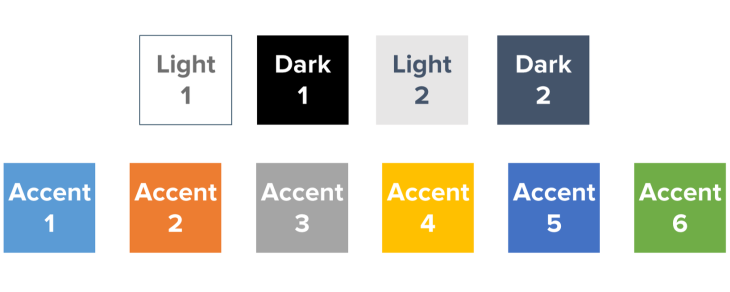
The order of the 10 colors is important. The order of the text and background colors defines what color will be used as the default text color and default background. Light 1 and Light 2 should always be light colors and Dark 1 and Dark 2 should always be dark colors. The text and background colors also define the automatic background styles available in PowerPoint. Good practice is to keep white and black among the first four text and background colors. You will most likely need to use white or black at one point when creating your PowerPoint, so keeping them handy is a smart move. If another color than black is defined as a default color (maybe you are using a dark gray or a significant brand color as your text color (Dark 1)), make black the Dark 2 color to keep it accessible.
The order in which you add accent colors to the color template is equally important. The order they are added is the order in which PowerPoint will automatically use them in charts and smart arts. Most organizations set their main brand color as the Accent 1 color. However, when you use SmartArt, for some reason the Accent 1 color is not used. So if you do a lot of SmartArt and want the main brand color to be used, avoid setting it to Accent 1. Custom shapes and lines are automatically using the Accent 1 color. You can however change this if you don’t want to overuse your Accent 1 color.
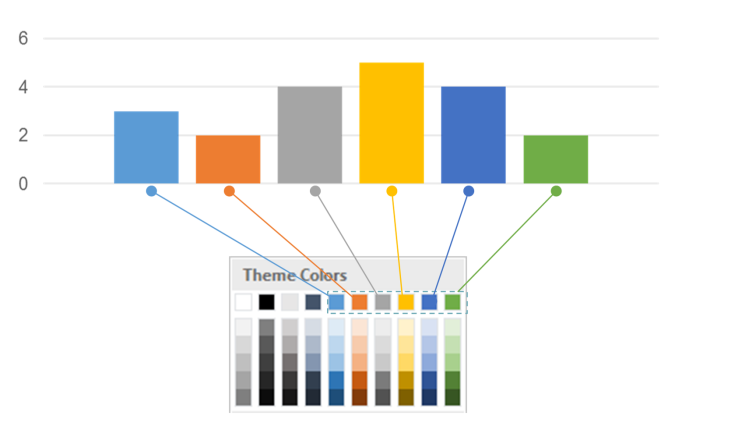
If you need more than six accent colors you can add custom colors to your color theme by adding them to the xml code or using an add-in ( this book is a great resource on how to add custom colors to PowerPoint).
PowerPoint automatically generates tints and shades for the 10 colors. You cannot control how the tints or shades are defined, but you can adjust them by using the HSL color settings to alter the RGB code (this is a link to a great article on how to do this). Sometimes the automatically generated tints (color + white) can be too “neonish”.
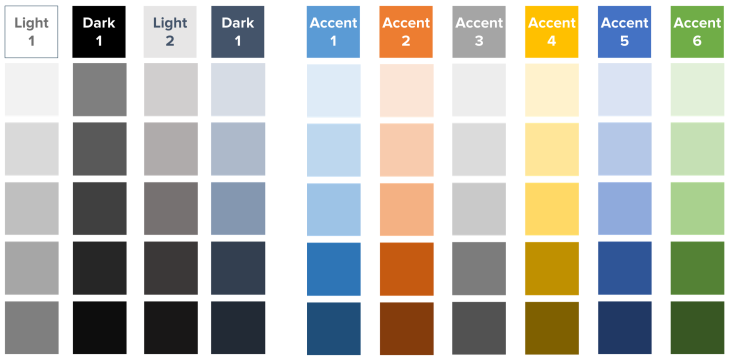
How to add colors to PowerPoint?
So knowing the basics of a PowerPoint color theme, how do you add your own colors to PowerPoint to be used in your next deck? Here are three ways of adding colors:
1 Use the standard color palette
PowerPoint’s built-in standard color palette gives you 127 colors, plus white, black, and shades of gray to choose from (to read more about combining colors, read this article ).
2 Use the RGB color model
PowerPoint uses the RGB model to define colors (as PowerPoint was designed to be shown on a screen). Each RGB color has three values, each ranging from 0-255, where BLACK is 0-0-0 and WHITE is 255-255-255. By adding RGB numbers into PowerPoint, you can add your own colors.
3 Use the HSL color model
You can also create colors in PowerPoint using the HSL model. The HSL model is available under the custom dialog box. Using the HSL model you can create colors by defining the hue, saturation and luminosity of a color.
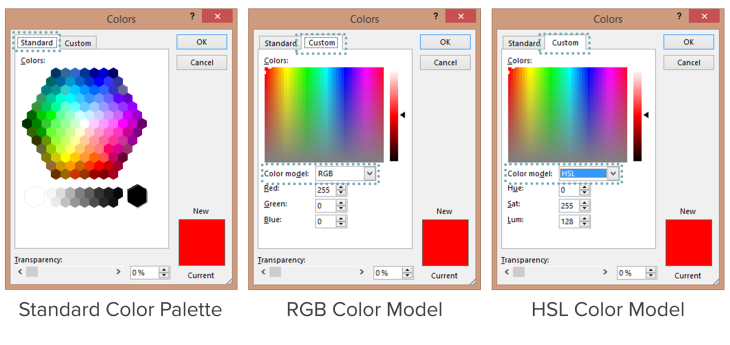
Click here to read more about the color models.
How to add and save a custom PowerPoint color theme?
Once you have your colors you need to define them as theme colors. You need your four text and background colors and six accent colors. You also need to define the colors for hyperlinks and visited hyperlinks.
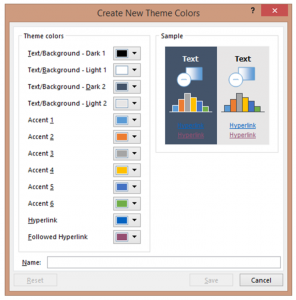
- Open the Customize Colors dialogue box clicking on the “Design Tab”, “Variants menu”, “Colors drop-down arrow” and then go all the way down to “Customize Colors… “
- Define each color in the color theme by using the drop down boxes for each of the ten + hyperlink colors (using one of the three methods for adding colors described previously).
- Name your new color theme and save.
Your color theme is now saved as a custom color theme (an .xml file) locally on your computer. It will be available in the colors menu as a custom color theme throughout Office (PowerPoint, Word and Excel) and you can apply this color theme whenever your want. The colors will “travel” with your file, so anyone opening it will see the colors you defined. If you save your PowerPoint as a theme/template, the color theme be saved with the theme/template as well.
Need more accent colors quickly?
You can add custom colors to a color theme ( contact Presentitude if you want help with adding custom colors)- but if you quickly want to use more accent colors, here are four quick ways to use your six accent colors in multiple ways.
1. Use automatically generated tints & shades
Use the already defined tints and shades of your accent colors. PowerPoint will give you five tints and hues for each color.

2 Use the custom RGB color settings
Use the RGB color settings to quickly generate your own tints and shades by adding white or black to a hue. Click on Custom colors in the Colors dialog box and Drag the tint/shade arrow up for a tint and down for a shade.

Use the HSL color settings to create more colors by adjusting the hue, saturation and luminosity. Click on Custom colors in the Colors dialog box and choose the HSL color model. Move the cross hair horizontally to create a new hue, vertically to create a new color by adjusting saturation. Move the vertical bar up (add white) or down (add black) to add or decrease luminosity to a color.

4 Use the transparency bar
Use the transparency function to add a transparent white or black object on top of a hue.

What if I want an even faster way to create a color theme?
If you don’t have time to create a color theme, PowerPoint has a number of built-in color themes. You apply these color themes via the Design Tab, Variants menu, and the Colors Drop-down.
Click here to get an overview of all built-in color themes in PowerPoint 2007, 2010, 2011, 2013 and 2016.
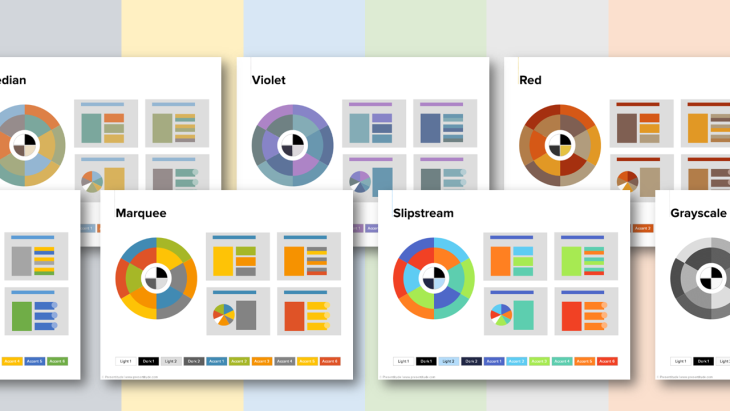
What if my favorite colors or brand colors are HEX or CMYK?
PowerPoint can only handle RGB codes (and HSL codes, but those are not as widely used when it comes to defining hues). If your brandbook defines colors as CMYK or if your web guidelines use HEX, you need to convert them to RGB. There are multiple services online that can help you with this – just Google.
Click here to read more about the relationship between HEX, CMYK, RGB and HSL.
Quick summary
A quick summary of how to create your own color theme for PowerPoint:
1. Define 6 accent colors in RGB 2. Define 2 light + 2 dark colors for text & background in RGB 3. Define hyperlink colors in RGB 4. Add color theme to PowerPoint using Design Tab 5. Name and apply color theme 6. Use shades and tints to create more colors
Read the other parts in our Colors for PowerPoint series:
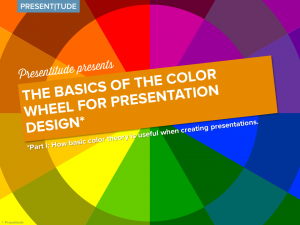
See this post as a SlideShare presentation
Leave a reply cancel reply.
Your email address will not be published. Required fields are marked *
How can we help you today?
Do you want to know more about our services, stay in touch or get access to content?
30+ Stylish PowerPoint Color Schemes 2024
Color is an element that can make or break a design, and that rule holds true for presentation design as well. Choosing the right PowerPoint color scheme is super important.
But there’s one extra thing to consider – where your presentation will be given. A PowerPoint presentation can look quite different on a computer or tablet versus on a projected screen.
When it comes to selecting a PowerPoint color scheme, this is an important consideration. We’ve rounded nearly stylish PowerPoint color schemes as inspiration. While darker color schemes might look great close-up on screens, opt for lighter backgrounds (for enhanced readability) for projected presentations.
Note: The last color in each scheme is for the slide background.
2 Million+ PowerPoint Templates, Themes, Graphics + More
Download thousands of PowerPoint templates, and many other design elements, with a monthly Envato Elements membership. It starts at $16 per month, and gives you unlimited access to a growing library of over 2,000,000 presentation templates, fonts, photos, graphics, and more.

Mystify Presentation

Minimal PPT Templates
Clean & clear.

Modern PPT Templates
New & innovative.

Ciri Template

Pitch PowerPoint

Business PPT Templates
Corporate & pro.
Explore PowerPoint Templates
1. Blue, Gray Green & Orange

With a bright overall scheme that’s easy on the eyes, this color scheme can help you create a modern PowerPoint presentation that’s readable and friendly. You can even tweak the colors somewhat to better work with your brand, if necessary.
The best thing about this color palette is that it lends itself to plenty of different presentation styles and applications.
2. Violet Gradient
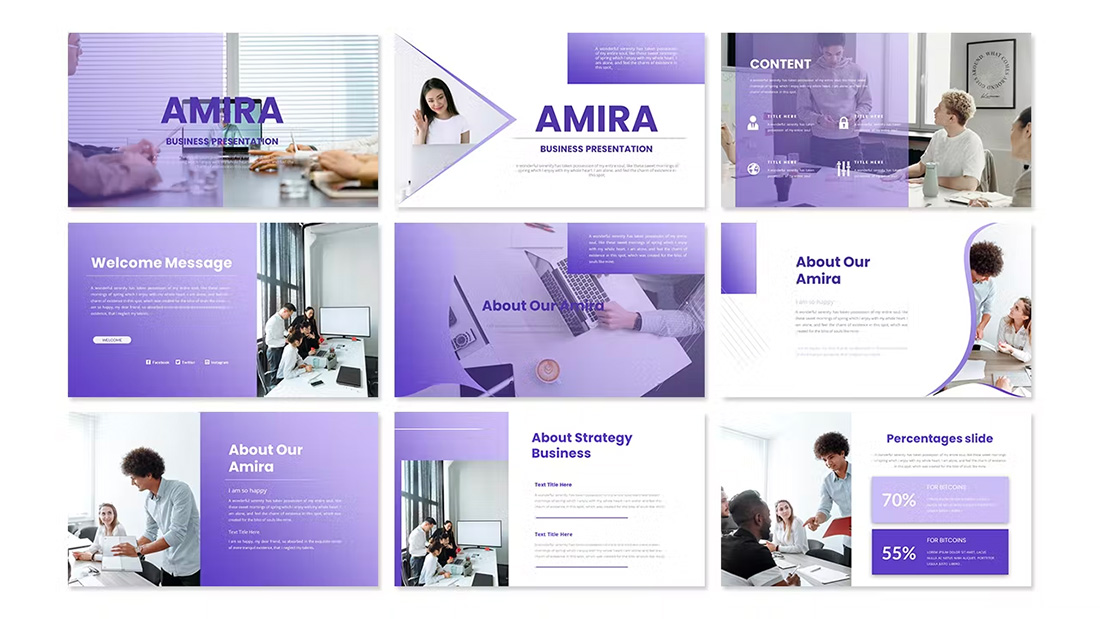
Using the first two colors noted above, you can create a dark-to-light monotone gradient that can make for a modern PowerPoint design style.
Take this concept and expand it to any other colors you like for your spin on this modern color scheme.
3. Mint and Orange

On paper, these colors don’t seem to blend all that well, but with the right application min and orange on a black background can work.
Use a pair of colors like this for presentations where you are trying to make a bold statement or impact. This concept is often great for trendy topics or ideas that are a little unconventional.
4. Bright Blue and Light
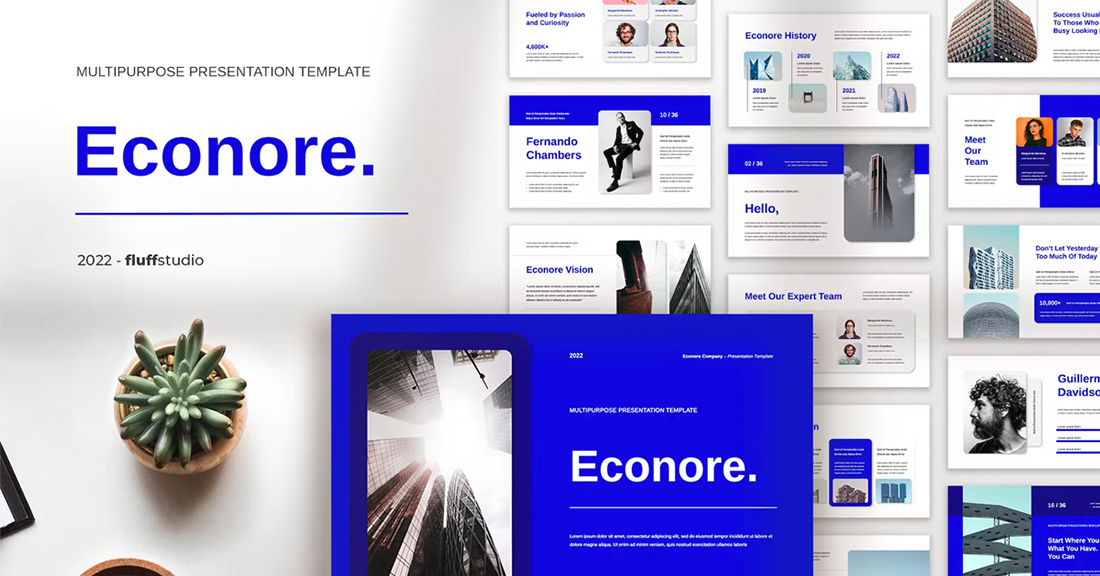
The brighter, the better! Bright blue color schemes are a major trend in PowerPoint design … and for good reason. The color combination creates a bright, light feel with easy readability. Those are two things that pretty much everyone wants in a presentation template design.
The other thing that’s great about a color scheme like this – which focuses on one color – is that it matches practically everything else in the design with ease. It’s great for image-heavy presentations or those where text elements are a key focal point.
5. Teal and Lime

Two colors that you might not expect to see paired create a classy combo that’s interesting and engaging. Both teal and lime are considered “new neutrals” and work with a variety of colors easily. (What’s somewhat unexpected is putting them together.)
What’s great about this PowerPoint color scheme is that the extra interest from the hues can help generate extra attention for slides. The template in the example also mixes and matches teal and green primary color blocks to keep it interesting from slide to slide.
6. Colorful Gradients

Gradients are a color trend that just keeps reinventing and resurfacing. In the latest iteration, gradients are bright with a lot of color. Designers are working across the color wheel for gradients that have more of a rainbow effect throughout the design, even if individual gradients are more subtle.
What you are likely to see is a variety of different gradients throughout a project with different colors, but maybe a dominant color to carry the theme. Use this for presentation designs that are meant to be more fun, lighter, and highly engaging.
7. Light Blue Minimal

This color scheme with light blue and a minimal aesthetic is super trendy and so easy to read. You can add a lot of style with a black-and-white style for images or a deep blue accent for header text.
While a pale blue is ideal here, you could also consider experimenting with other pastels and the same overall theme for a modern presentation design.
8. Bright with Dark Background

The combination of bright colors on a dark background can be fun and quite different from the traditional PowerPoint color schemes that are often on white or light backgrounds. This design style for a presentation is bold and engaging but can be a challenge if you aren’t comfortable with that much color.
When you use a style like this, it is important to think about the presentation environment to ensure that everything will look as intended. A design like this, for example, can work well on screens, but not as well on a projector or in a large room.
9. Navy and Orange

The navy and orange color combination is stylish and classic for presentation design. To add a fresh touch consider some of the effects such as the template above, with color blocking and overlays to add extra interest.
What makes this color combination pop is the element of contrast between a dark and a bright pair. The navy here is almost a neutral hue and works with almost any other design element.
10. Dark and Light Green
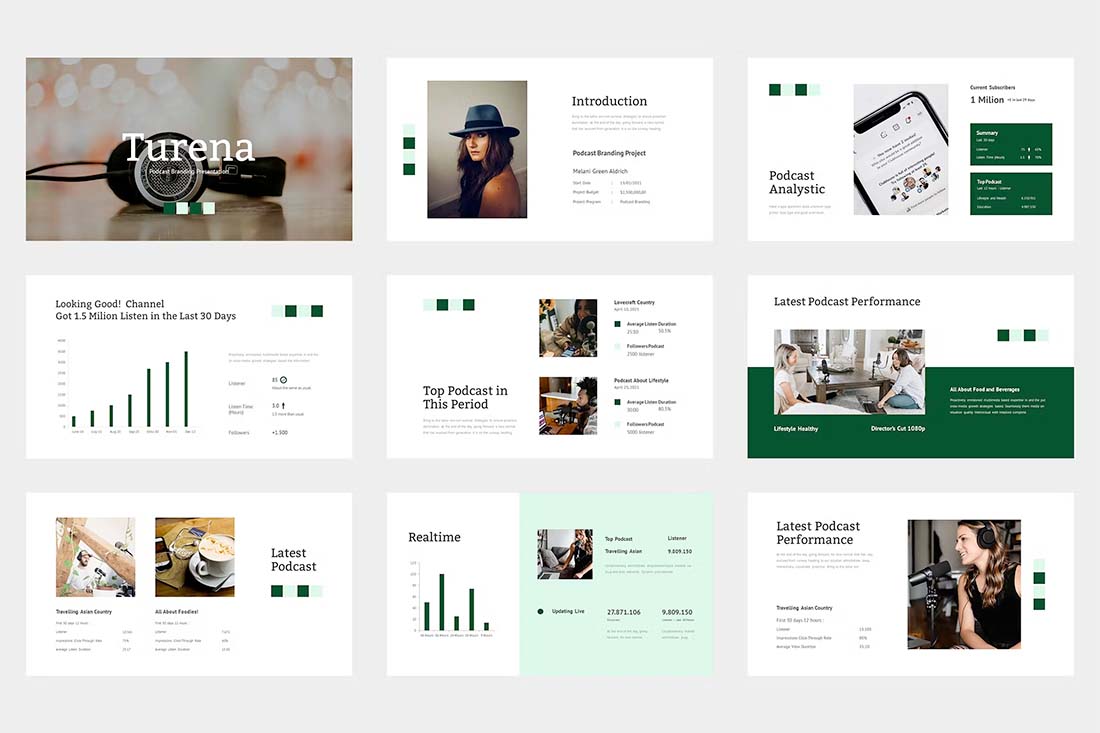
A modern take on a monotone color scheme involves using two similar colors that aren’t exactly tints and tones of one another. This pairing of dark green and light (almost minty) green does precisely that.
What’s nice about this color scheme is that the colors can be used almost interchangeably as primary elements or accents. It provides a lot of flexibility in the presentation design.
11. Bright Crystal Blue
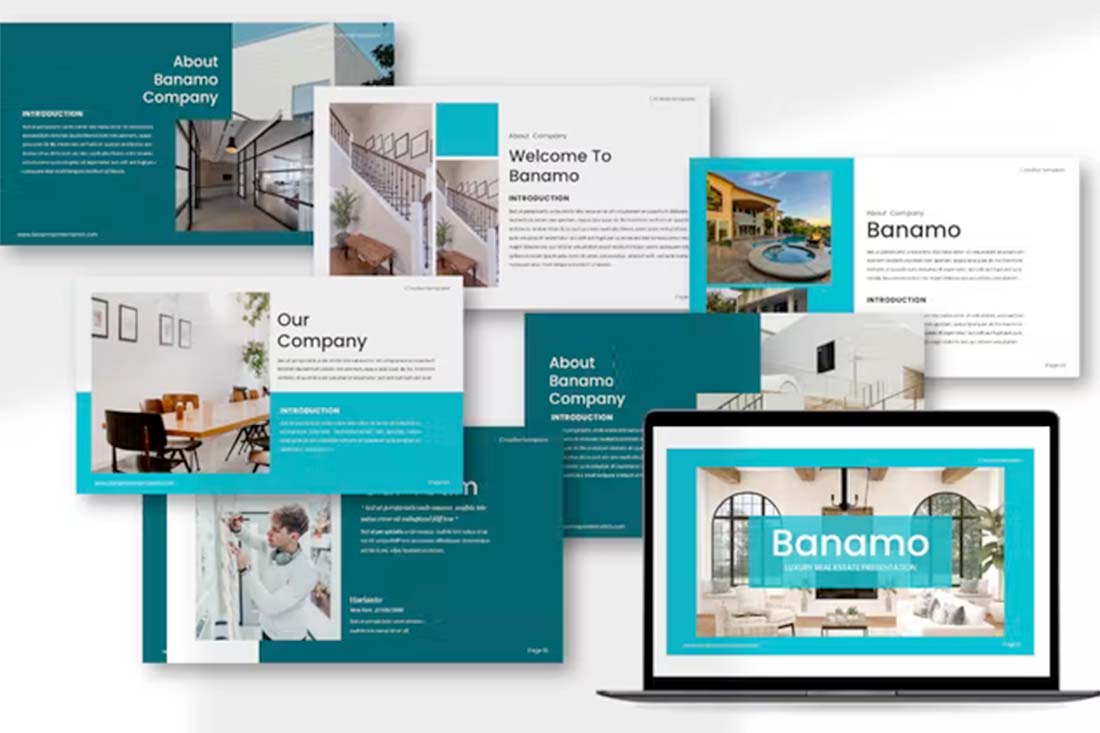
Blue presentation color schemes will always be in style. The only thing that changes is the variance of the hue. This pair of blues – a bright crystal blue with a darker teal – works in almost the same way as the pair of greens above.
What’s nice about this color palette though is that the dark color is the accent here. That’s a modern twist on color design for presentations.
12. Blue and Yellow

Blue and yellow are classic pairings and can make for a striking presentation color combination. With a bright white background, these hues stand out in a major way.
What works here is the element of contrast. A darker blue with a brighter yellow creates an almost yin and yang effect with color. The only real caution is to take care with yellow on a white or light background with fonts or other light elements.

Teal is a personality-packed color choice. If you are looking for a bold statement with a PowerPoint template, start here.
While the above color scheme also includes a hint of yellow for accents, the teal color option is strong enough to stand alone. You could consider a tint or tone for a mono-look. It also pairs amazingly well with black-and-white images.
Teal is a fun color option that will provide a lot of practical use with your slide deck.
14. Bright Coral
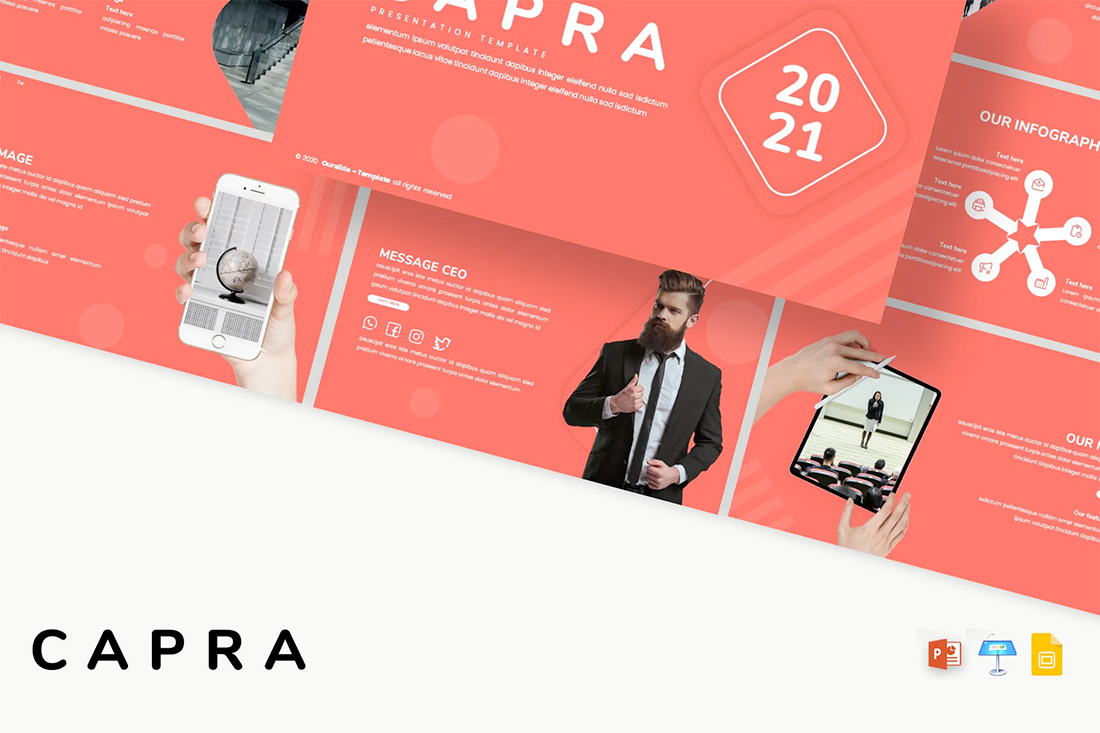
This color scheme is one of those that you will either love or hate. The bright coral color is powerful and generates an immediate reaction.
It’s also quite trendy and will stand out from many of the other more bland PowerPoint colors that you may encounter. This is a great option for a startup that wants to present with a bang or a brand that has a similar color in its palette. It may not work so well for more traditional brands or those that are more conservative with their slide designs.
15. Dark Mode Colors

A dark mode color scheme might be the biggest trend in all of design right now, and that also applies to presentation design.
This purple and emerald color paired with black with white text looks amazing. It is sleek, modern, and has high visual appeal without having to use a lot of images.
This works best for digital presentations when you don’t have concerns about room lighting to worry about.
If you aren’t ready to jump into dark mode on your own, the Harber template above is a great start with nice color, gradients, and interesting shapes throughout the slide types.
16. Navy and Lime

A navy and lime combination is a modern take on colorful neutrals that are anything but boring.
These colors have a nice balance with a white or light background and are fairly easy to use. With so many brands already using blue in their base color palette, this is an option that works and is an extension of existing elements for many brands. (Use your blue and add the lime to it.)
Also, with this color combination, the idea of a minimal overall slide structure is nice so that the power of the colors and impact comes through. They work beside images in full color or black and white.
17. Modern Blue

When you aren’t planning to use brand colors – or maybe as a startup or independent contractor so you don’t have them yet – a modern color combination can add the right flair to a PowerPoint presentation.
The bright grayish-blue in the Lekro PowerPoint template – you can find it here – adds the right amount of color without overwhelming the content. Plus, subtle orange accents help guide the eye throughout this PowerPoint color scheme. https://elements.envato.com/lekro-powerpoint-presentation-67YW3M
18. Blackish and Yellow

While at first pass, black and yellow might seem like a harsh color combination, it can set the tone for a project that should emanate strength. This PowerPoint color scheme softens the harshness of the duo with a blackish color, that’s grayer and has a softer feel.
Pair this combo on a light background or with black and white images for a stylish, mod look.
19. Orange and White

A bright color can soften the harshness of a stark PowerPoint design. Especially when used for larger portions of the content area, such as background swatches or to help accent particular elements.
The Sprint template makes great use of color with a simple palette – orange and white with black text – but has slide ideas that incorporate the color throughout for something with a more “designed” look to it. (And if you aren’t a fan of the orange, change the color for use with this template to keep the modern feel.)
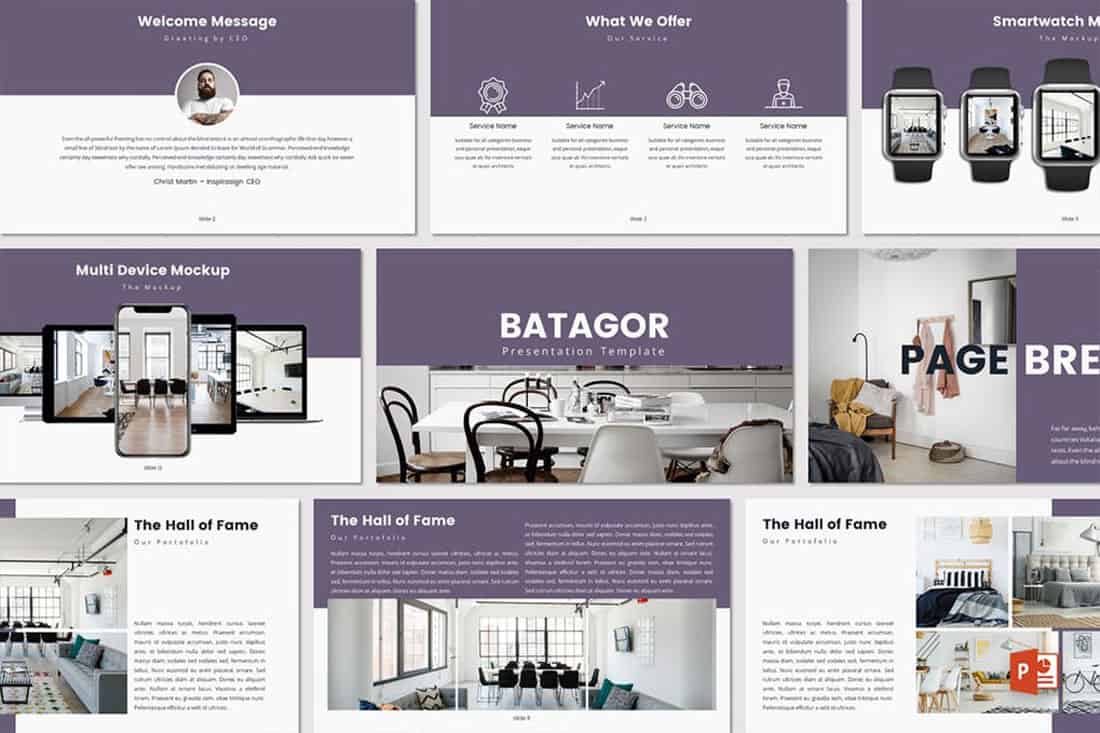
Purple presentations are in. The color, which was once avoided by many in design projects, has flourished with recent color trends.
Because more funky, bright colors are popular, a presentation with a purple focus can be acceptable for a variety of uses. The use in Batagor template has a modern design with a deep header in the featured color, which works best with images that aren’t incredibly bold in terms of color.
21. Blue-Green Gradients

Another trending item in color is the use of gradients. This trend can be applied to PowerPOint presentations as well.
Use a blue-to-green gradient for a soft and harmonious color scheme that won’t get in the way of content. Use each hue alone for accents and informational divots throughout the presentation design.
22. Black and White

Minimalism is a design trend that never goes away. A black-and-white (or gray) presentation screams class and sophistication.
It can also be easy to work with when you don’t want the color to get in the way of your message. And if a design can stand alone without color, you know it works.
23. Reds and Black

If you are designing a presentation for viewing on screens, such as desktops or tablets, a dark background with bright color accents and white text can work well. (This combination gets a lot trickier on projector displays.)
While reverse text and red aren’t always recommended, you can see from the Nova template that they can be a stunning combination. But note, this modern color scheme is best for specific content and audiences.
24. Blue and Pink

This color scheme is a spin on Pantone’s colors of the year from 2016. https://designshack.net/articles/graphics/how-to-use-the-pantone-color-of-the-year-in-design-projects/ The brighter, bolder versions of rose quartz and serenity and fun and sophisticated.
The unexpected combo sets the tone with a strong, trustworthy blue and adds softness with the paler pink. The colors work equally well with white or darker backgrounds.
25. Blue and Green

Blue and green accents can help a black or white background come to life in a presentation template. The colors here can work with either background style, based on how you plan to display your presentation.
What’s nice about these colors is that they are pretty neutral – since both are found in nature – and can be used with ease for design or text elements in a PowerPoint color scheme.
26. Beige and Gray
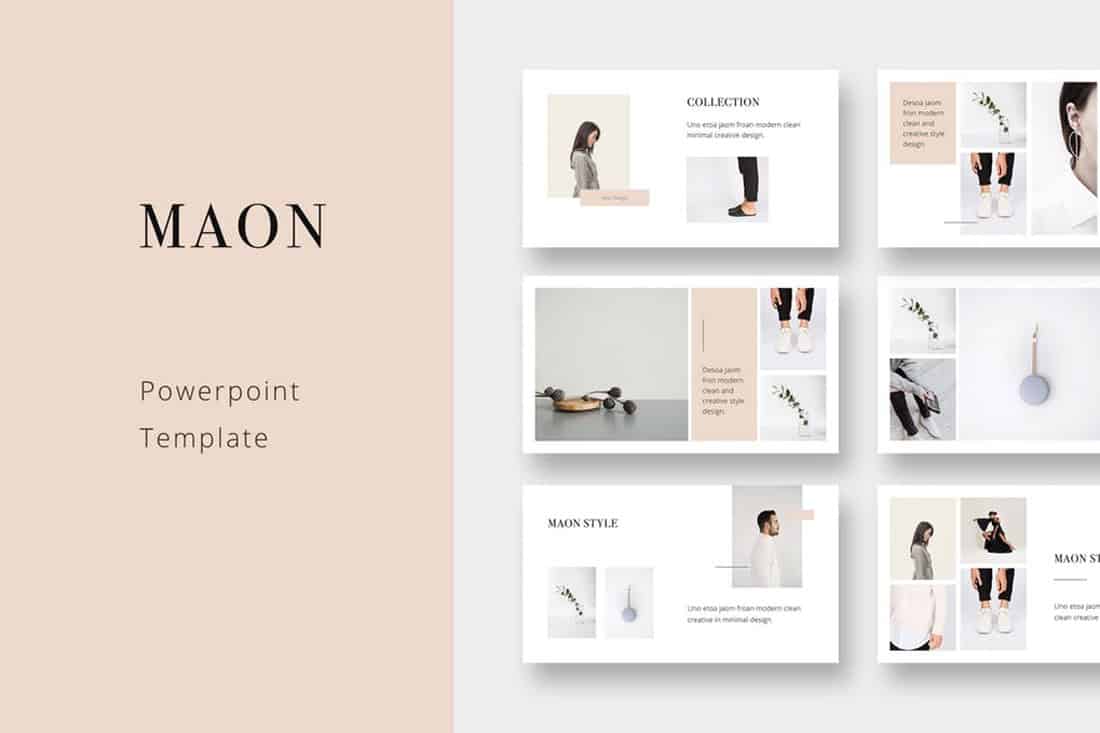
If you are looking for a softer color palette, consider beige and gray. These hues can work well on screens or projected, making them a versatile option.
The nice thing about such a neutral palette is that it gives content plenty of room, so that will be the true focus of the presentation.
27. Tints and Tones
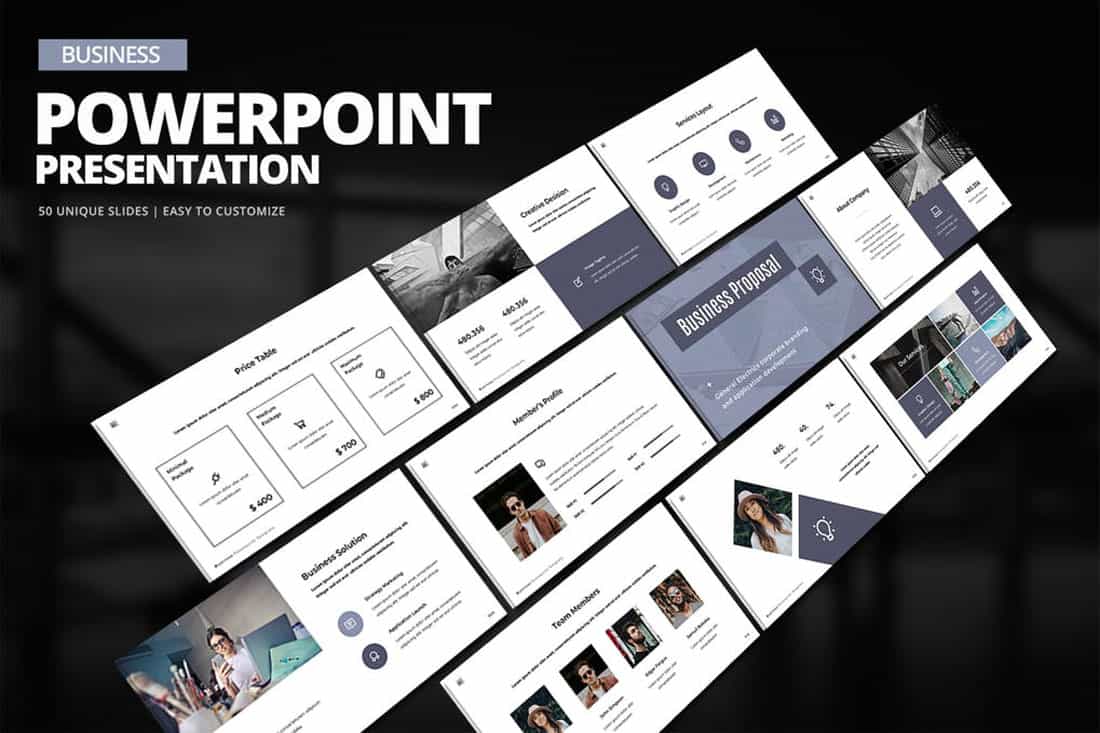
While the purplish blue-gray in the Business PowerPoint Presentation template is stunning, it represents a greater trend in presentation design. Pick a color – maybe your dominant brand color – and use tints and tones for the presentation color scheme.
By mixing the color with white or black and gray, you’ll end up with a stunning set of color variations that match your messaging.
28. Bold Rainbow
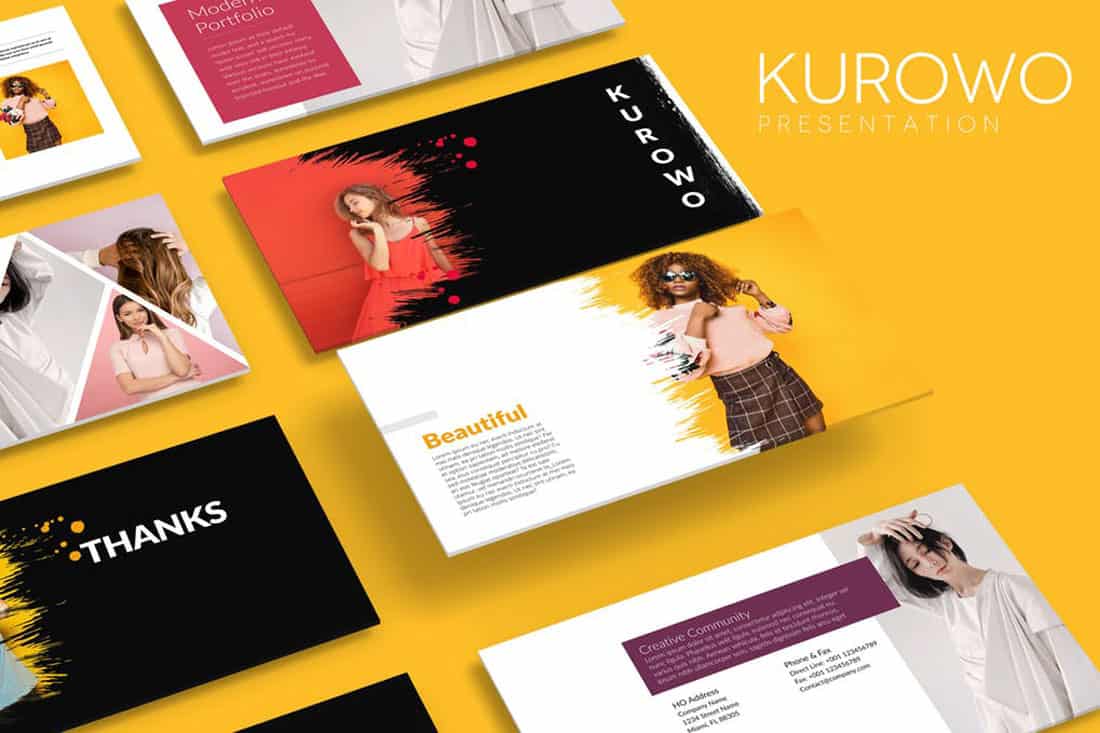
While most of the color schemes featured here only include a color or two, bright color schemes with wider color variations are trending.
This distinct “rainbow style” can be somewhat difficult to use without rules for each color. Proceed with caution.
29. Bright Neutrals

Lime green is the brightest “neutral” you might ever use. A fun palette that’s versatile can be a solid foundation for a color palette.
It works exceptionally well in the Rouka PowerPoint template thanks to a pairing with a subtle gray background. Using a light, but not white, background can be great for screens and projected presentations because it takes away some of the harshness of a white background. The subtle coloring is easier on the eyes for reading and viewing.
30. Rich Browns

Browns aren’t often what comes to mind when thinking of building a color scheme, but rich browns can be a modern option.
Pair a neutral beige-brown with a darker color for an interesting contrast that works with almost any style of content.
31. Mint Green

Go super trendy with a modern and streamlined palette of mint green and gray on white. While this combination can have a minimal feel, it also adds a touch of funkiness to the design.
Add another hint of color – think orange – for extra accents.
32. Dark Gray and Blue

It doesn’t get more classy than a combination of grays and blues. This new take on a classic color scheme adds another brighter blue as well to pick up on modern trends.
Just be careful with text using a dark background such as this one. White is probably your best option for typography (and look for a font with thicker strokes!)
- Palette Generator
- Explore Palettes
- Image Picker
- Contrast Checker
- List of Fonts New
- Other tools
- List of colors New
- Browse Gradients
- Create a Gradient
- Make a Gradient Palette
- Color Picker
- Collage Maker
- Image Converter
- Android App
- Figma Plugin
- Chrome Extension
- Instagram Page
It seems we can’t find any results based on your search.
You're all set!
We updated our Terms and Privacy . Please read them and accept to continue.
- You can save up to 10 palettes
- You can have only 1 project and 1 collection
- You can save up to 5 colors to favorites
- Remove ads and popups to enter the heaven of colors
- Generate palettes with more than 5 colors automatically or with color theory rules
- Save unlimited palettes , colors and gradients, and organize them in projects and collections
- Explore more than 10 million color schemes perfect for any project
- Pro Profile , a new beautiful page to present yourself and showcase your palettes, projects and collections
- Get advanced PDF export options like shades, hues, color blindness, etc.
- Unlock additional tools like the new Palette Visualizer to check your colors on real designs
- Support me as an indie developer
- And more...

Coolors Adobe Extension
Before you cancel your subscription, please share with me what made you cancel today. Your honest feedback will help me improve a lot! Thanks.
Allow the ads
Hey, I'm Fabrizio, the guy behind this website. Please help me to keep most of the site free by allowing ads or consider subscribing to enjoy even more features. Your support truly matters.
I don't care, close popup
- Transition Guide (Opens in new window)
- Subscribe Now (Opens in new window)
- Your Military
- Army Times (Opens in new window)
- Navy Times (Opens in new window)
- Air Force Times (Opens in new window)
- Marine Corps Times (Opens in new window)
- Pentagon & Congress
- Defense News (Opens in new window)
- Israel-Palestine
- Extremism & Disinformation
- Afghanistan
- Benefits Guide (Opens in new window)
- Family Life
- Military Pay Center
- Military Retirement
- Military Benefits
- Discount Depot
- Gear Scout (Opens in new window)
- Military Culture
- Military Fitness
- Military Movies & Video Games
- Military Sports
- Pay It Forward (Opens in new window)
- Military History
- Salute to Veterans
- Black Military History
- Congressional Veterans Caucus (Opens in new window)
- Military Appreciation Month
- Vietnam Vets & Rolling Thunder
- Service Members of the Year (Opens in new window)
- World War I
- Honor the Fallen (Opens in new window)
- Hall of Valor (Opens in new window)
- Create an Obituary (Opens in new window)
- Medals & Misfires
- Installation Guide (Opens in new window)
- Battle Bracket
- America's Military
- Task Force Violent
- CFC Givers Guide
- Newsletters (Opens in new window)
- Early Bird Brief
- MCON (Opens in new window)
- Long-Term Care Partners
- Navy Federal
First Look — 'Erased: WWII's Heroes of Color'
A four-part docuseries executive produced and narrated by idris elba that uncovers the long-lost legacies of soldiers of color during world war ii., latest videos.
SOF Week highlights and AI-driven fighter jets | Defense News Weekly Full Episode 5.11.24
Financial Tips for Transitioning from Military to Civilian Life — Money Minute
MH-6 Little Bird’s future and Special Operations Forces aviation updates
Are extreme-range sniper rifles coming to special operations?
Want a higher education degree after service? Follow these tips
Highlights: Service Members of the Year 2024 awards
What tech and gear to special ops troops want? A roundup from SOF Week
Long range undersea drone can recharge its own batteries
Secretary of the Air Force flies in AI-driven fighter jet
With insurgents pouring over a wall in Afghanistan, this Sgt. took them on with only his pistol
New thermal optics and more at Modern Day Marine 2024 | Defense News Weekly Full Episode 5.4.24
How can I start prepping for upcoming school year expenses? — Money Minute
Thermal / red dot combo on display at Modern Day Marine
Could an enemy hijack your GPS signal? Only if you don’t defend it
Want to go alone? Check out this private field toilet
Trending now.
LATEST OSCARS NEWS
Follow the oscars:.


4 Paint Colors You Should Never Use In A Dining Room, According To Designers
The pros are sharing paint colors to avoid using in your dining room to create a warm and inviting space.
Given that paint can truly make or break a room, it’s important to take a thoughtful approach to selecting a hue for any space within your home. Wondering whether any colors are ever an absolute no-no? When it comes to the dining room specifically, interior designers share several paint colors that they would recommend avoiding entirely.
Related: 5 Things That Make Your Dining Room Look Dated, According To Southern Designers
Opting for white walls is often a no-brainer, but Zandy Gammons, the founder of Miretta Interiors in Raleigh, North Carolina, urges clients to think outside the box in the dining room. “We like to think about colors and patterns that would spur conversation and excitement,” she says. “Since the dining room is almost always used for entertaining, at the very least it should have some form of texture on the walls with a splash of color. Save the white walls for large, open spaces!”
Hallie Henley Sims agrees. “The dining room is a space that is meant to be enjoyed by all of the five senses: taste, smell, sight, touch, and sound,” comments the founder of Hallie Henley Design in Houston, Texas. “Please don’t leave the walls bare white!”
While this hue may charm some, Rachel Cannon, the founder of Rachel Cannon Limited in Baton Rouge, Louisiana, considers it “too institutional.” Cathleen Gruver of Purcellville, Virginia-based Gruver Cooley , isn’t a proponent of such shades, either. “I would avoid using cooler tones and stark colors, as they will make your room less cozy and may not encourage you and your guests to sit and spend time in the space,” she notes.
While some designers don’t love light colors, others will advise you to stay away from anything ultra bright, too. “I would never use neon colors,” says Becky Nielsen, the founder of Becky Nielsen Interiors in Nashville, Tennessee. “You want a space that feels welcoming and invites people to eat and stay to enjoy.”
Ginger Curtis, the founder of Urbanology Designs in North Richland Hills, Texas, also has strong feelings about neon. “Colors like neon or fluorescent shades can be too stimulating for a room meant for relaxation and conversation,” she says.
Dull Gray
Even if you’re drawn to neutrals, steer clear of gray in the dining room. “The wrong color gray can zap the room of energy and interest,” Curtis comments.
Last but not least, be mindful to not go overboard with color altogether in the dining room. “You can definitely have fun with it- but you don't want to give your guests a headache,” Gruver says. “Opt for an interesting piece of art instead—or a neutral combination of paint colors.”
For more Southern Living news, make sure to sign up for our newsletter!
Read the original article on Southern Living .

- Search Please fill out this field.
- Manage Your Subscription
- Give a Gift Subscription
- Newsletters
- Sweepstakes
4 Entryway Paint Colors to Make Your Home More Inviting
Welcome home!
Farrow & Ball
Looking to create an impactful design moment in your home? Why not start in your entryway? After all, first impressions are everything. "Entryways set the mood," says Ruth Mottershead, creative director for Little Greene . "They are a transitional space, often seen through open doorways or between other rooms, so they are the perfect host for versatile, sophisticated, and inviting tones that are easy to combine with a multitude of complementary colors and finishes,” she says.
Rather than treating these often purely functional spaces as an afterthought, she recommends integrating your entryway into the rest of your design scheme and going with a color that reflects your personal style.
Here are four of the best entryway paint colors that make a space feel more inviting and stylish.
Little Greene
Madeleine by Little Greene
Mottershead is a big fan of Madeleine , which is a new color from the brand’s recently launched Sweet Treats Collection. “‘The muted gold Madeleine is a sophisticated honey tone that delivers tranquility and warmth. A contemporary alternative to more traditional cream tones, Madeleine is gentle, yet deliciously sweet,” she says.
This hue has a yellow base that’s grounded by a hint of brown, which she tells me creates a welcoming and comforting hue ideal for entryways.
Farrow and Ball
Yeabridge Green by Farrow and Ball
If you have a more traditional approach to design, Patrick O’Donnell, global grand ambassador for Farrow and Ball, advises painting your entryway Yeabridge Green . “There is nothing more generous than a great dollop of verdant green to greet you and your guests in your hall, and Yeabridge Green delivers this in spades! It’s a joyful, optimistic green which surprisingly acts as a great foil to pictures and brown furniture,” he says.
He recommends pairing this shade with a complementary white, such as James White , on trim. This off-white color has a slight green hue and a creamy quality to it.
Lute by Little Greene
On the other hand, if you’re looking for a dark, modern hue that still feels inviting, Mottershead suggests going with Lute . This is a fantastic choice for anyone interested in giving their home a sense of continuity, because it easily helps create a transition from room to room. “Experiment with the softness of Lute on the walls, paired with the dark grey-green of Pompeian Ash with highlights of Slaked Lime , for a subtle yet interesting monochromatic scheme that works throughout the seasons.”
London Stone by Farrow and Ball
If your home has a more neutral aesthetic , London Stone is certainly worth considering for your entryway. “If too much color feels intimidating in your hall, seeking out the earth tones of something like London Stone will deliver neutrality without appearing bland,” says O’Donnell. “This warm mid-neutral will be your friend, whether you err towards limestone flooring or wood. Do pair it with a flattering white on your trim, moldings, and ceiling. Our red-blushed Dimity will do the trick and create a space that is both calm and inviting.”
Related Articles
- Skip to main content
- Skip to FDA Search
- Skip to in this section menu
- Skip to footer links

The .gov means it’s official. Federal government websites often end in .gov or .mil. Before sharing sensitive information, make sure you're on a federal government site.
The site is secure. The https:// ensures that you are connecting to the official website and that any information you provide is encrypted and transmitted securely.
U.S. Food and Drug Administration
- Search
- Menu
- Advisory Committees
- Advisory Committee Calendar
- UPDATED PUBLIC PARTICIPATION INFORMATION: June 4, 2024: Meeting of the Psychopharmacologic Drugs Advisory Committee Meeting Announcement - 06/04/2024
Advisory Committee Meeting | Mixed
Event Title UPDATED PUBLIC PARTICIPATION INFORMATION: June 4, 2024: Meeting of the Psychopharmacologic Drugs Advisory Committee Meeting Announcement June 4, 2024
What is an advisory committee.
Advisory committees provide independent expert advice to the FDA on broad scientific topics or on certain products to help the agency make sound decisions based on the available science. Advisory committees make non-binding recommendations to the FDA, which generally follows the recommendations but is not legally bound to do so. Please see, " Advisory Committees Give FDA Critical Advice and the Public a Voice ," for more information.
UPDATED INFORMATION (as of May 15, 2024):
The public participation information has been changed for the June 4, 2024, meeting of the Psychopharmacologic Drugs Advisory Committee. The deadline for making formal oral presentation requests has been extended from Friday, May 17, 2024 to Tuesday, May 21, 2024 . The contact person will notify interested persons regarding their request to speak by May 22, 2024 .
All other information remains the same.
ORIGINAL INFORMATION:
Center: Center for Drug Evaluation and Research
Location: FDA and invited participants may attend the meeting at FDA White Oak Campus, 10903 New Hampshire Ave., Bldg. 31 Conference Center, the Great Room (Rm. 1503), Silver Spring, MD 20993-0002. The public will have the option to participate via an online teleconferencing and/or video conferencing platform, and the advisory committee meeting will be heard, viewed, captioned, and recorded through an online teleconferencing and/or video conferencing platform.
The meeting presentations will be heard, viewed, captioned, and recorded through an online teleconferencing and/or video conferencing platform. The Committee will discuss new drug application 215455, for midomafetamine (MDMA) capsules, submitted by Lykos Therapeutics, for the proposed indication of treatment of post-traumatic stress disorder. The Committee will be asked to discuss the overall benefit-risk profile of the product, including the potential public health impact.
Meeting Materials
FDA intends to make background material and the link to the live webcast available to the public no later than two (2) business days before the meeting in the Event Materials section of this web page. If FDA is unable to post the background material on its website prior to the meeting, the background material will be made publicly available on FDA’s website at the time of the advisory committee meeting. The meeting will include slide presentations with audio and video components to allow the presentation of materials for online participants in a manner that most closely resembles an in-person advisory committee meeting.
Public Participation Information
Interested persons may present data, information, or views, orally or in writing, on issues pending before the committee.
FDA is establishing a docket for public comment on this meeting. The docket number is FDA-2024-N-1938 . Please note that late, untimely filed comments will not be considered. The docket will close on June 3, 2024. The https://www.regulations.gov electronic filing system will accept comments until 11:59 p.m. Eastern Time at the end of June 3, 2024. Comments received by mail/hand delivery/courier (for written/paper submissions) will be considered timely if they are received on or before that date.
Comments received on or before May 23, 2024 will be provided to the Committee. Comments received after that date will be taken into consideration by FDA. In the event that the meeting is cancelled, FDA will continue to evaluate any relevant applications or information, and consider any comments submitted to the docket, as appropriate. You may submit comments as follows:
Electronic Submissions
Submit electronic comments in the following way:
- Federal eRulemaking Portal: https://www.regulations.gov . Follow the instructions for submitting comments. Comments submitted electronically, including attachments, to https://www.regulations.gov will be posted to the docket unchanged. Because your comment will be made public, you are solely responsible for ensuring that your comment does not include any confidential information that you or a third party may not wish to be posted, such as medical information, your or anyone else’s Social Security number, or confidential business information, such as a manufacturing process. Please note that if you include your name, contact information, or other information that identifies you in the body of your comments, that information will be posted on https://www.regulations.gov .
- If you want to submit a comment with confidential information that you do not wish to be made available to the public, submit the comment as a written/paper submission and in the manner detailed (see “Written/Paper Submissions” and “Instructions”).
Written/Paper Submissions
Submit written/paper submissions as follows:
- Mail/Hand delivery/Courier (for written/paper submissions): Dockets Management Staff (HFA-305), Food and Drug Administration, 5630 Fishers Lane, Rm. 1061, Rockville, MD 20852.
- For written/paper comments submitted to the Dockets Management Staff, FDA will post your comment, as well as any attachments, except for information submitted, marked and identified, as confidential, if submitted as detailed in “Instructions.”
Instructions: All submissions received must include the Docket No. FDA-2024-N-1938 for “Psychopharmacologic Drugs Advisory Committee; Notice of Meeting; Establishment of a Public Docket; Request for Comments-- midomafetamine (MDMA) capsules.” Received comments, those filed in a timely manner, will be placed in the docket and, except for those submitted as “Confidential Submissions,” publicly viewable at https://www.regulations.gov or at the Dockets Management Staff between 9 a.m. and 4 p.m., Monday through Friday, 240-402-7500.
- Confidential Submissions--To submit a comment with confidential information that you do not wish to be made publicly available, submit your comments only as a written/paper submission. You should submit two copies total. One copy will include the information you claim to be confidential with a heading or cover note that states “THIS DOCUMENT CONTAINS CONFIDENTIAL INFORMATION.” FDA will review this copy, including the claimed confidential information, in its consideration of comments. The second copy, which will have the claimed confidential information redacted/blacked out, will be available for public viewing and posted on https://www.regulations.gov . Submit both copies to the Dockets Management Staff. If you do not wish your name and contact information be made publicly available, you can provide this information on the cover sheet and not in the body of your comments and you must identify the information as “confidential.” Any information marked as “confidential” will not be disclosed except in accordance with 21 CFR 10.20 and other applicable disclosure law. For more information about FDA’s posting of comments to public dockets, see 80 FR 56469, September 18, 2015, or access the information at: https://www.gpo.gov/fdsys/pkg/FR-2015-09-18/pdf/2015-23389.pdf .
Docket: For access to the docket to read background documents or the electronic and written/paper comments received, go to https://www.regulations.gov and insert the docket number, found in brackets in the heading of this document, into the “Search” box and follow the prompts and/or go to the Dockets Management Staff, 5630 Fishers Lane, Rm. 1061, Rockville, MD 20852, 240-402-7500.
Oral Presentations
Oral presentations from the public will be scheduled between approximately 2 p.m. and 3.p.m Eastern Time and will take place entirely through an online meeting platform. Those individuals interested in making formal oral presentations should notify the contact person and submit a brief statement of the general nature of the evidence or arguments they wish to present, the names and addresses of proposed participants, and an indication of the approximate time requested to make their presentation on or before May 17, 2024.
Time allotted for each presentation may be limited. If the number of registrants requesting to speak is greater than can be reasonably accommodated during the scheduled open public hearing session, FDA may conduct a lottery to determine the speakers for the scheduled open public hearing session. The contact person will notify interested persons regarding their request to speak by May 20, 2024.
Webcast Information
CDER plans to provide a free of charge, live webcast of the upcoming advisory committee meeting. If there are instances where the webcast transmission is not successful, staff will work to re-establish the transmission as soon as possible. Further information regarding the webcast, including the web address for the webcast, will be made available no later than two (2) business days before the meeting in the Event Materials section of this web page.
CDER plans to post archived webcasts after the meeting, however, in cases where transmission was not successful, archived webcasts will not be available.
Contact Information
- Joyce Frimpong, PharmD Center for Drug Evaluation and Research Food and Drug Administration 10903 New Hampshire Avenue WO31-2417 Silver Spring, MD 20993-0002 Phone: 301-796-7973 Email: [email protected]
- FDA Advisory Committee Information Line 1-800-741-8138 (301-443-0572 in the Washington DC area) Please call the Information Line for up-to-date information on this meeting.
- For press inquiries, please contact the Office of Media Affairs at [email protected] or 301–796–4540.
A notice in the Federal Register about last minute modifications that impact a previously announced advisory committee meeting cannot always be published quickly enough to provide timely notice. Therefore, you should always check the agency’s website or call the committee’s Designated Federal Officer (see Contact Information) to learn about possible modifications before coming to the meeting.
Persons attending FDA’s advisory committee meetings are advised that the agency is not responsible for providing access to electrical outlets. FDA welcomes the attendance of the public at its advisory committee meetings and will make every effort to accommodate persons with disabilities. If you require accommodations due to a disability, please contact the committee’s Designated Federal Officer (see Contact Information) at least 7 days in advance of the meeting.
Answers to commonly asked questions including information regarding special accommodations due to a disability may be accessed at: Common Questions and Answers about FDA Advisory Committee Meetings .
FDA is committed to the orderly conduct of its advisory committee meetings. Please visit our Web site at Public Conduct During FDA Advisory Committee Meetings for procedures on public conduct during advisory committee meetings.
Notice of this meeting is given under the Federal Advisory Committee Act (5 U.S.C. app.2).

IMAGES
VIDEO
COMMENTS
Yellow. As with several of the colors above, we borrow our perception of yellow from nature. The sun, sunflowers, summer and golden plains — yellow occupies the place in our brain reserved for joy, optimism and fun.. If you want your presentation to have a warm, happy and upbeat feel, try making yellow your focus color, just make sure you choose an appropriate background color to make it pop ...
Pick your colors. 1. The dominant color. Firstly, we need to pick out the dominant color for your scheme. Whilst the black or white background of your presentation slides may feel like the most dominant hue, we can discount it. Black and white are neutral colors that combine with all other colors.
The tetradic color scheme defines a rectangle area where the four corners are the selected colors for the palette. It is one of the schemes that oughts to be used with extreme caution. ... contrasting presentation color palette. Opt for a black-themed presentation if you wish to transmit exclusivity, a VIP product or service for your audience ...
Yellow: This is the color of light. It is a stimulating color that conveys energy, awakes awareness and inspires creativity. You will surely find yellow in the food industry. Green: Undeniably, the color of nature, life and peace. This color conveys a sense of growth, balance and stability like no other.
Two to four colors is generally sufficient for a presentation. ... we can continue to learn new ways to leverage it as a tool to create more compelling presentations. Using color effectively is a ...
The additive colors are red, green, and blue, or RGB. The RGB color models are for electronic screens like computers or TVs. It begins with black and then adds red, green, and blue light to convey a spectrum of colors. When more colors are added, the result is lighter and closer to white.
It is recommended that three to four colors are sufficient for a presentation. Follow the 60-30-10 rule. The 60-30-10 rule is an interior design color scheme best practice, which adaptation to graphic design has become very popular. It states that the appropriate color proportion of a space (in this case the presentation canvas) should comply ...
That's one example of a principle that helps you create the best presentation color combinations. 2. Tints, Tones, and Hues. While the color wheel shows each of the colors at their "pure" form, we know that there are many other versions of a color. This comes down to aspects like tints, tones, and hues.
16. Dark with Splashes of Color. If you want a luxurious and ultra-modern color scheme, Black with splashes of color is just the ticket. The black creates a sleek and professional feel, whilst the bold and colorful highlights make the key information in your presentation pop.
Each of the primary colors can have a value in the range from 0 to 255. PowerPoint use the RGB model to show colors for presentations as these are supposedly created to be shown on a projector using light. ... The color red in all four color models. Read the other parts in our Colors for PowerPoint series: View this post as a slide presentation
4. The Best Color Palette to Appeal to Corporate Businesses. This color scheme gives a nod to the traditional palettes of the financial and legal world. Bottle green and cognac brown are teamed with dark racing-green and old gold for an established and luxurious effect.. Corporate presentations can be difficult to enliven, as they require a degree of formality and convention.
6. The "Logistics Company but Cooler" Combination. I'm going to say it - if you're a company that does logistics or you're a new map app, I've almost completed your new branding for you. That green and blue with those pinks, you're welcome. 7. The "This Presentation is Going to Win a Prize on Behance" Combination.
10. Spectrum of Colors. Many of the color schemes in this round-up use just a few simple colors to create attractive presentations. And while it's true that the best PowerPoint color schemes use a "less is more" mindset, sometimes you'll want to use more colors. That's where a template like Spectrum comes into play.
BROWN - A warm and earthy color. This color is generally associated with the Earth and more specifically wood. A light brown color with a discreet wood texture could be a great option if your presentation includes environmental elements. Besides, it suggests the idea of durability.
The Announcement. "Ladies and gentlemen, please rise for the presentation (and posting) of the colors.". Every time a color guard presents the colors, it's called a presentation. At a formal event, the colors may be placed in stands, that is posting. The colors will always be presented, just not always posted.
To put it simply, red is the opposite of green, blue is the opposite of orange and yellow is the opposite of purple. This gives you a noticeable contrast on your slides, allowing you to highlight certain parts of your presentation. Here is an example of the Spring Equinox. template, which uses blue and orange as complementary colors.
Pick your colors. 1. The dominant color. Firstly, we need to pick out the dominant color for your scheme. Whilst the black or white background of your presentation slides may feel like the most dominant hue, we can discount it. Black and white are neutral colors that combine with all other colors.
A quick summary of how to create your own color theme for PowerPoint: 1. Define 6 accent colors in RGB. 2. Define 2 light + 2 dark colors for text & background in RGB. 3. Define hyperlink colors in RGB. 4. Add color theme to PowerPoint using Design Tab.
This color scheme involves two to four colors that sit next to each other on the color wheel. Com-bine these shades and you get a soothing scheme, without the contrast that characterizes the previous two. SLIDESCARNIVAL.COM · HOW TO PICK THE BEST COLORS FOR YOUR PRESENTATION 2
Using the first two colors noted above, you can create a dark-to-light monotone gradient that can make for a modern PowerPoint design style. Take this concept and expand it to any other colors you like for your spin on this modern color scheme. 3. Mint and Orange. #21e9c5 #ff8513 #000000.
Light Background with Dark Text and Graphics. Background - warm beige. Text and Graphics - dark blue, black, dark purple. Accent Colors - dark green, burgundy. The beige background combines the emotional impact of brown and white without gaining too much of the negative effect of these colors such as boring and staid.
Save unlimited palettes, colors and gradients, and organize them in projects and collections. Explore more than 10 million color schemesperfect for any project. Pro Profile, a new beautiful page to present yourself and showcase your palettes, projects and collections. Get advanced PDF exportoptions like shades, hues, color blindness, etc.
Coming up with a color scheme—whether it's a new logo color scheme, colors to use inside of an infographic or a color palette for your upcoming presentation—is hard.While in many instanc ... Having four colors in your logo offers lots of freedom for how you use them in your branding. 37 Mozilla Firefox. Mozilla.
A four-part docuseries executive produced and narrated by Idris Elba that uncovers the long-lost legacies of soldiers of color during World War II.
Find Oscars 2024 news and blogs. Read news about the Academy Awards nominees, winners, red carpet, awards night predictions and more.
Related: 5 Things That Make Your Dining Room Look Dated, According To Southern Designers White. Opting for white walls is often a no-brainer, but Zandy Gammons, the founder of Miretta Interiors in ...
Here are four of the best entryway paint colors that make a space feel more inviting and stylish. ... "If too much color feels intimidating in your hall, seeking out the earth tones of something like London Stone will deliver neutrality without appearing bland," says O'Donnell. "This warm mid-neutral will be your friend, whether you err ...
The deadline for making formal oral presentation requests has been extended from Friday, May 17, 2024 to Tuesday, May 21, 2024. The contact person will notify interested persons regarding their ...
Torqued Up! 2024 Sierra AT4X Gets Duramax Diesel Power. Plus a new name for 2.7-liter turbo four, louder exhaust for the 6.2-liter V-8, and a pair of new colors and wheels.
Professional with a fresh touch color combination. If the topic of your presentation is meant to build trust or confidence, to calm your audience or to deliver important — perhaps serious — news, then blue is the color for you. The bright green color balances the palette, creating a fresh feel. Color codes: #6B90B2 · #1B558E · #CCD64D.